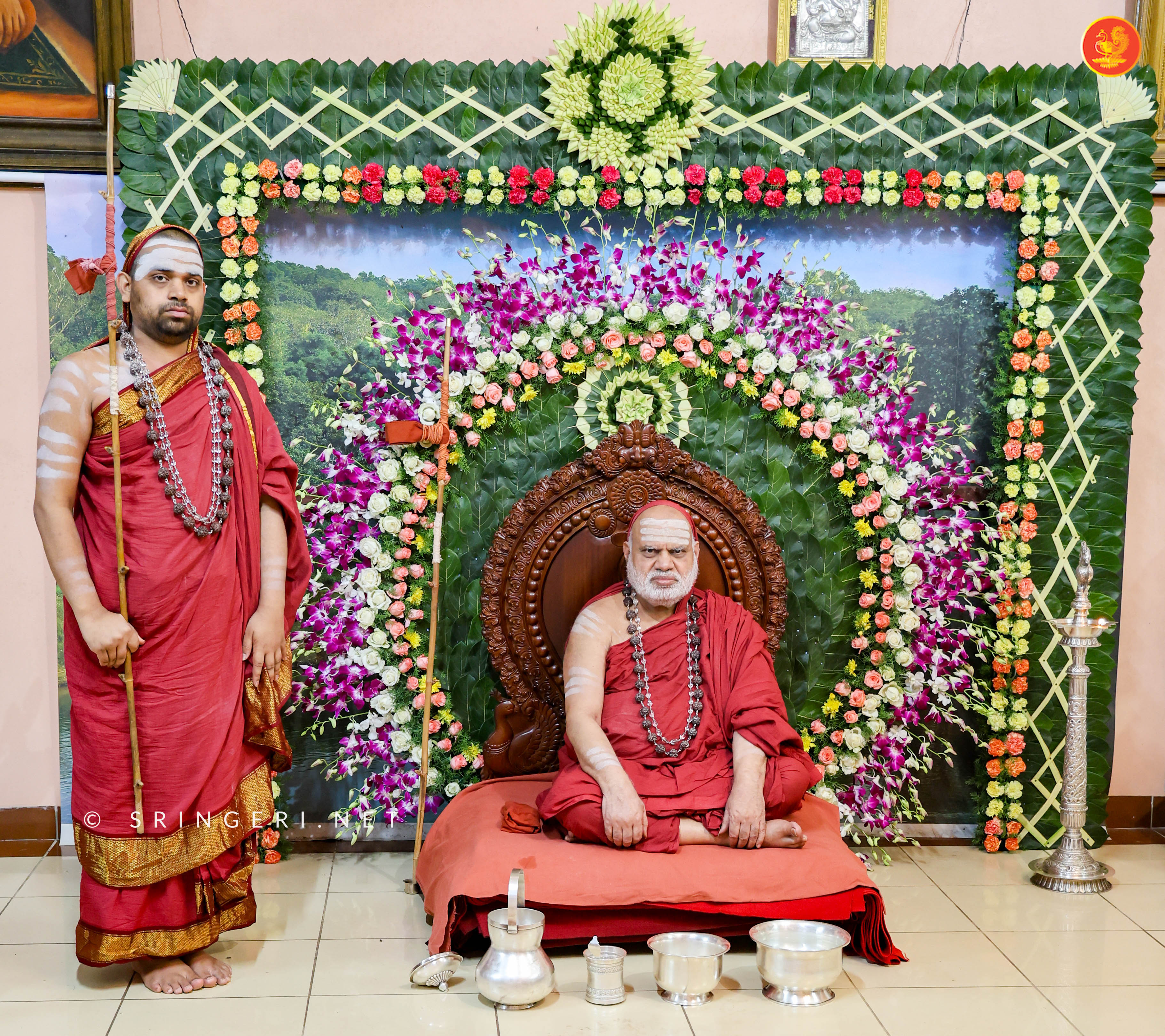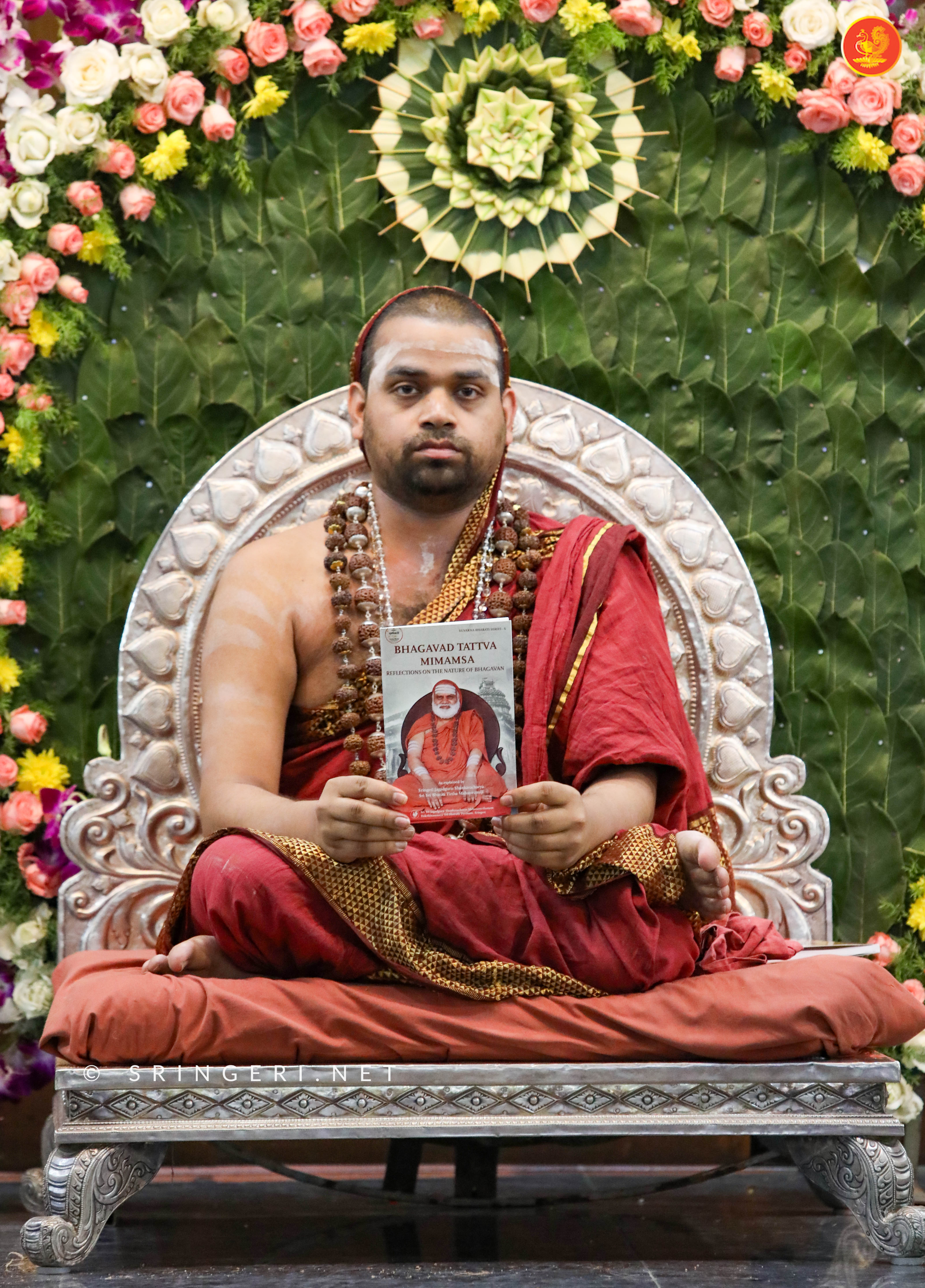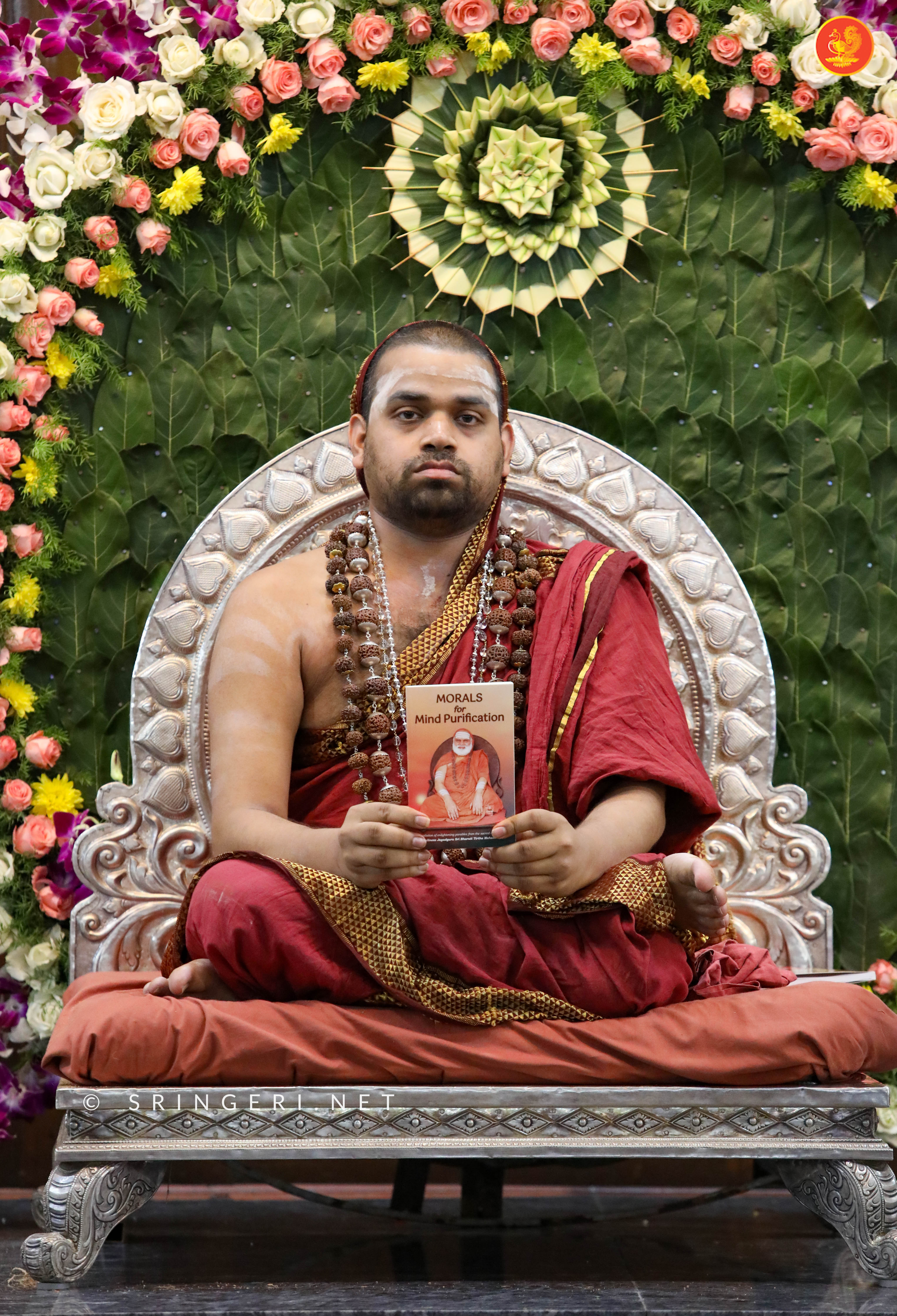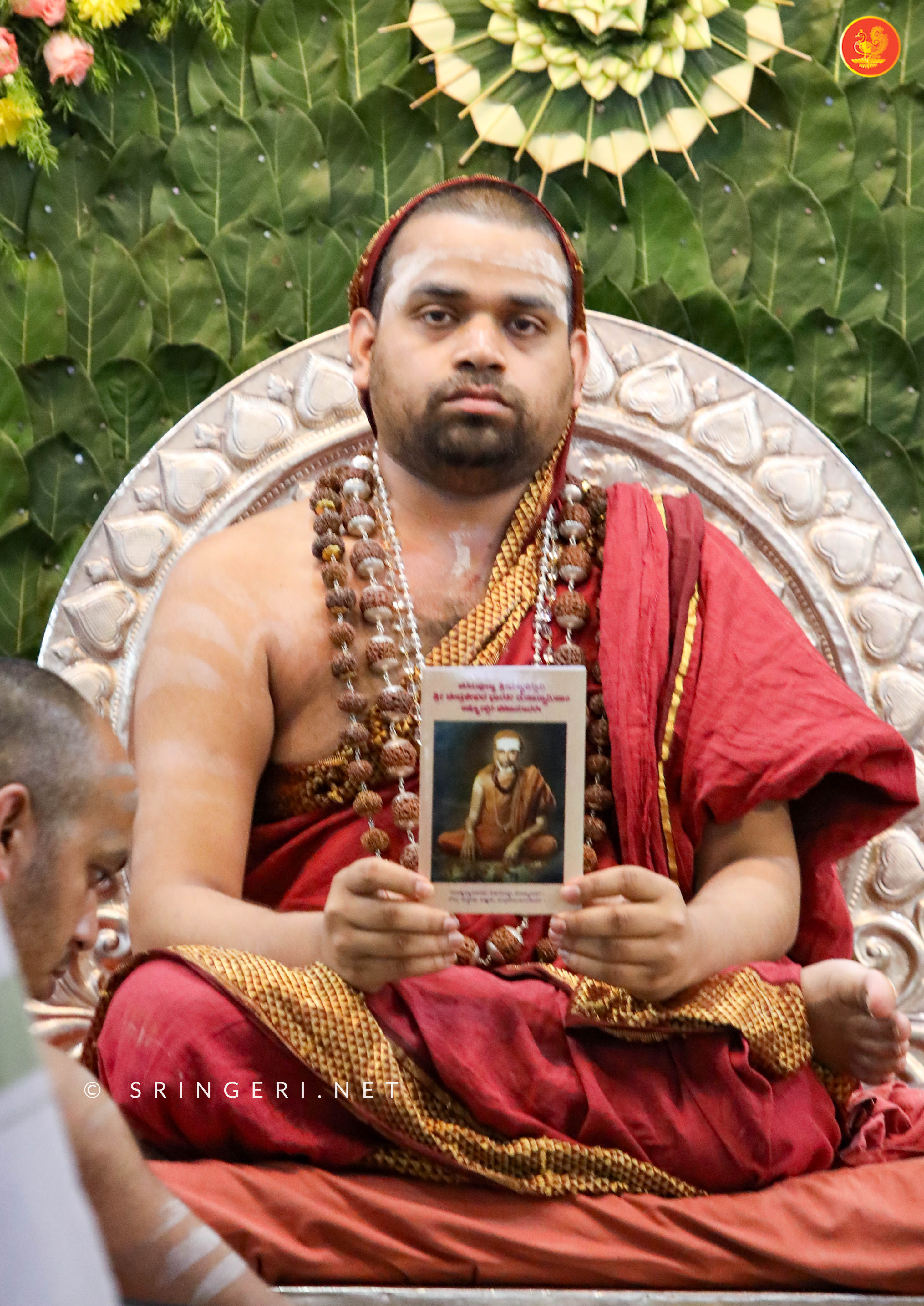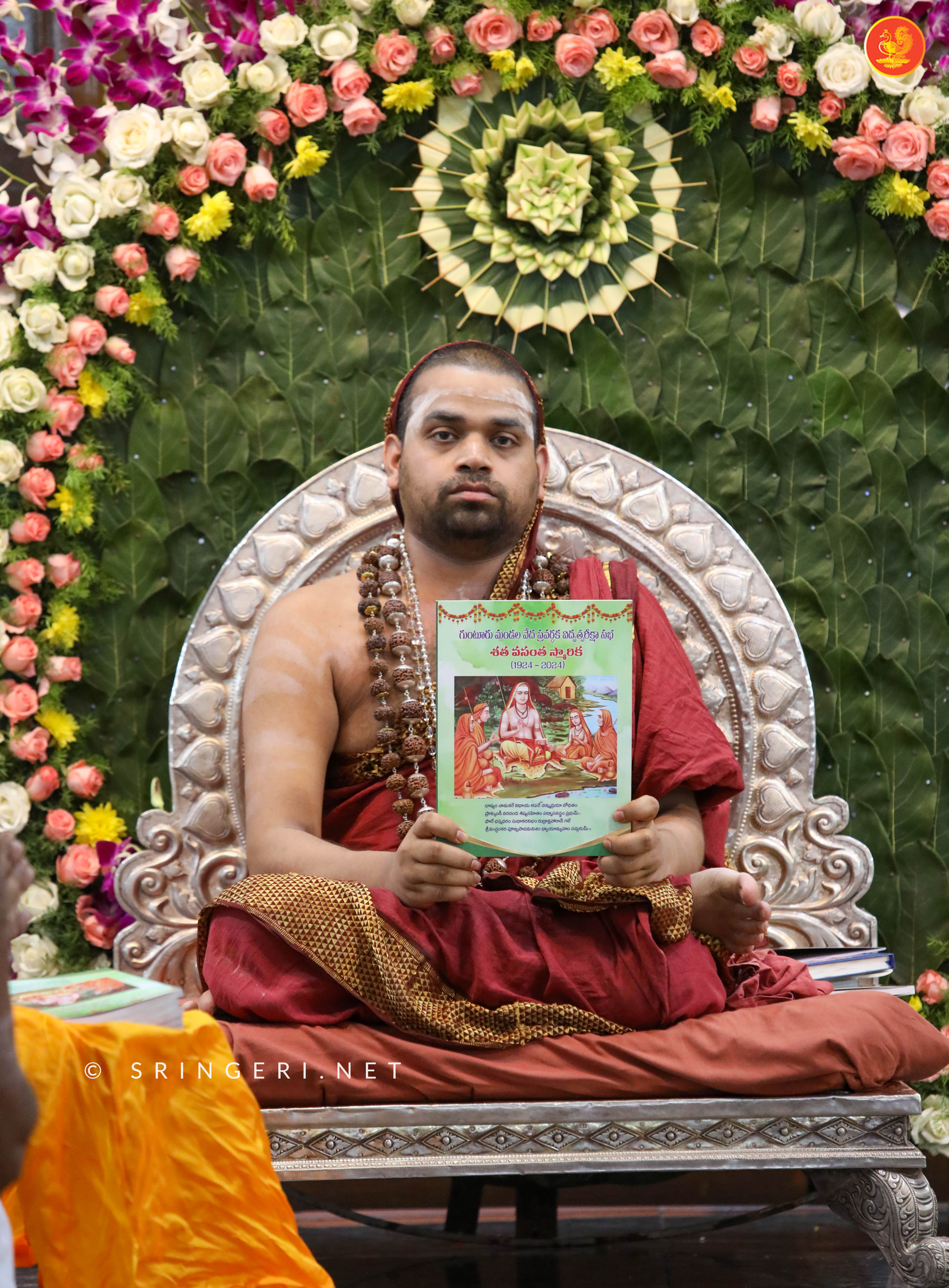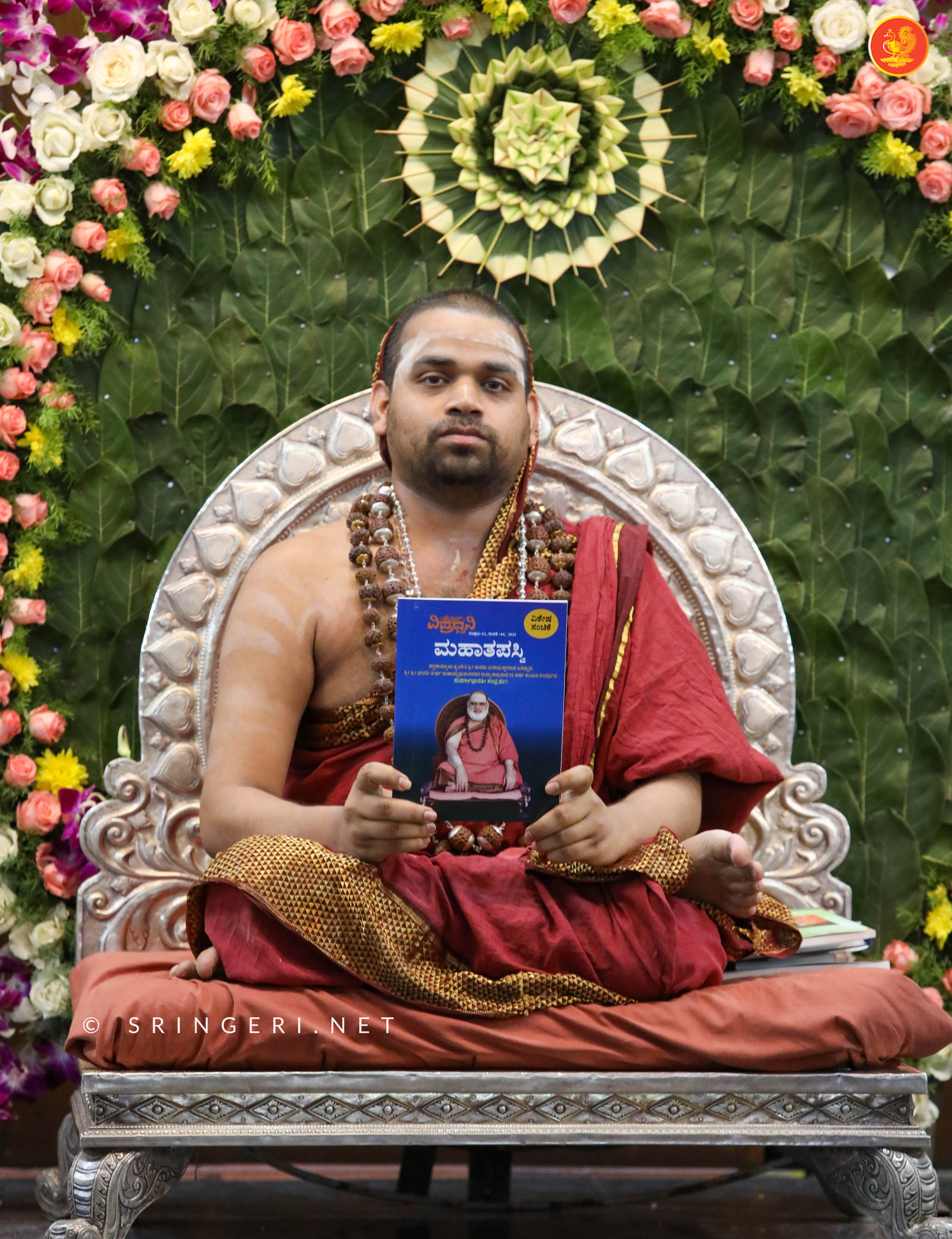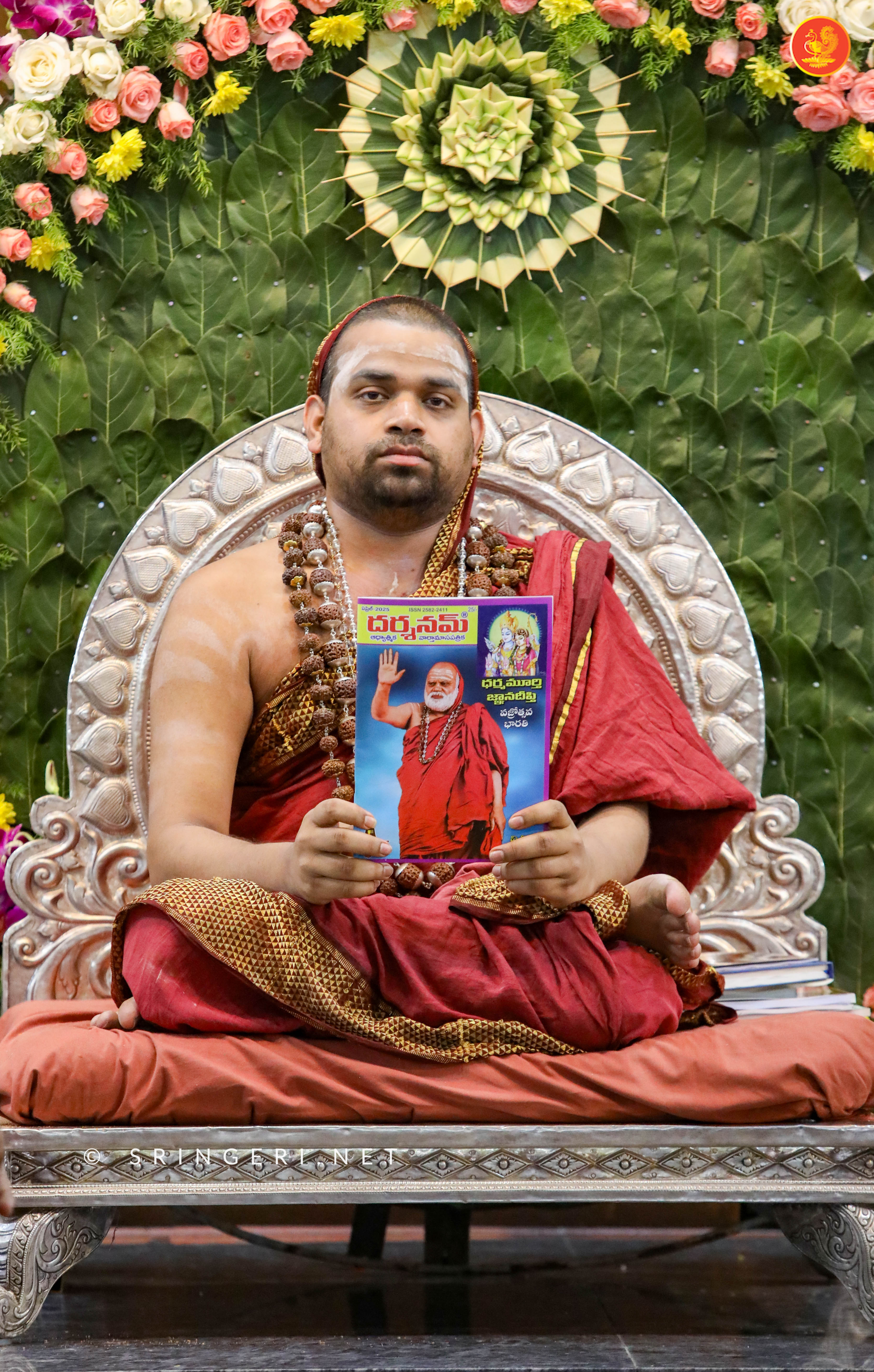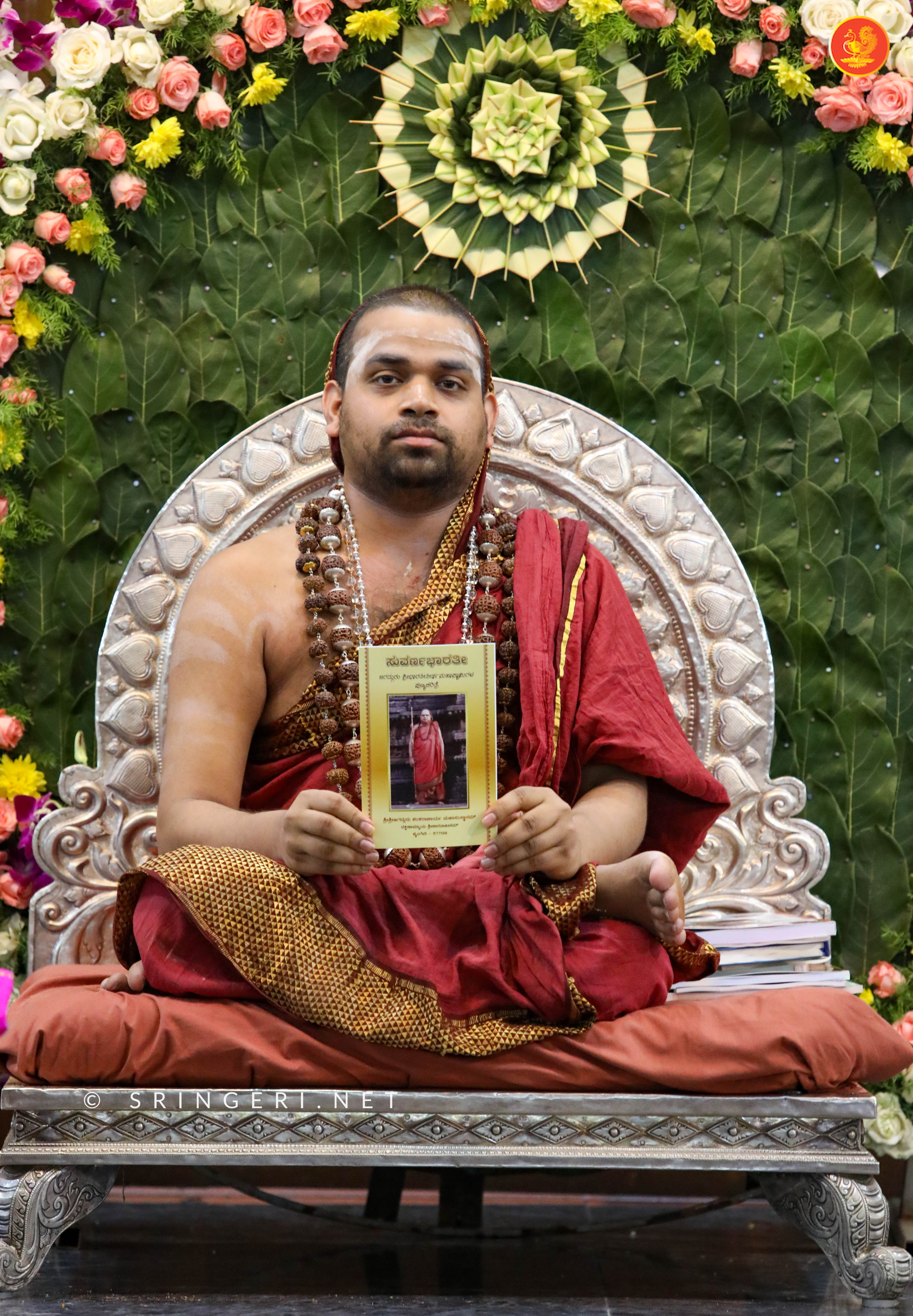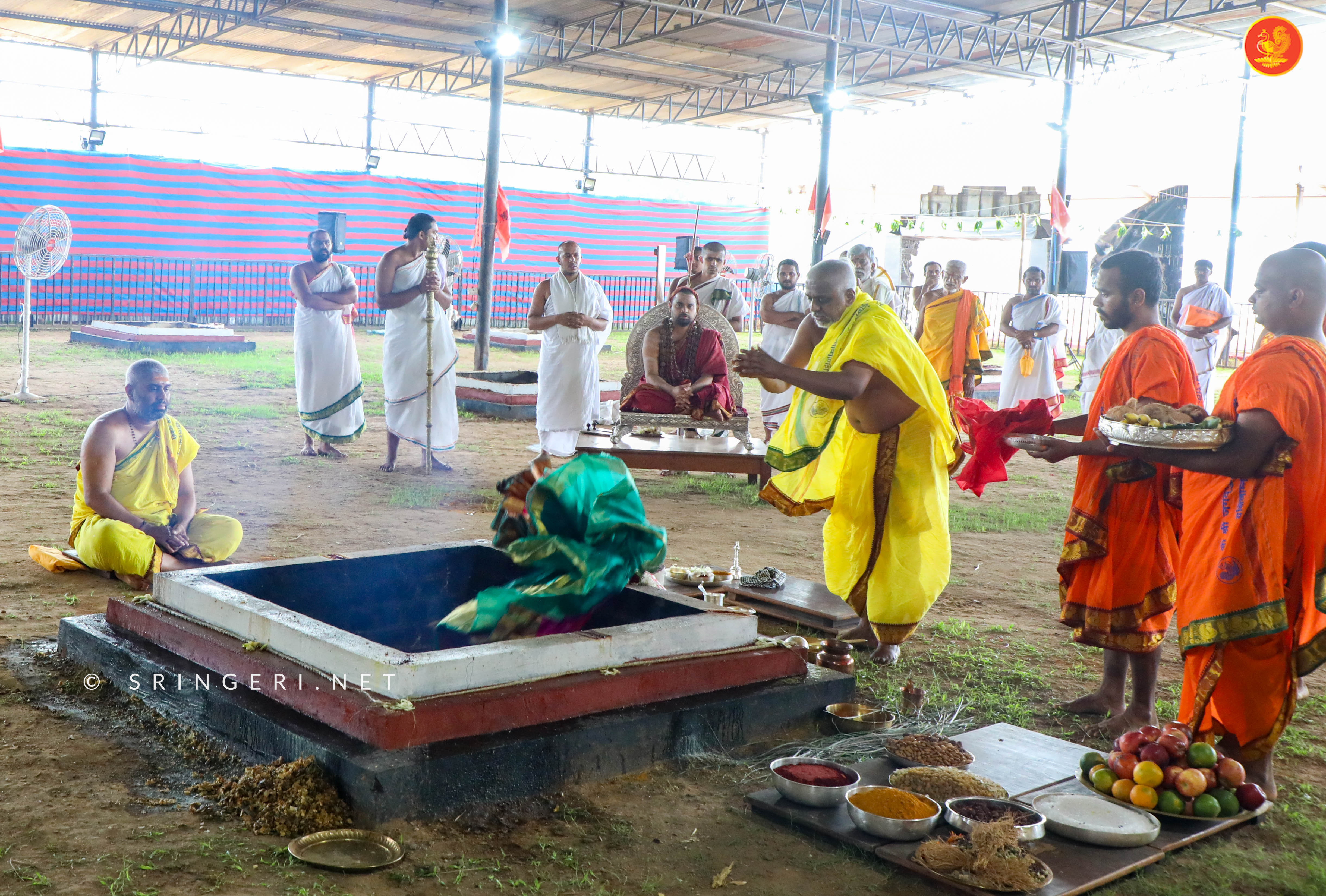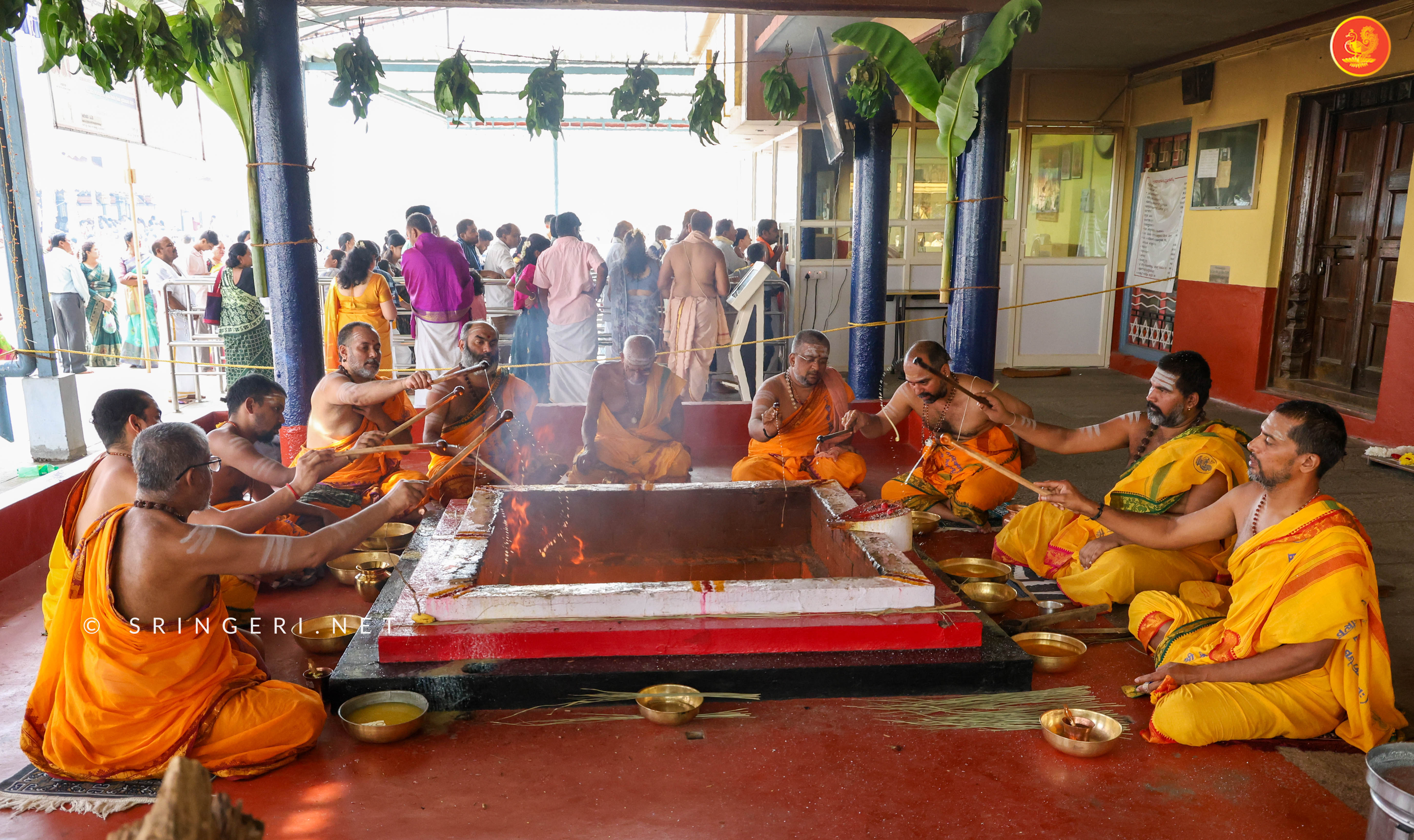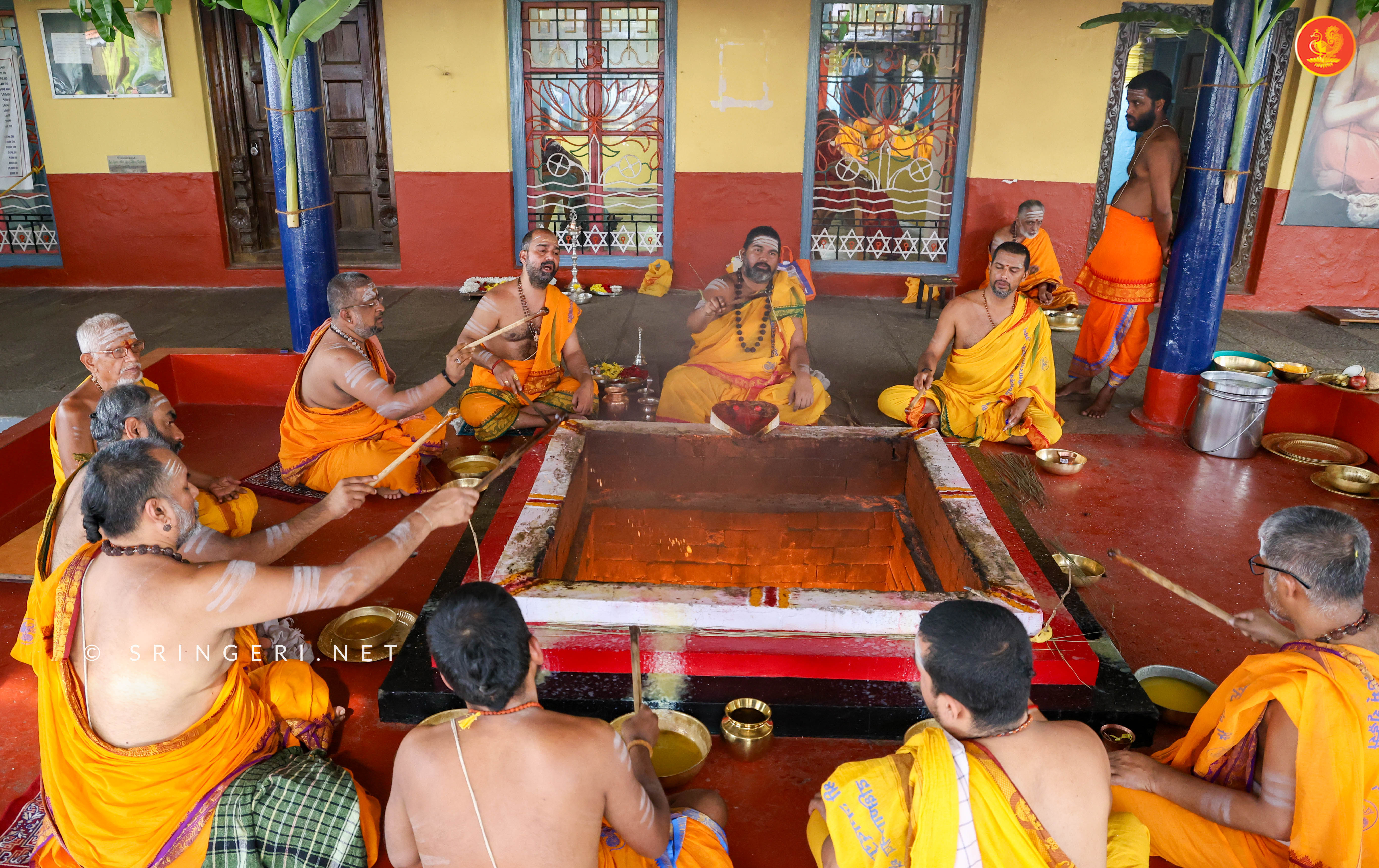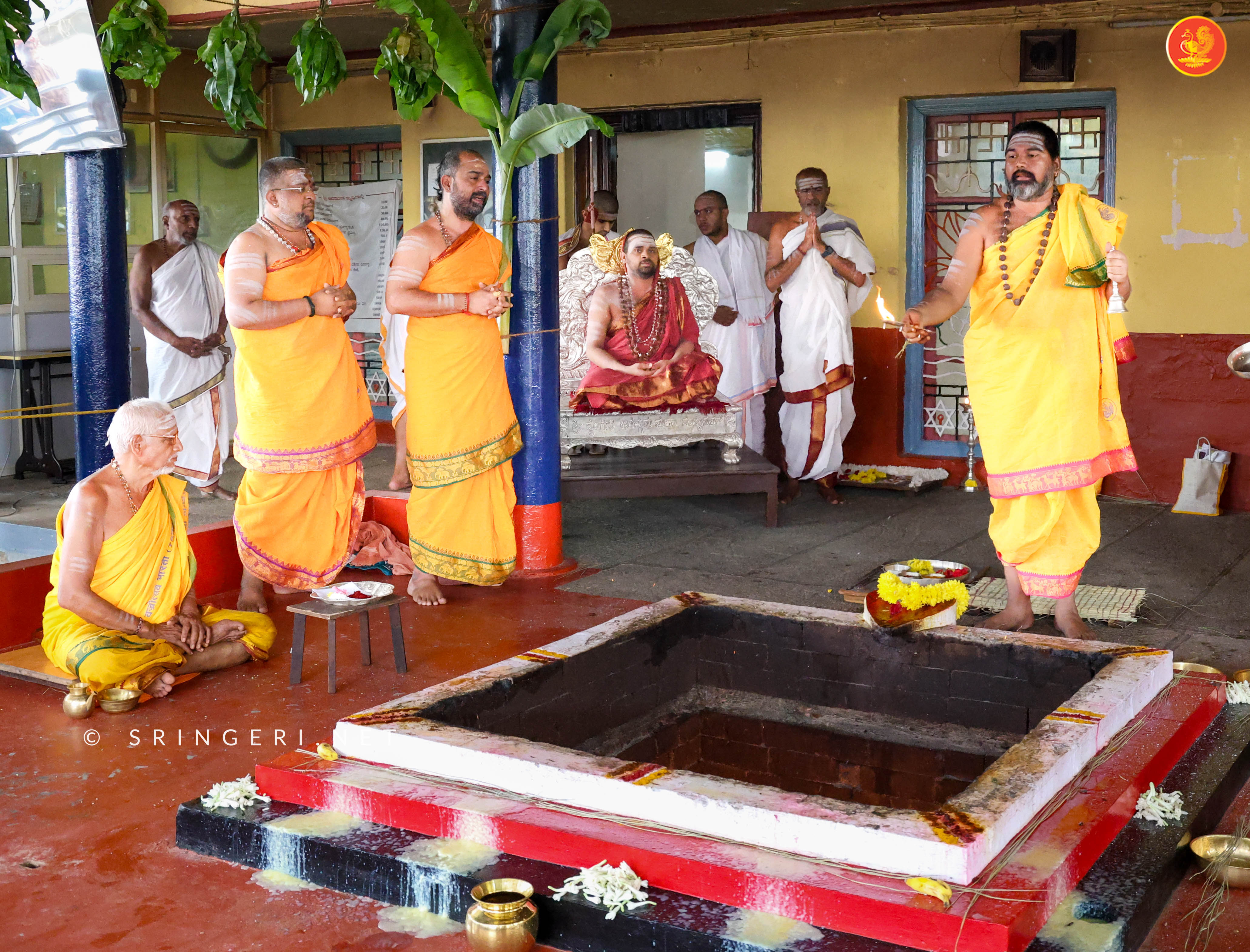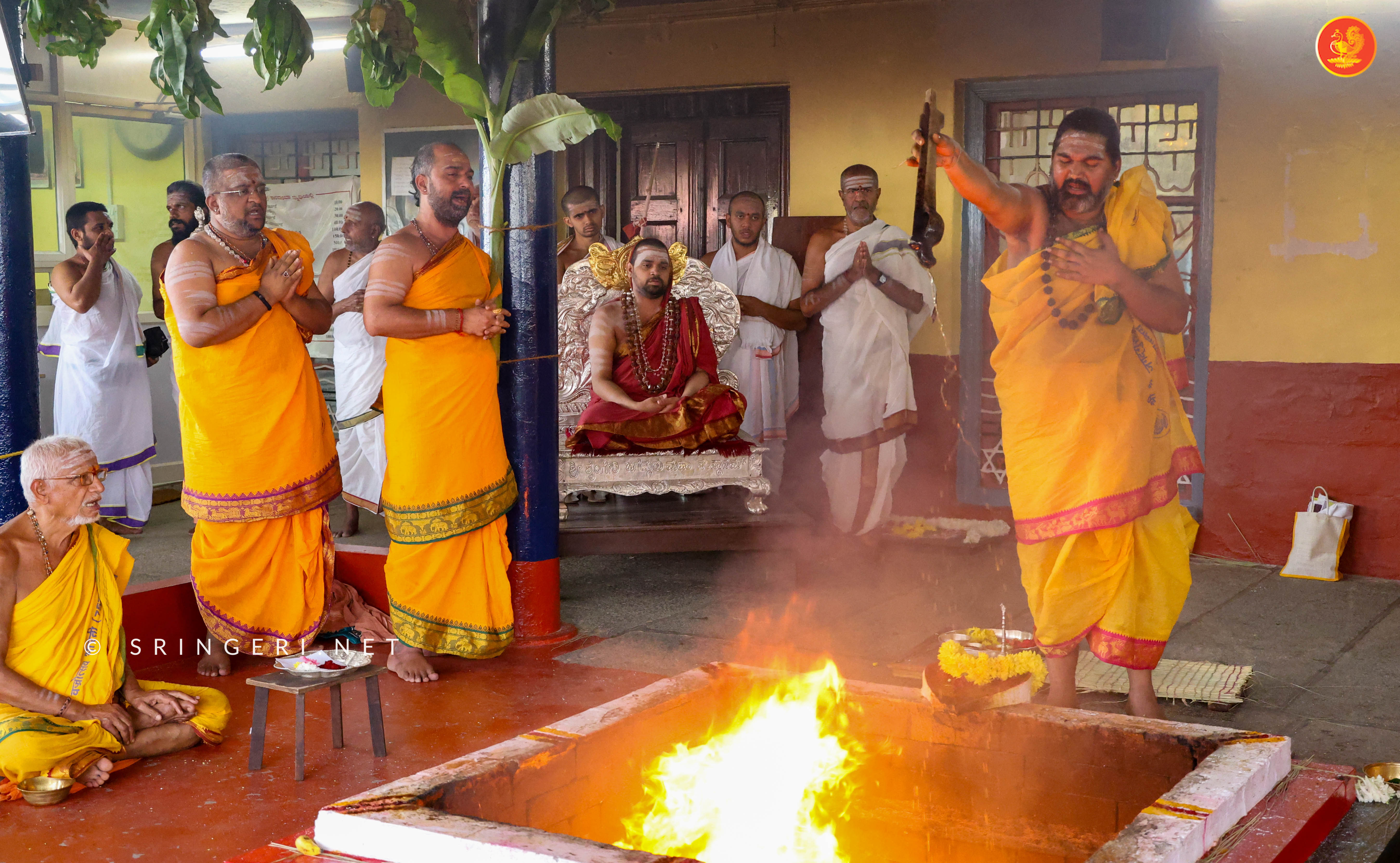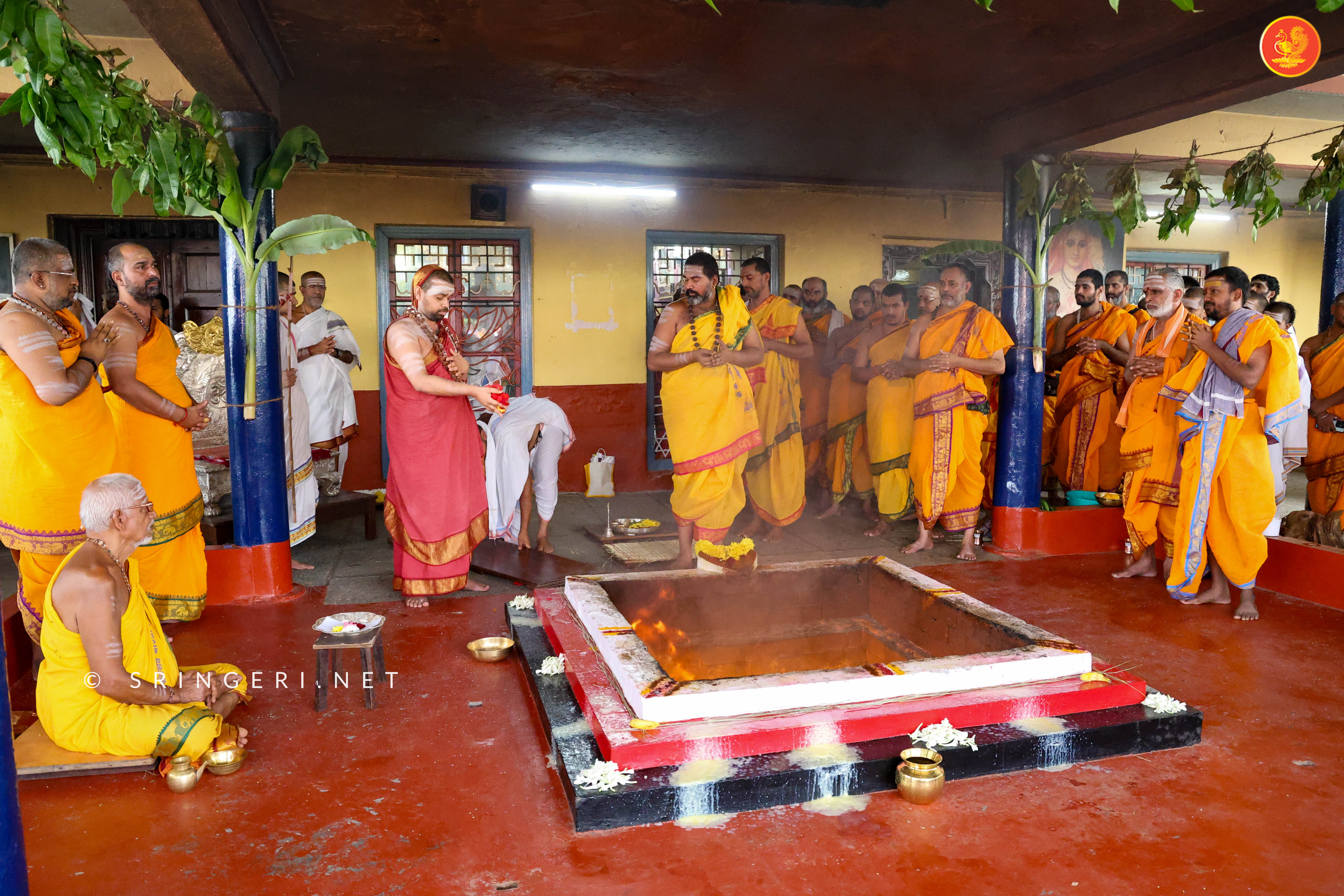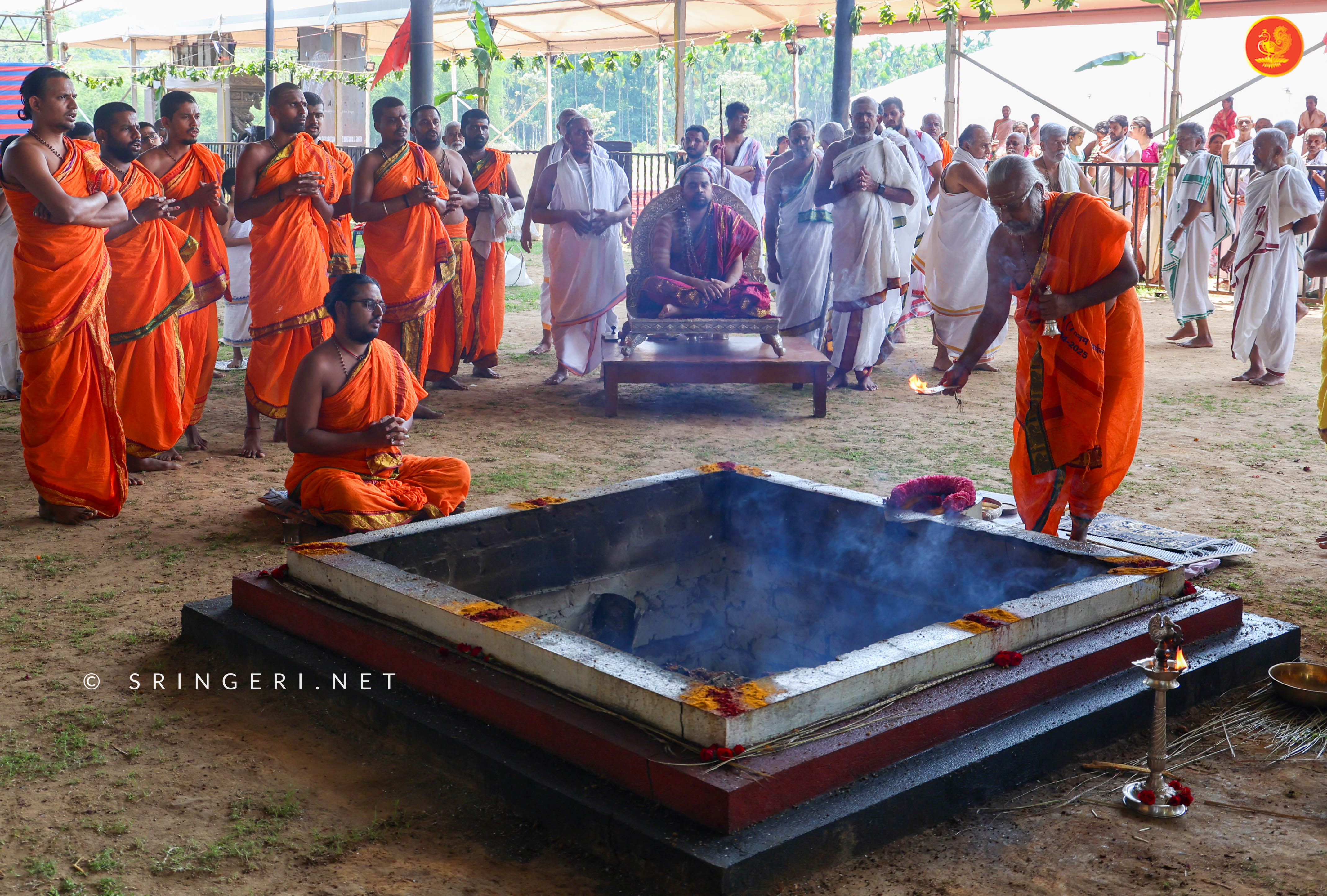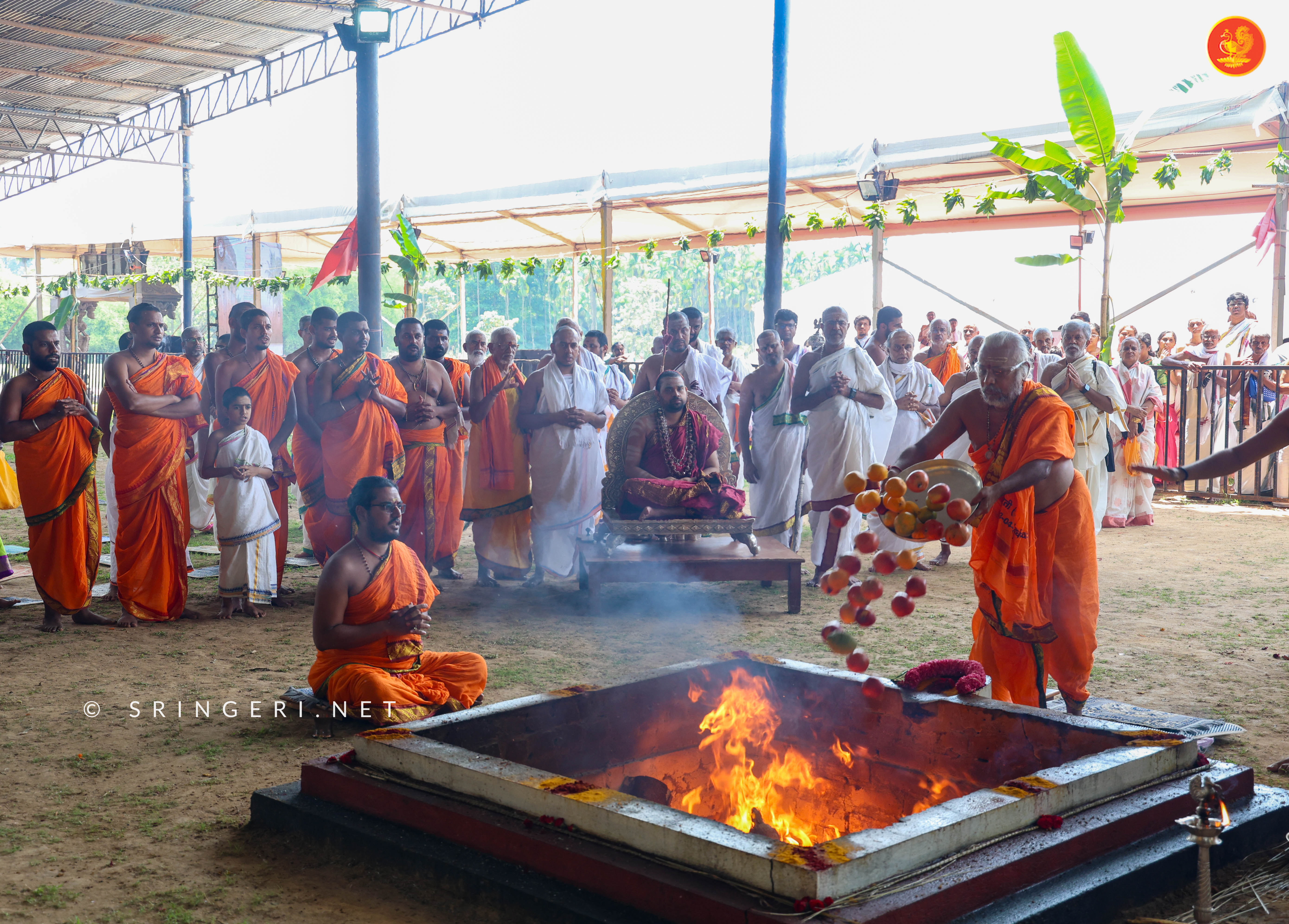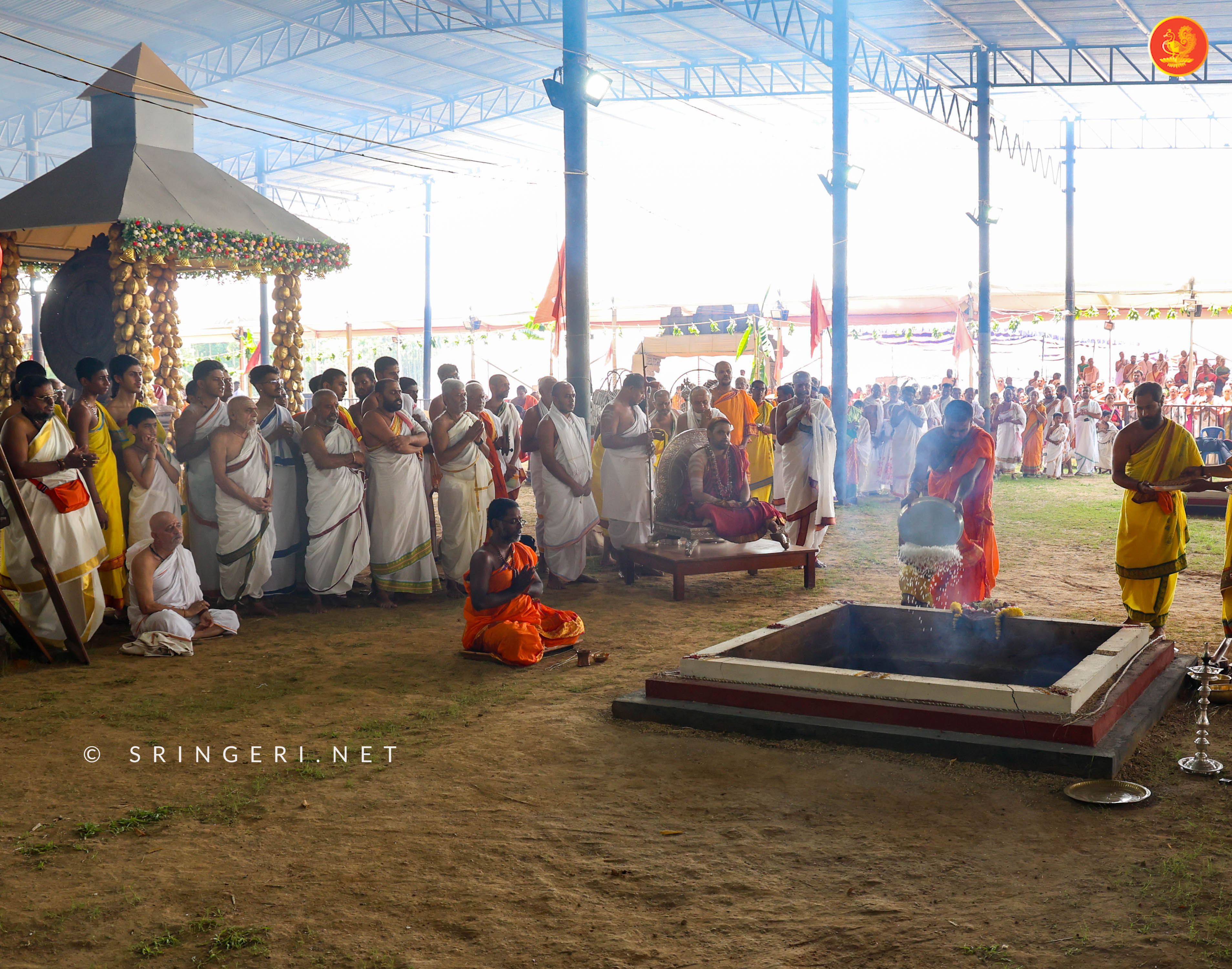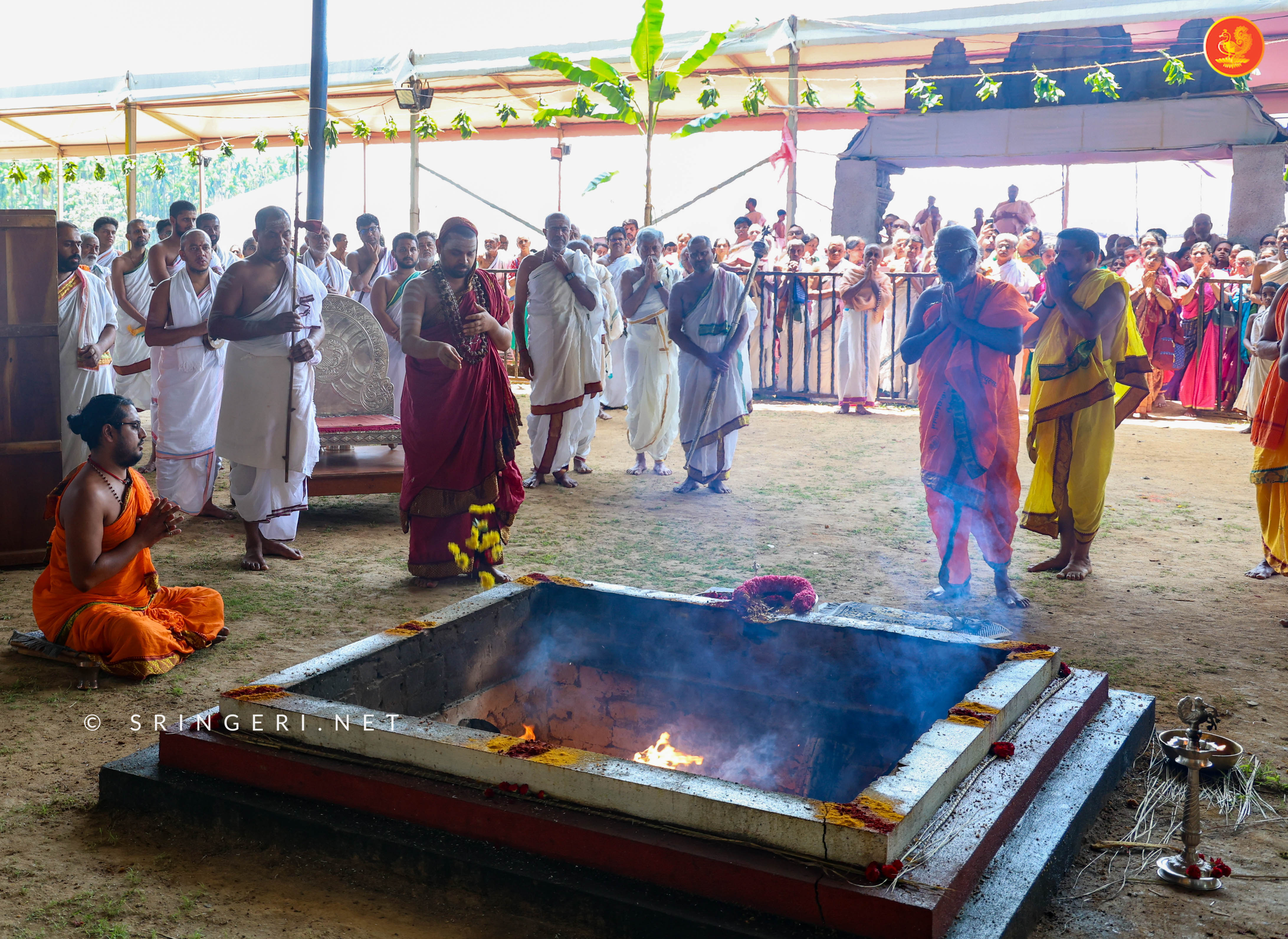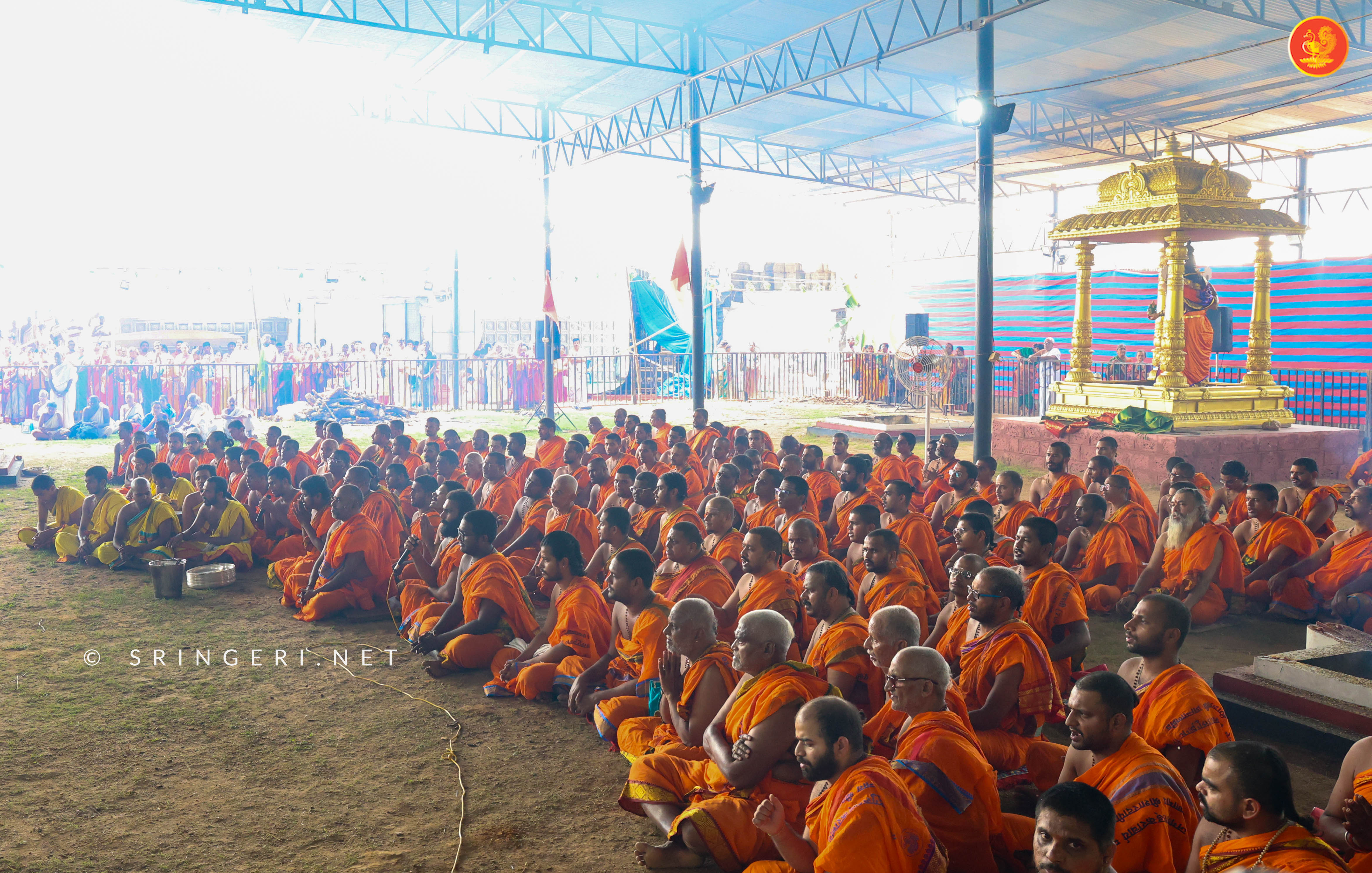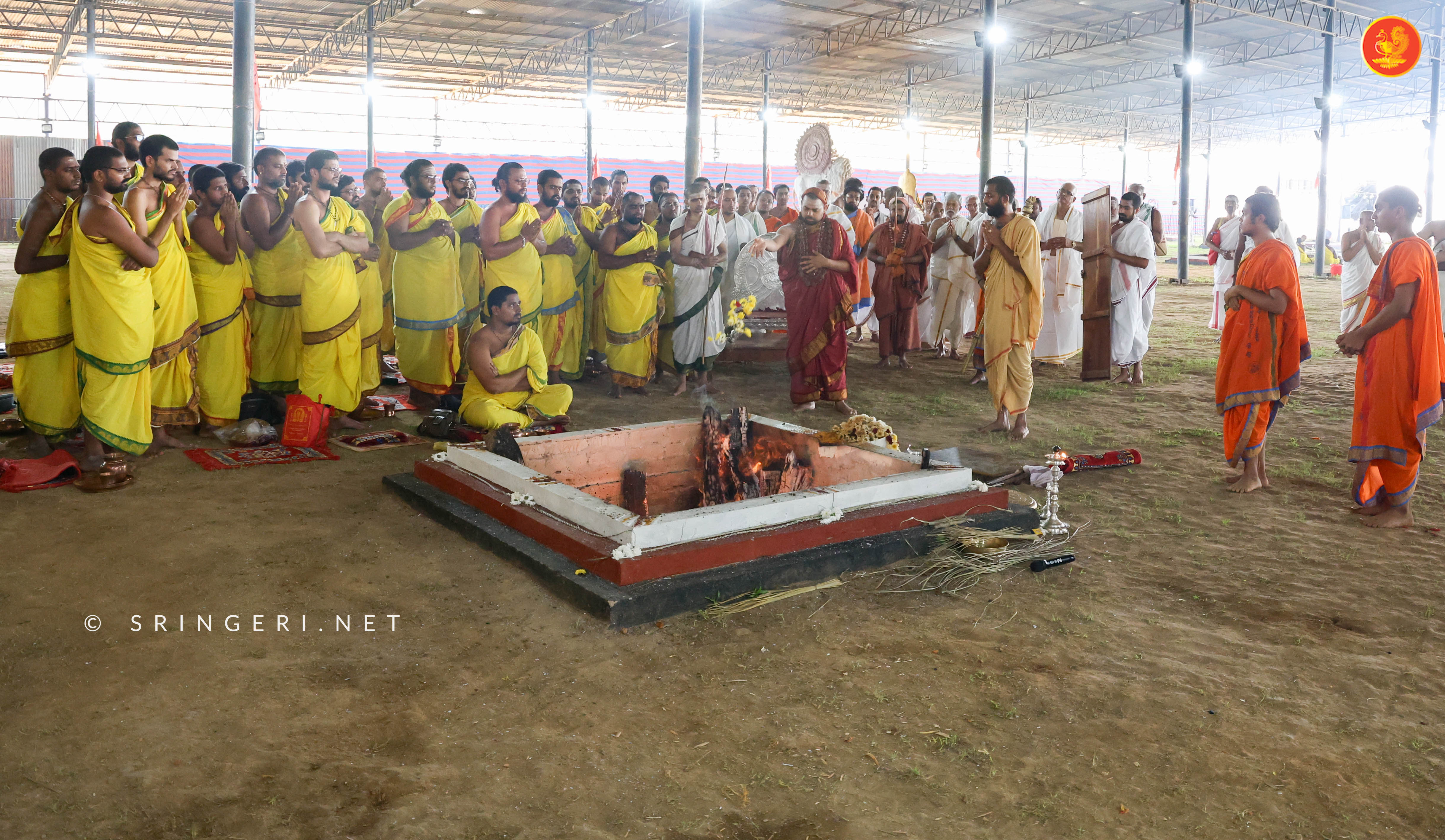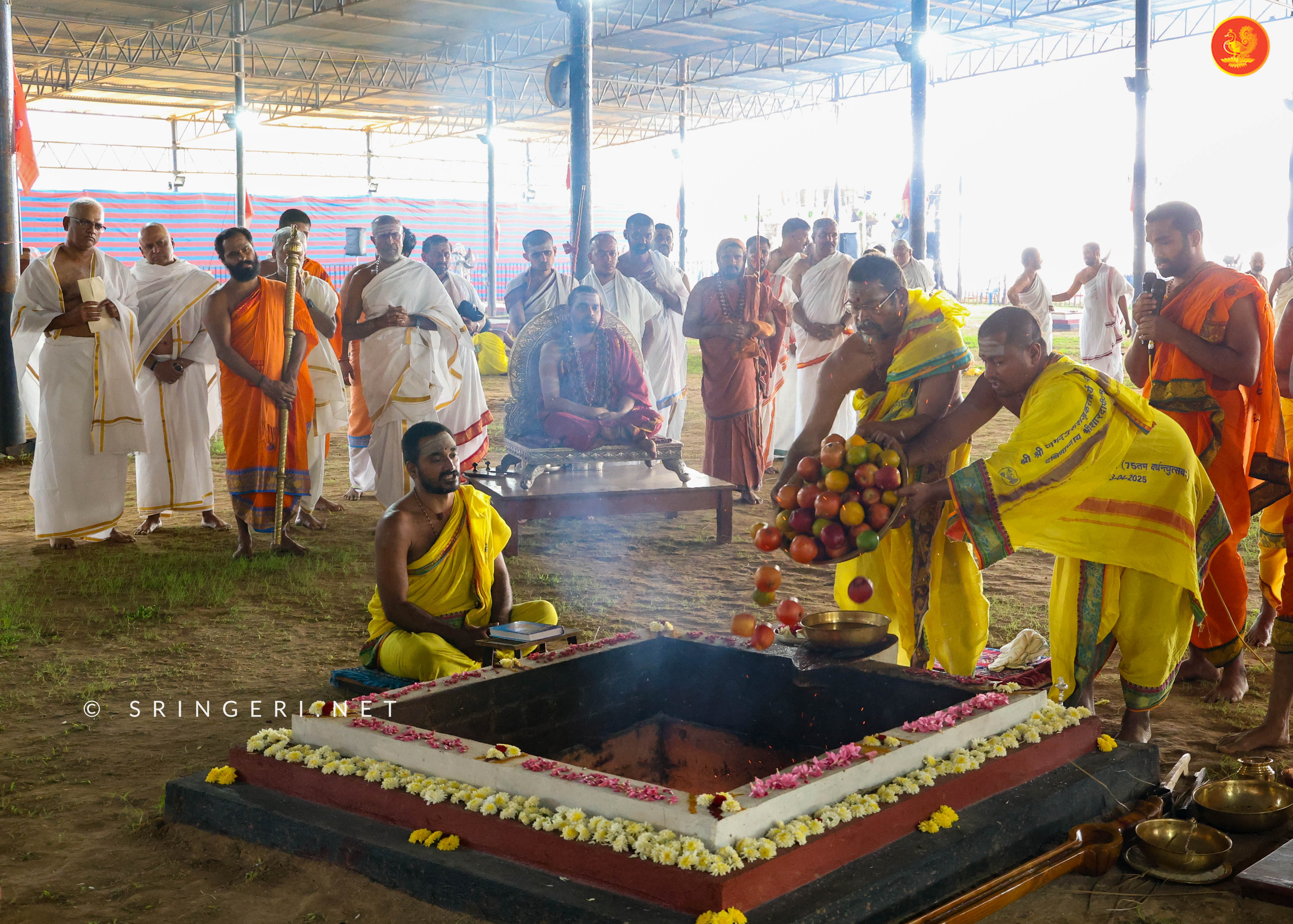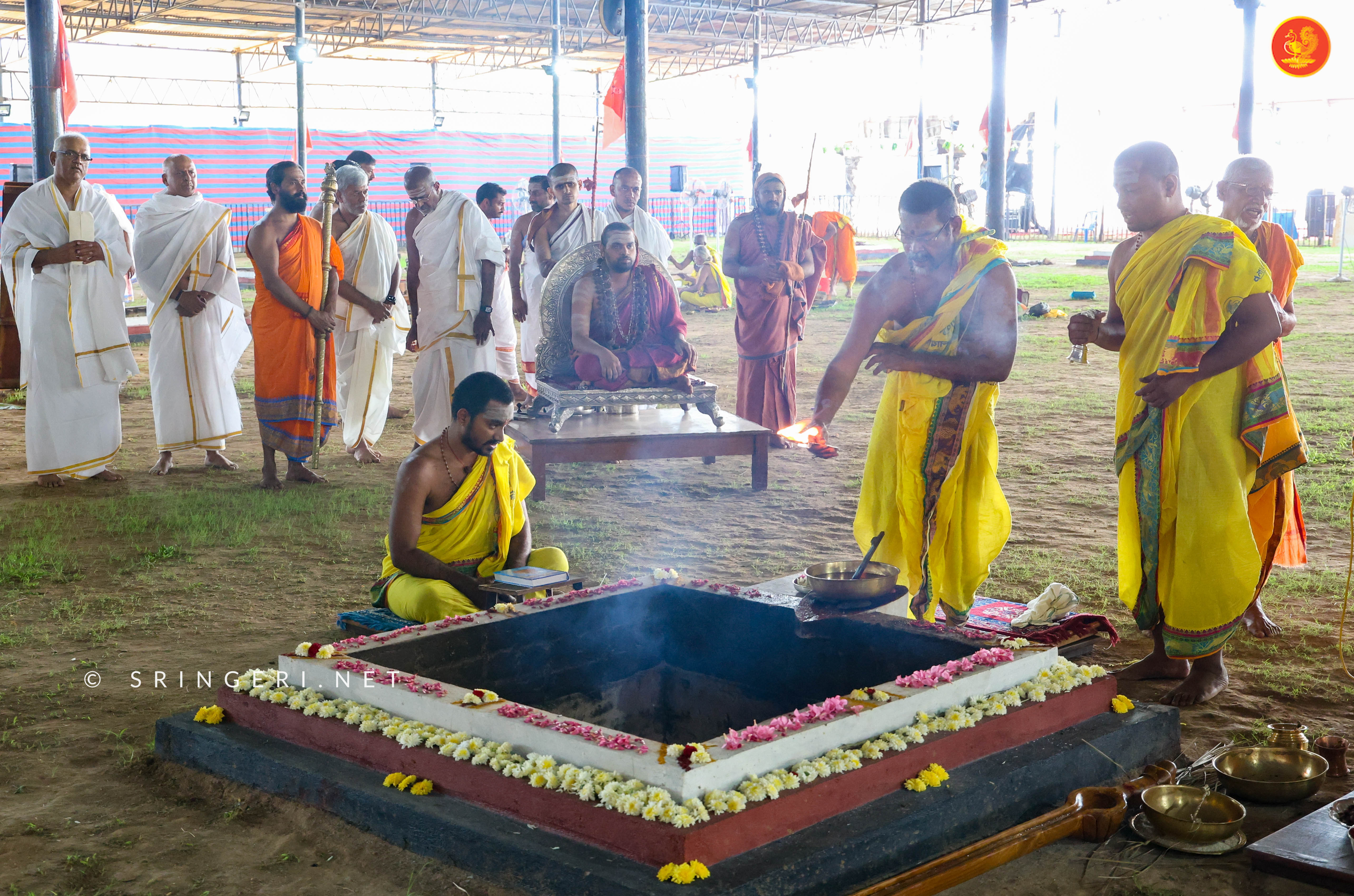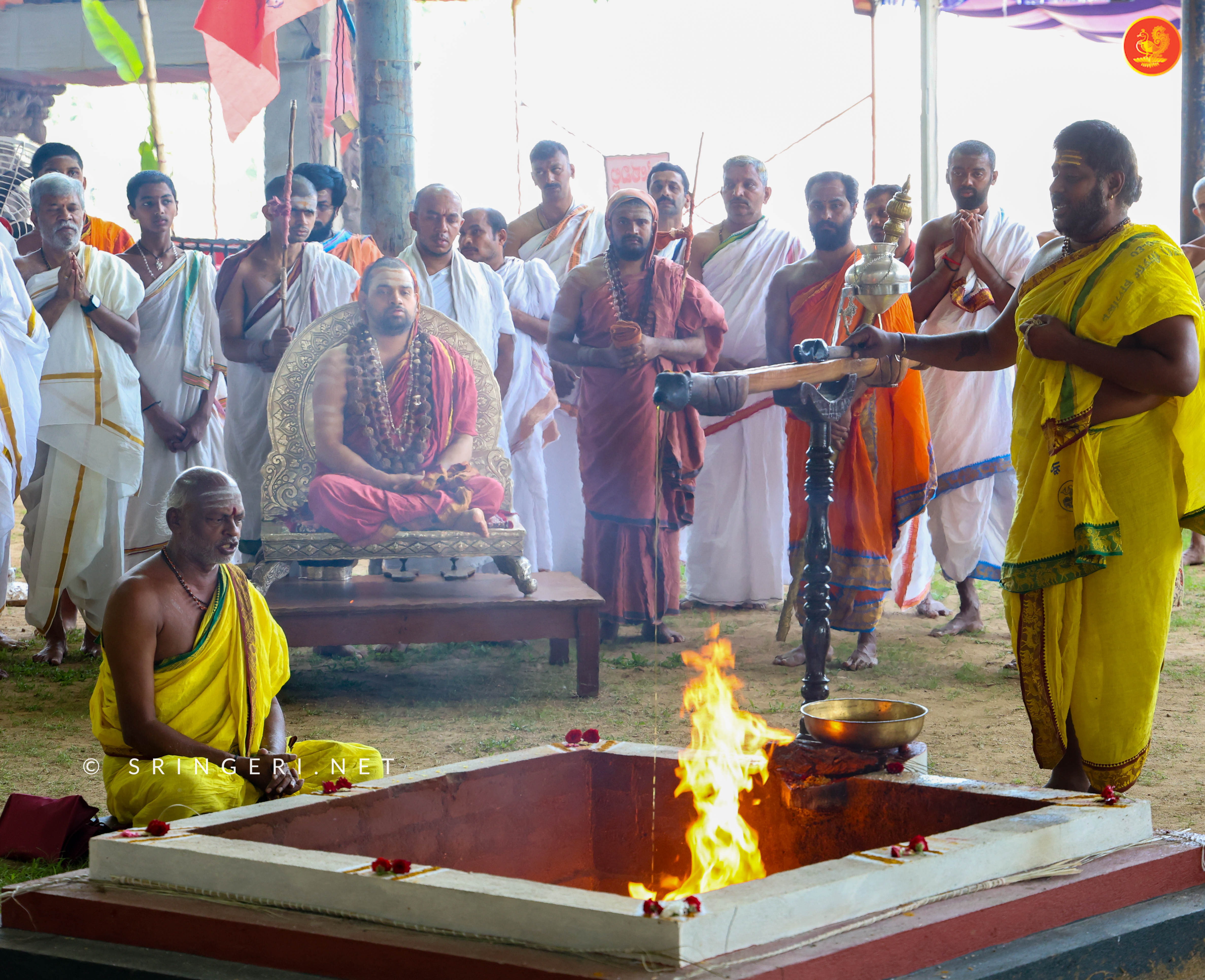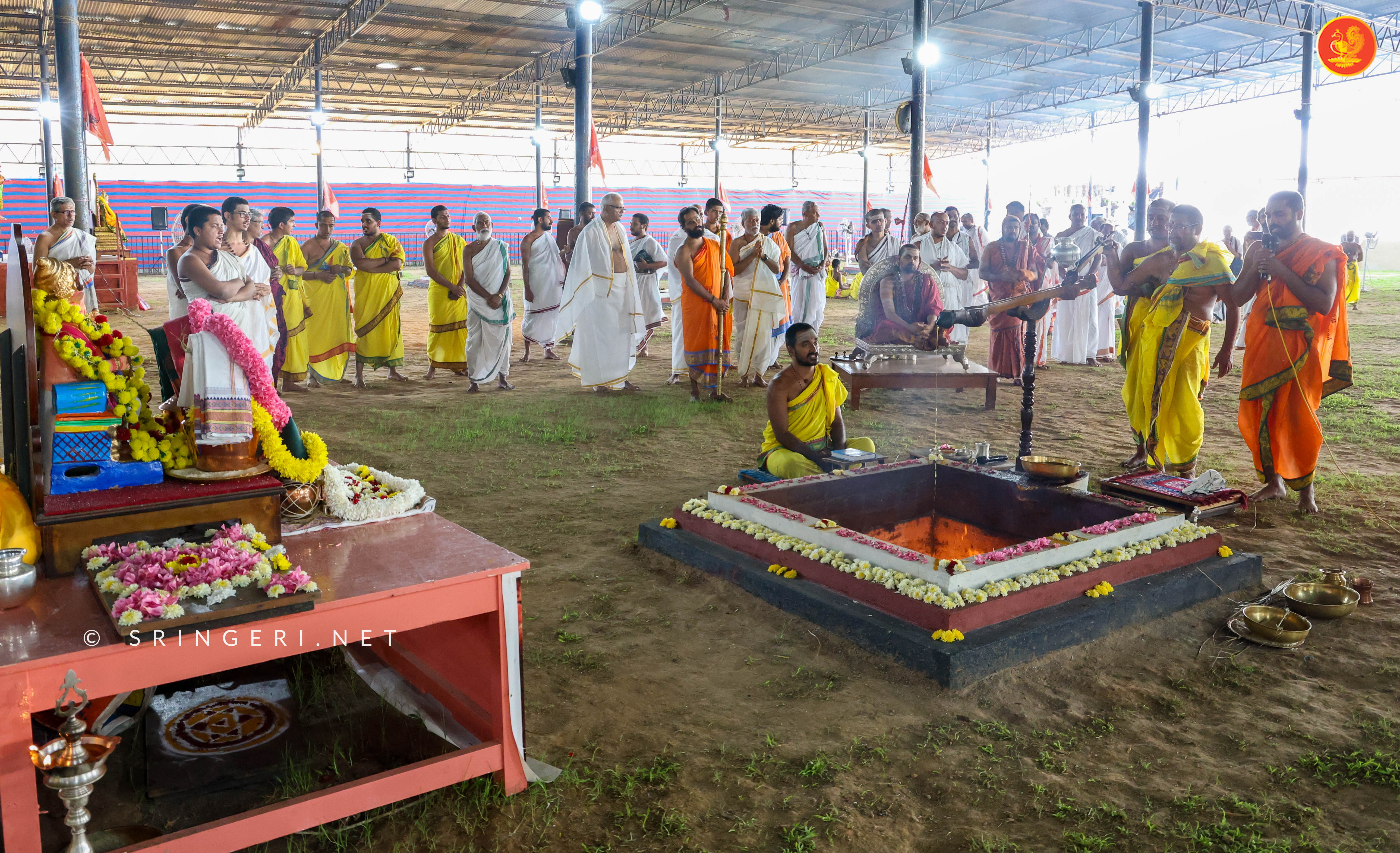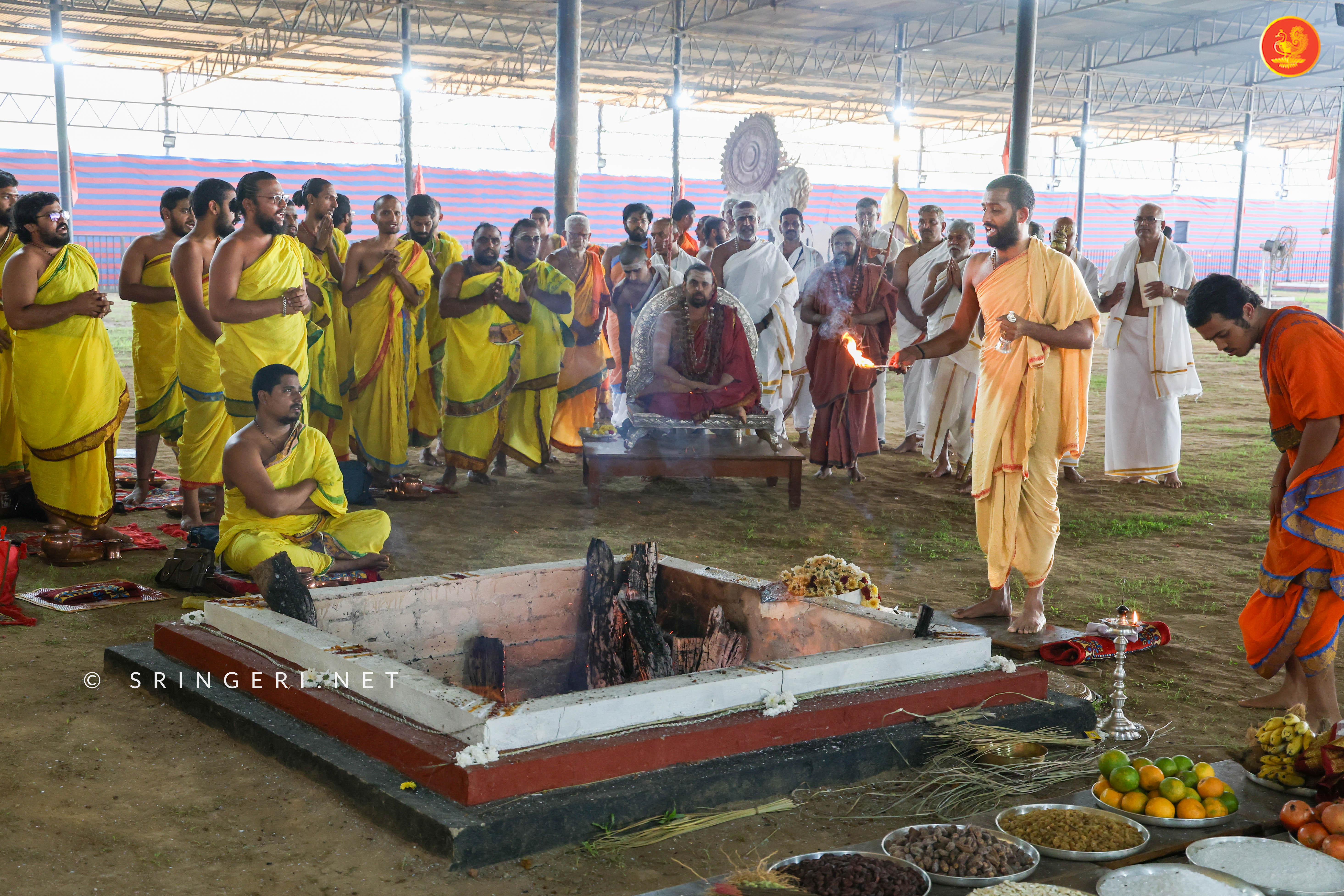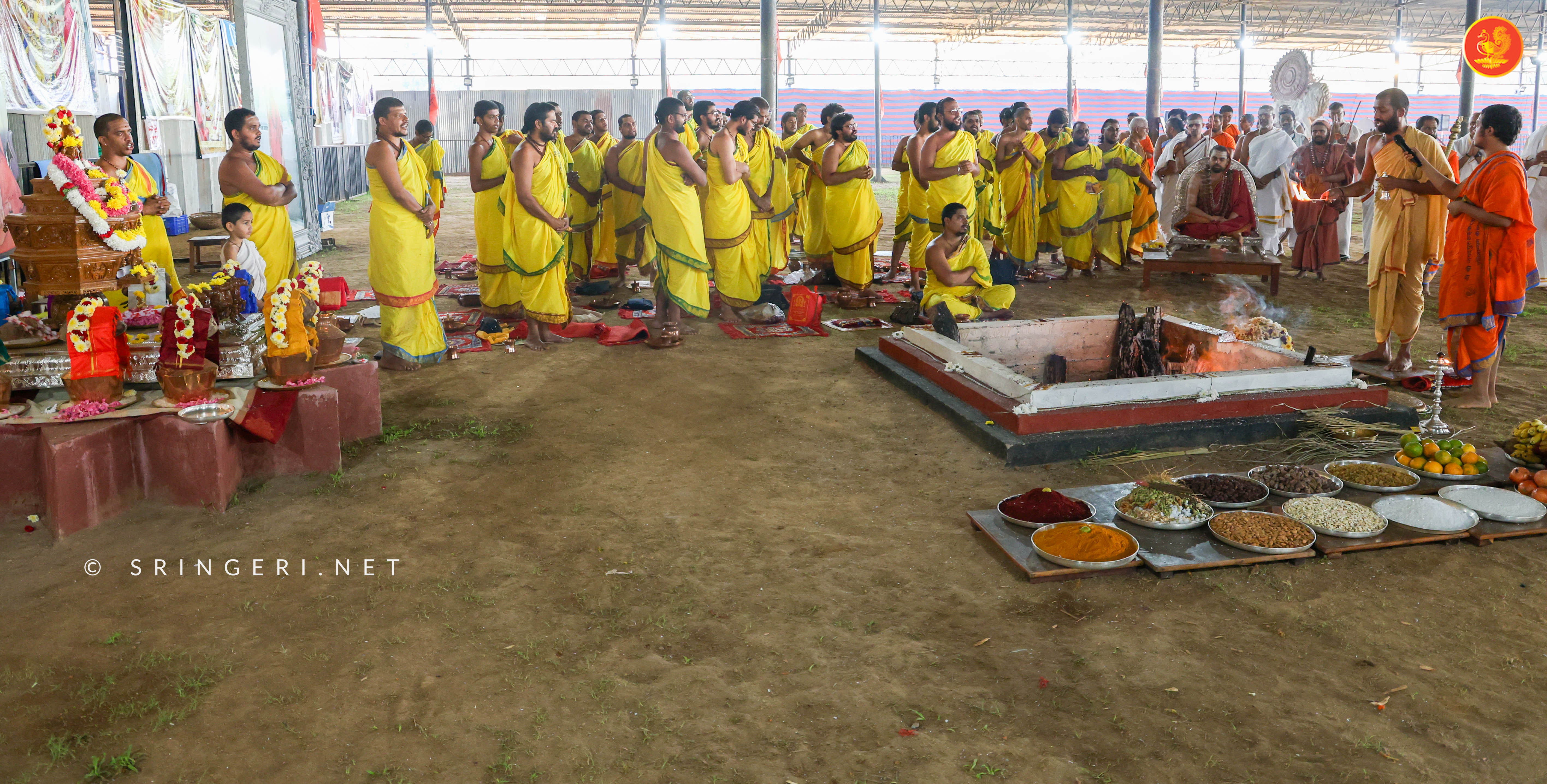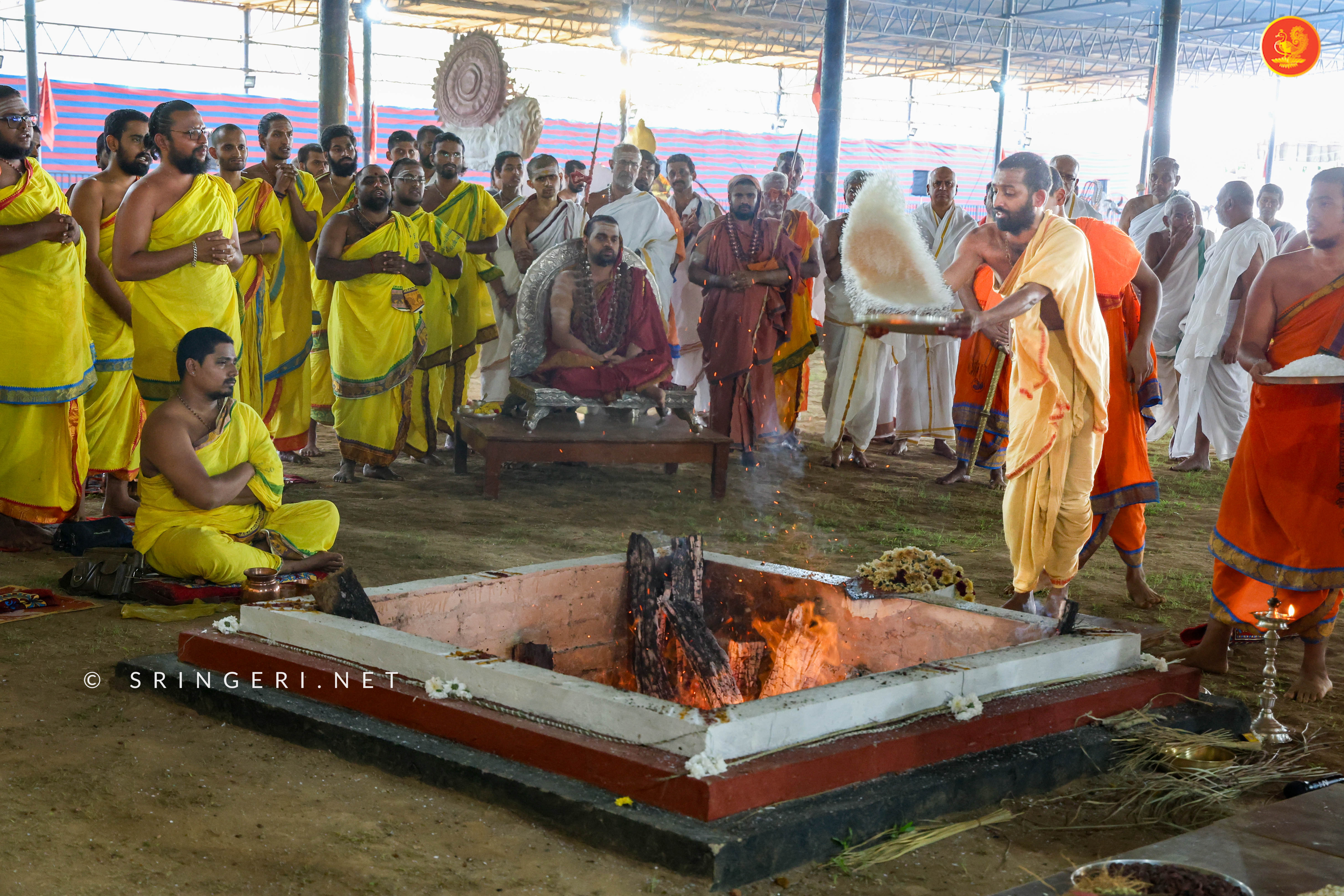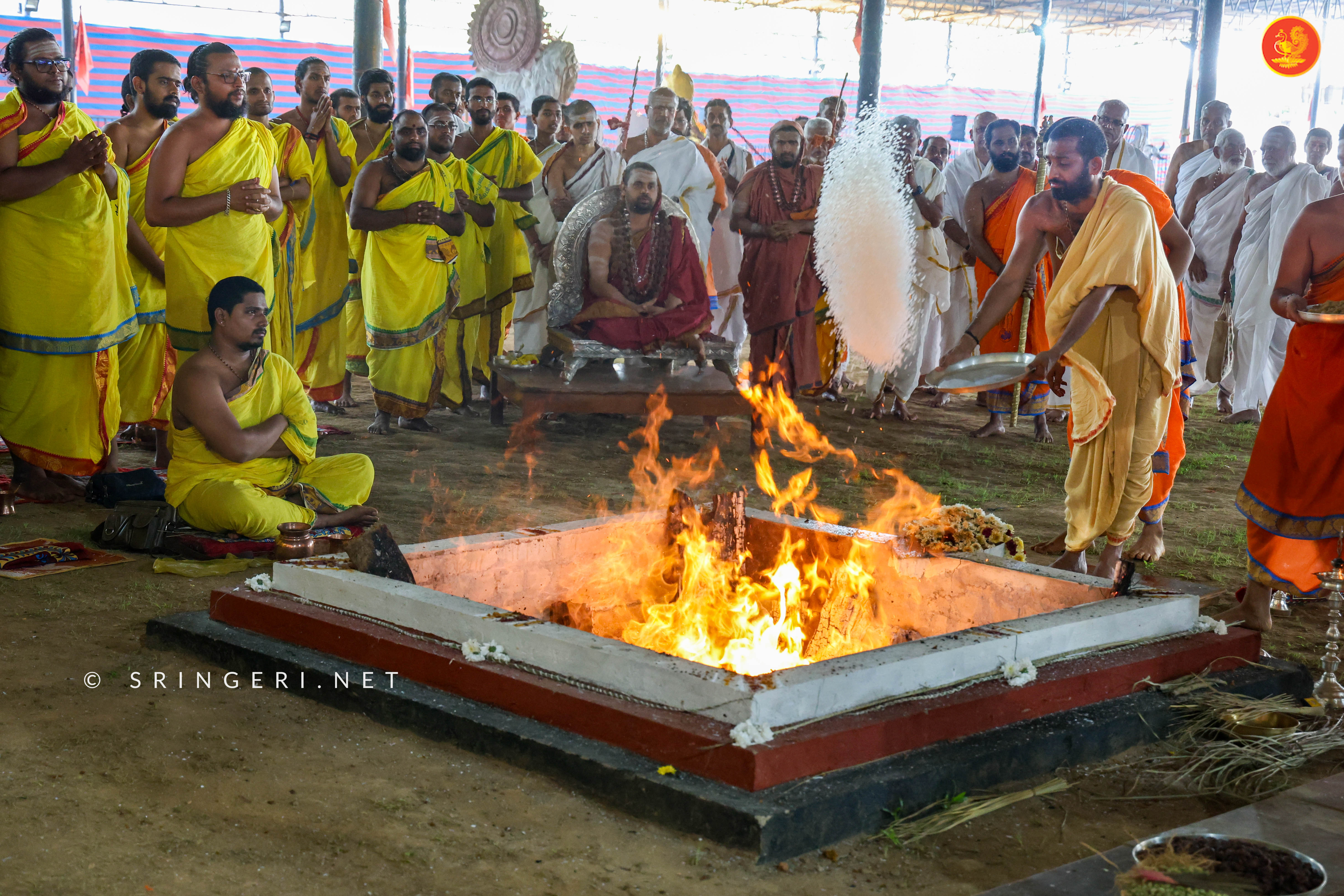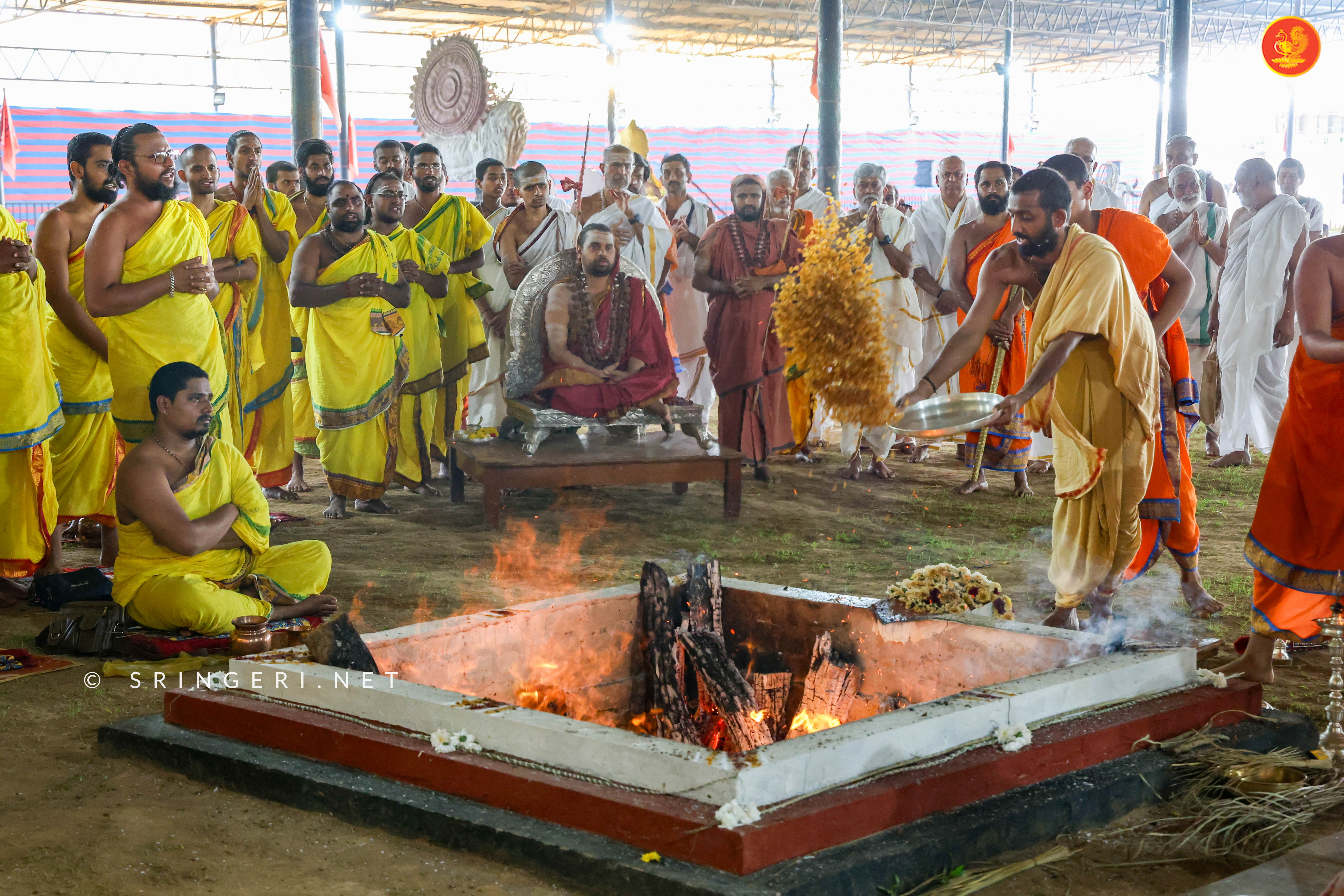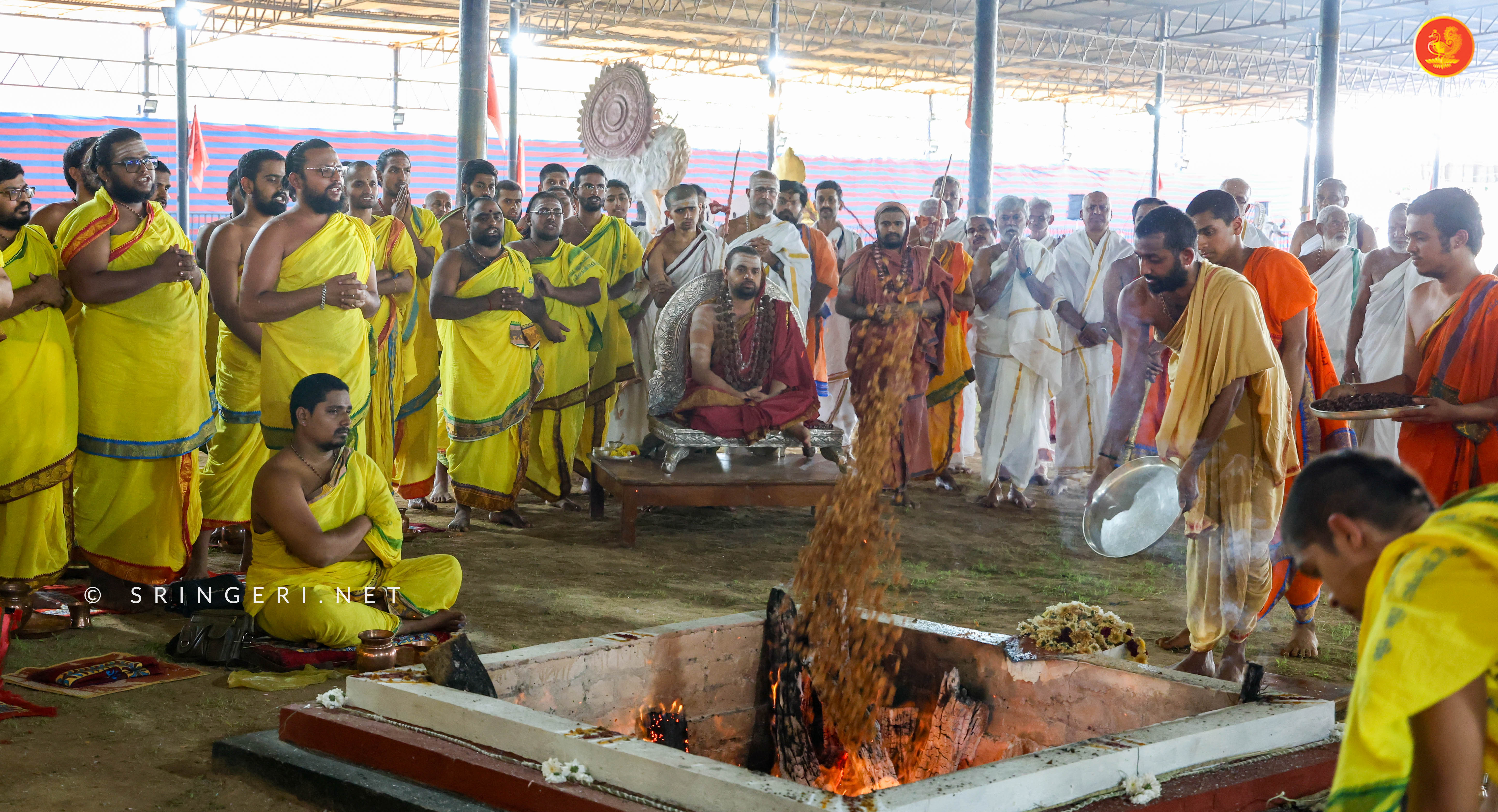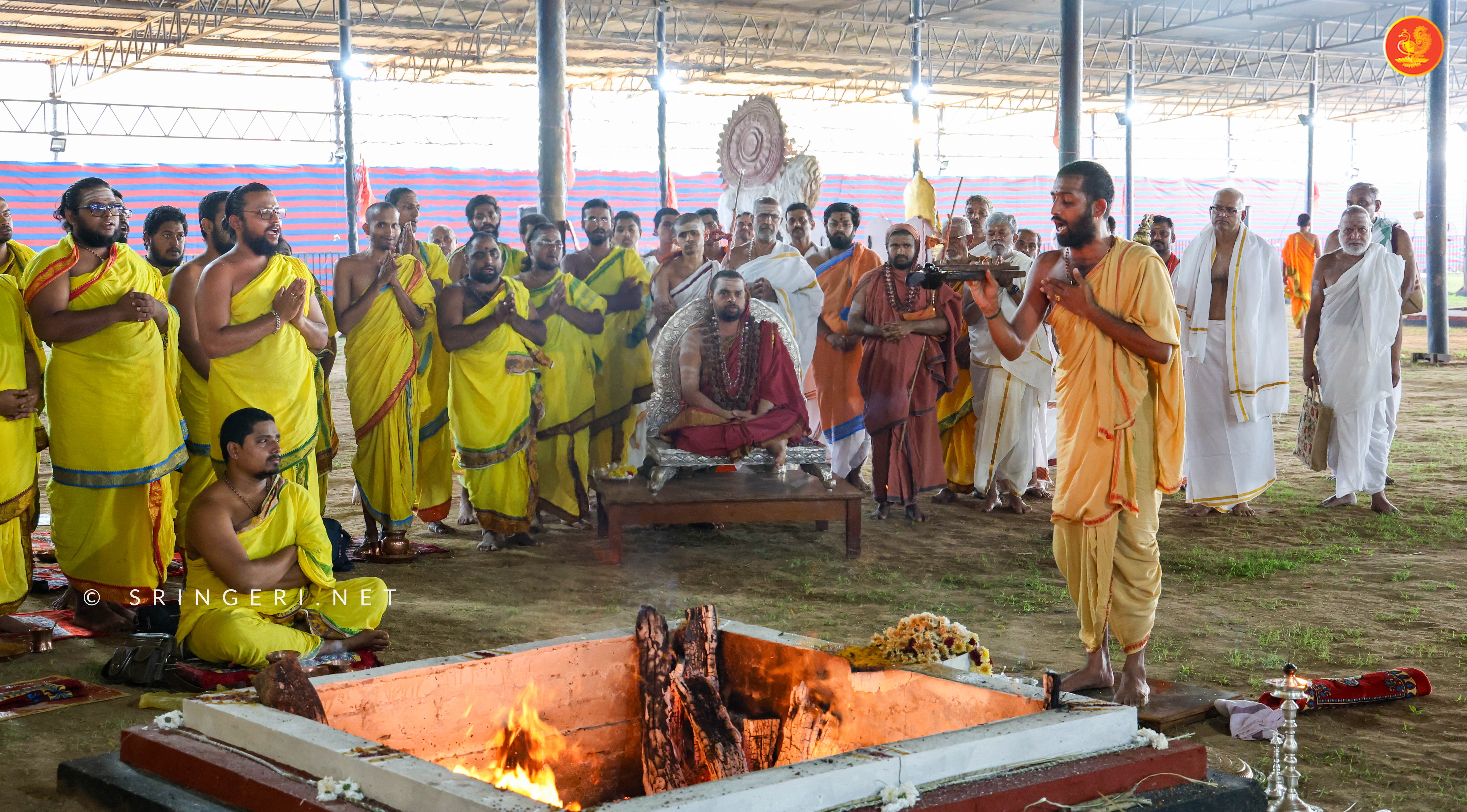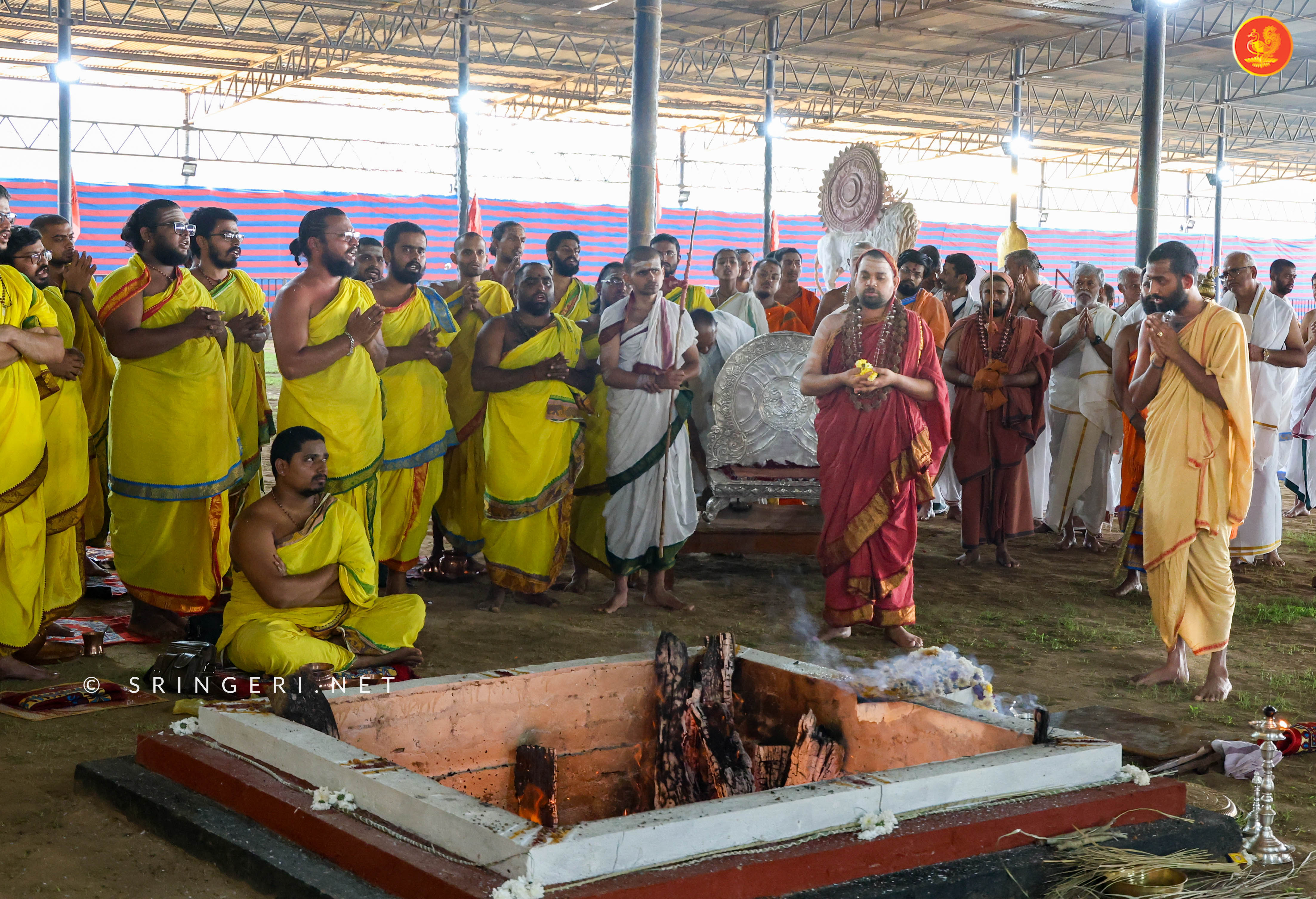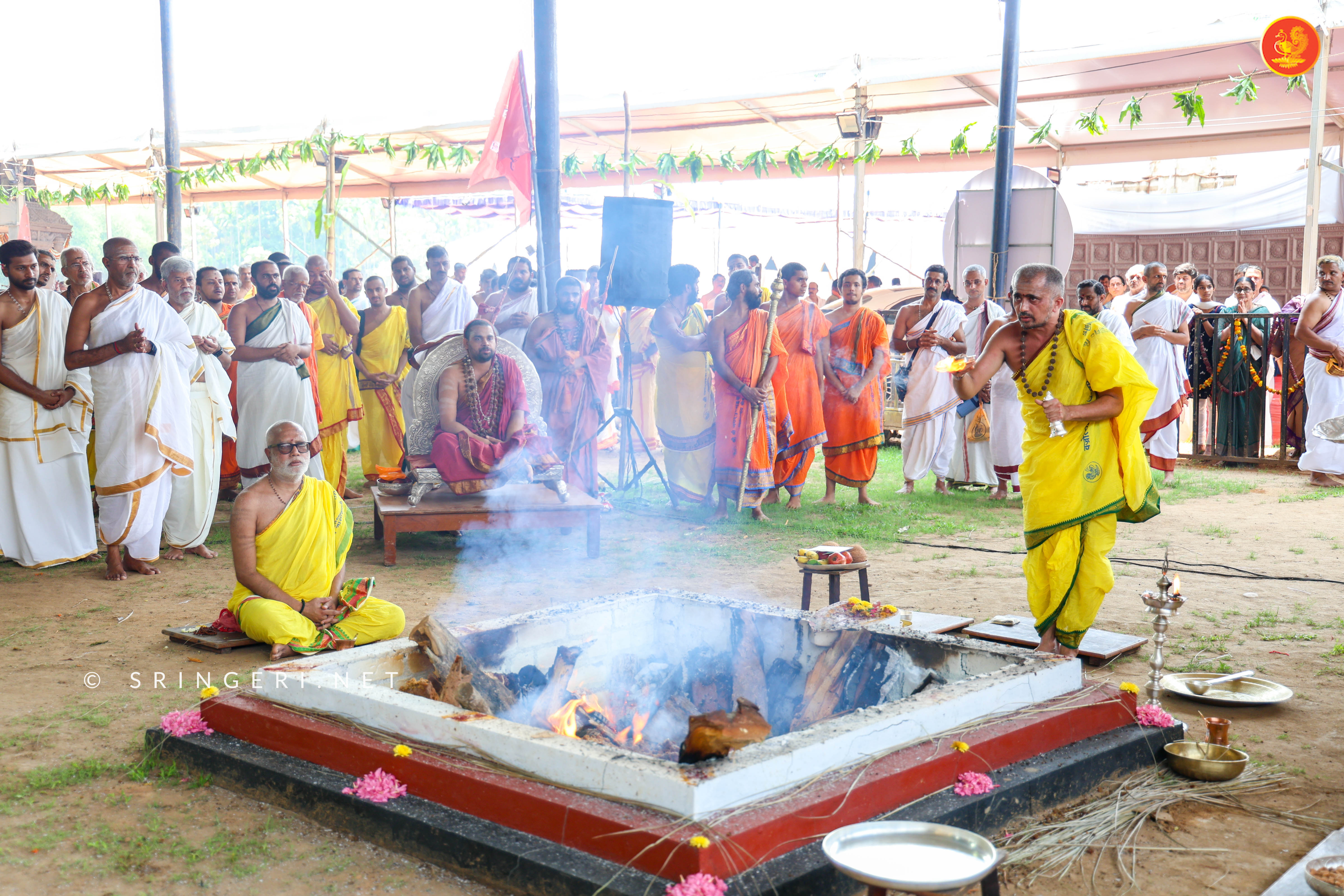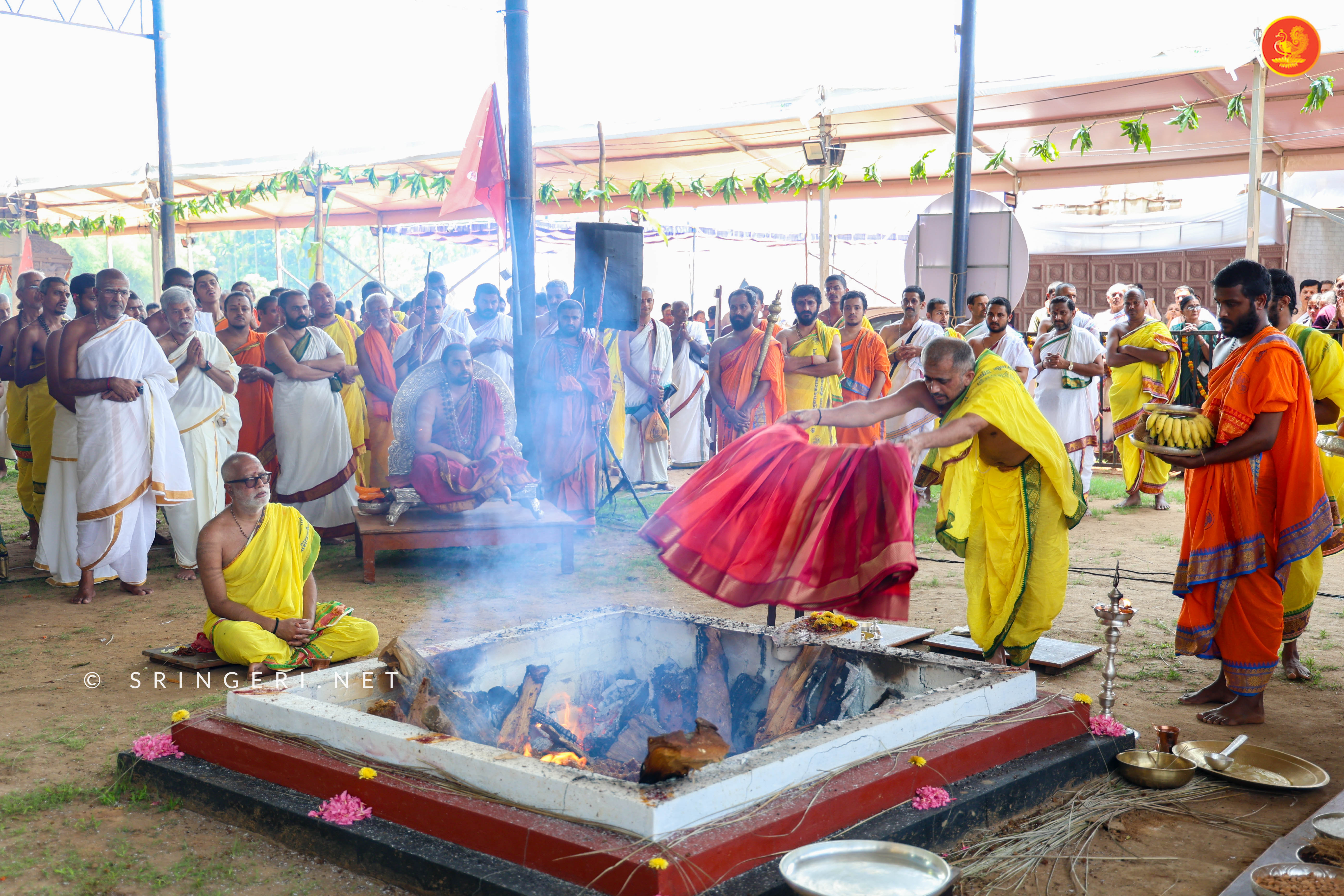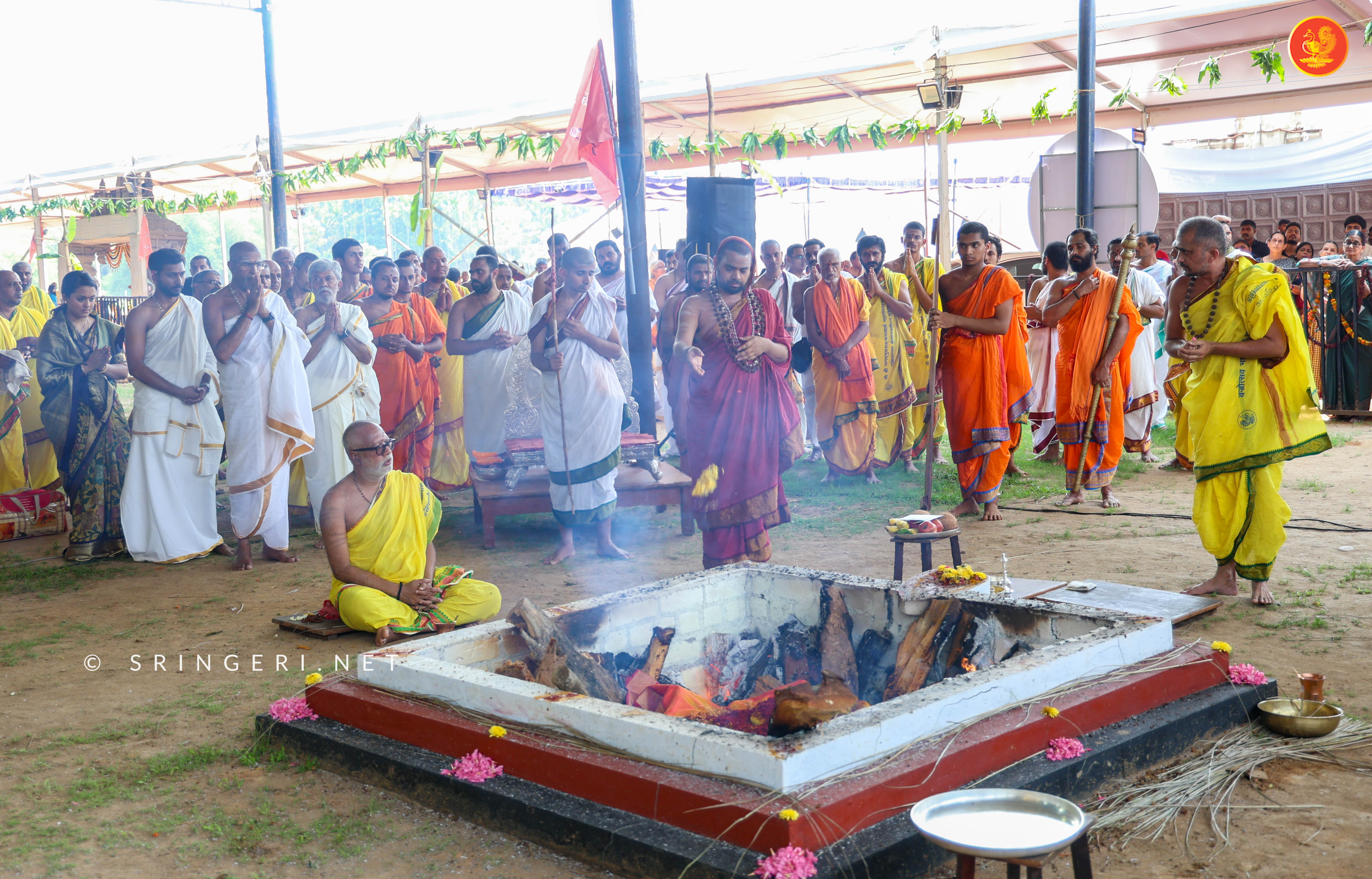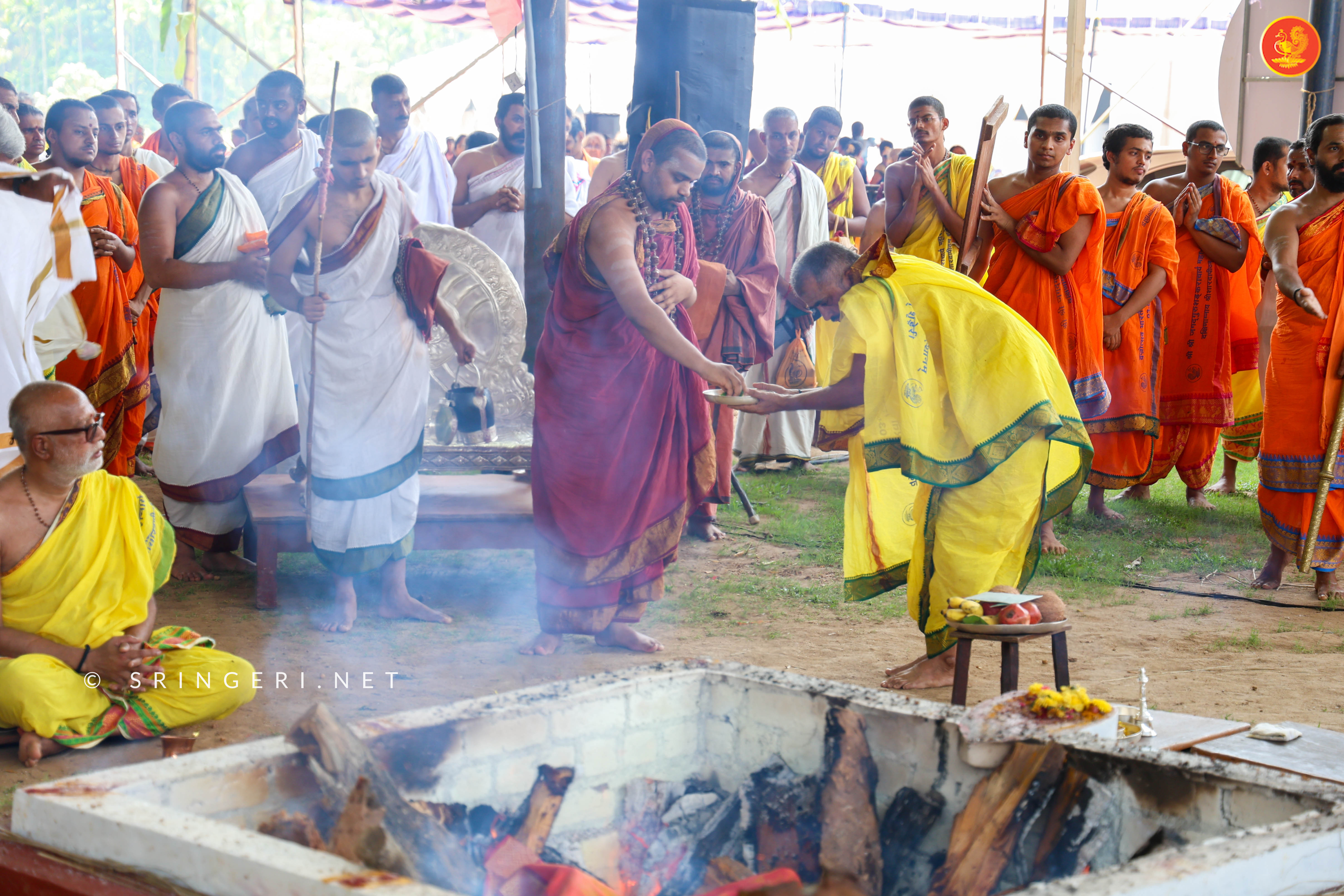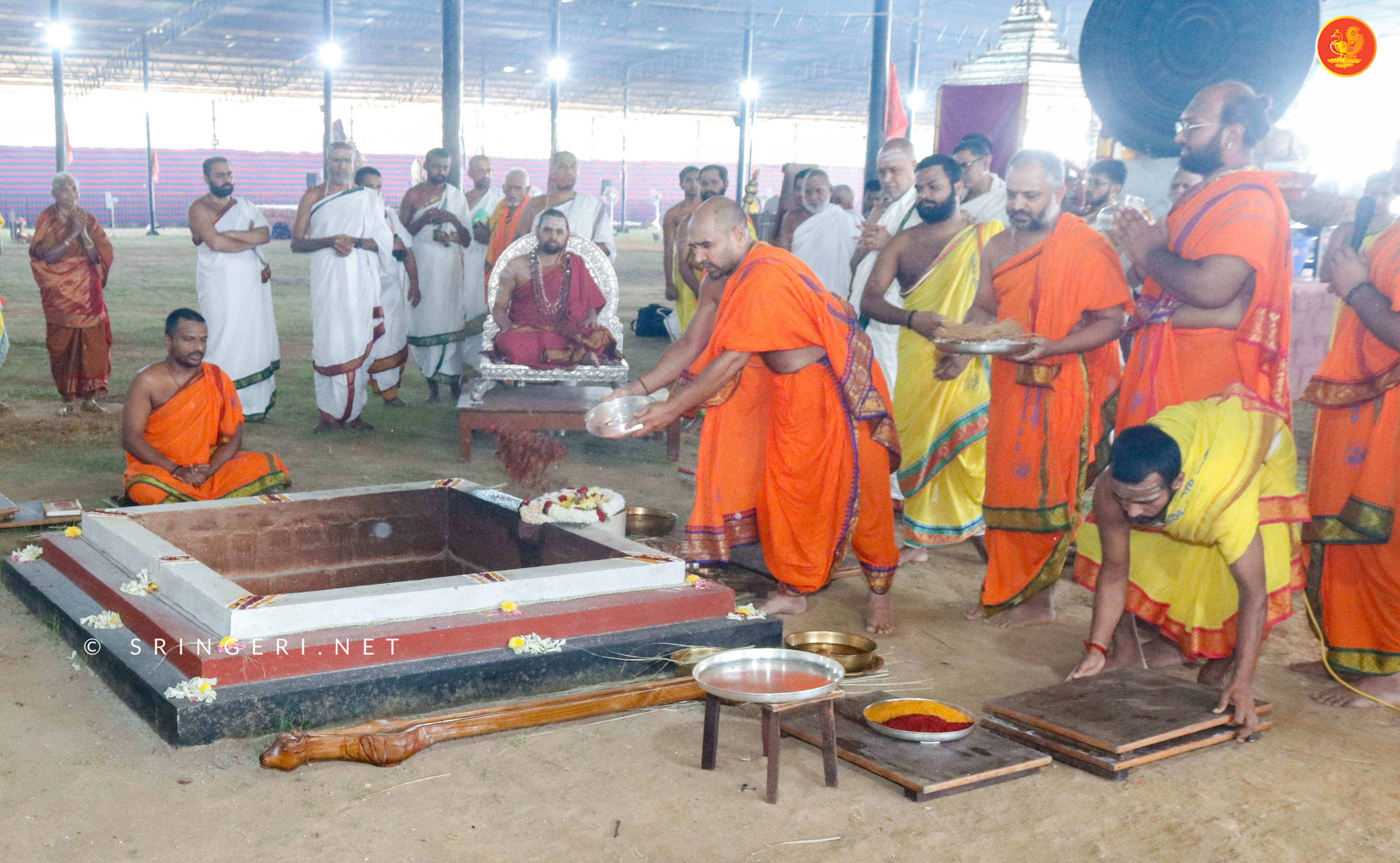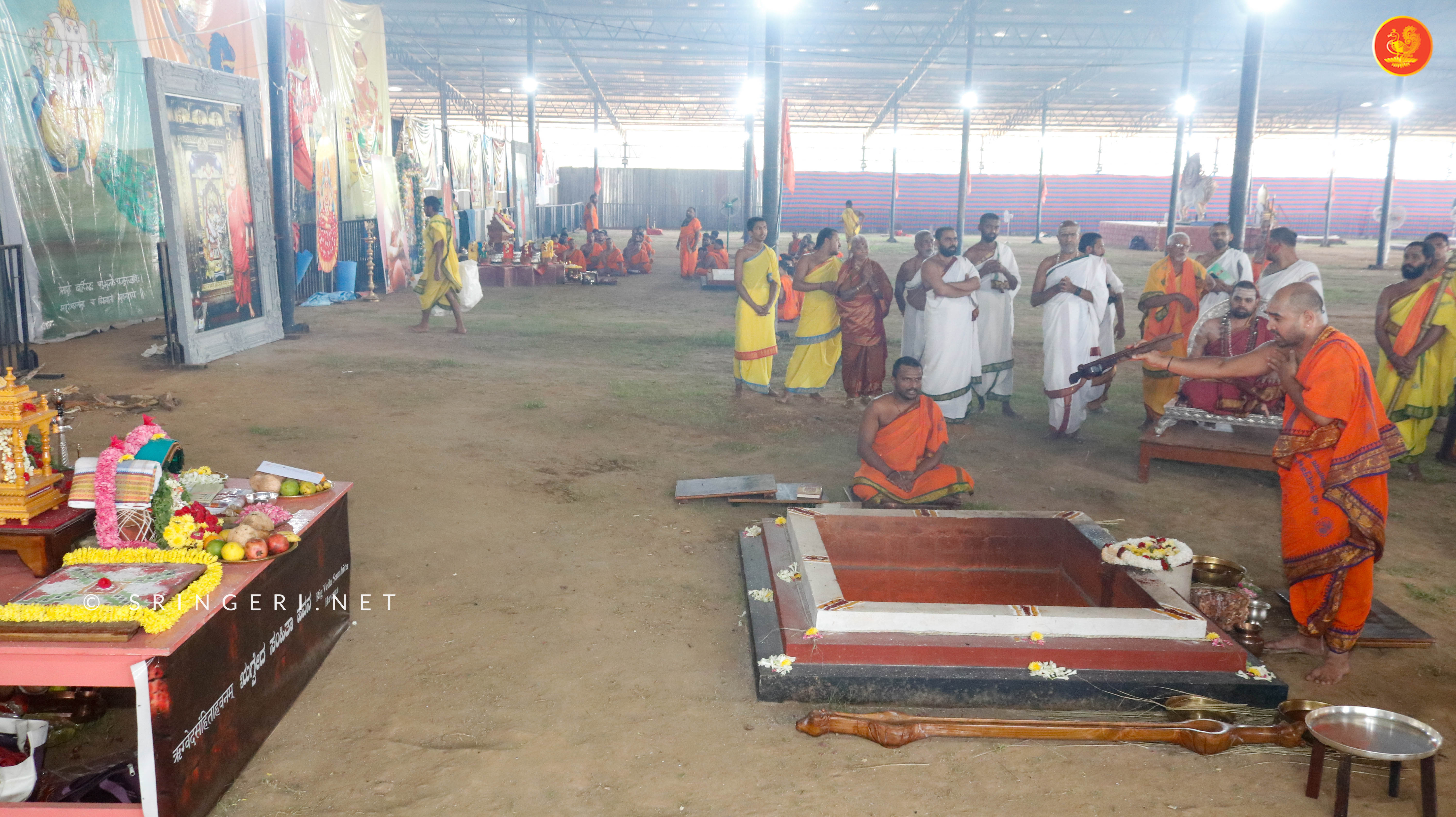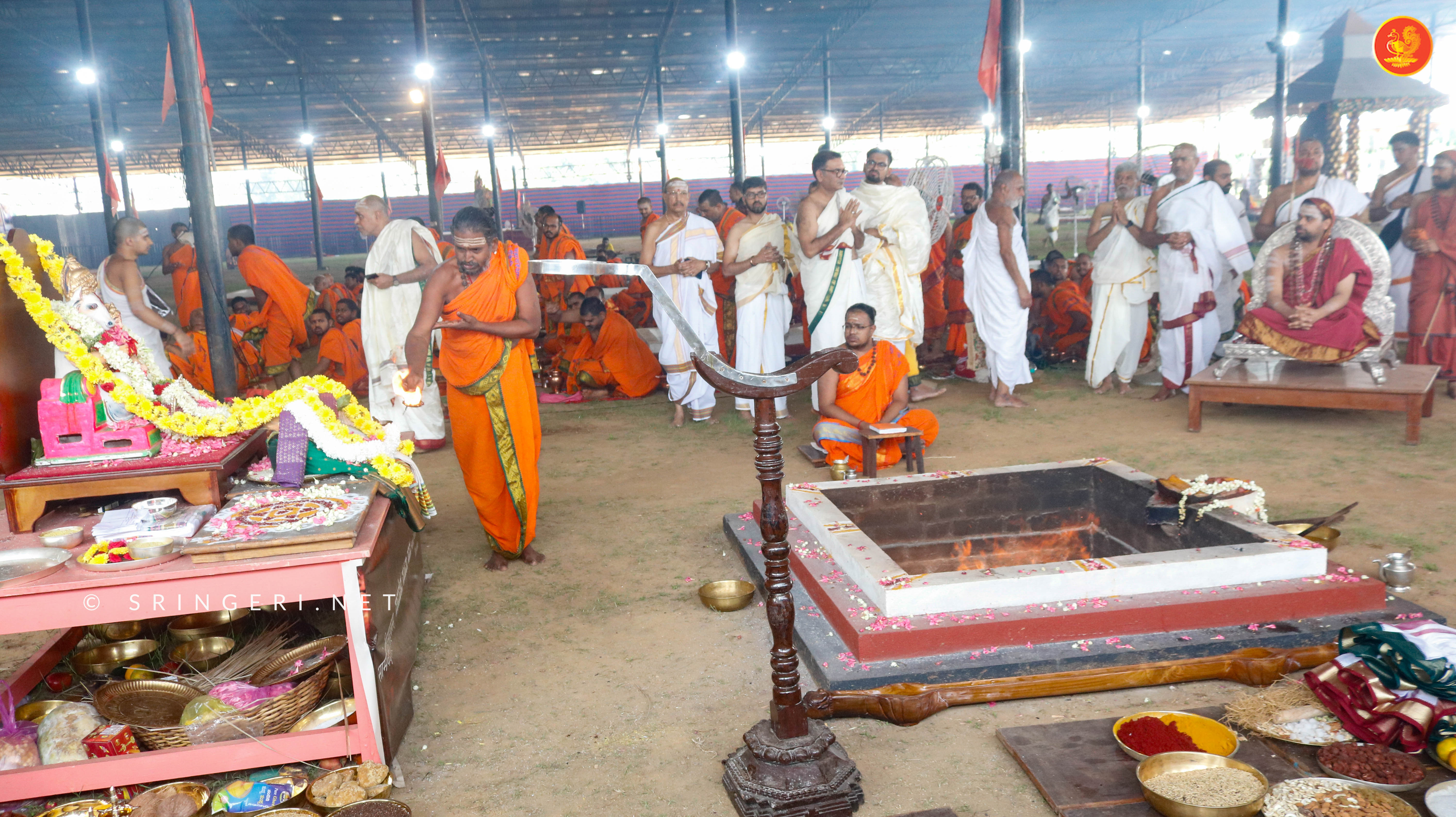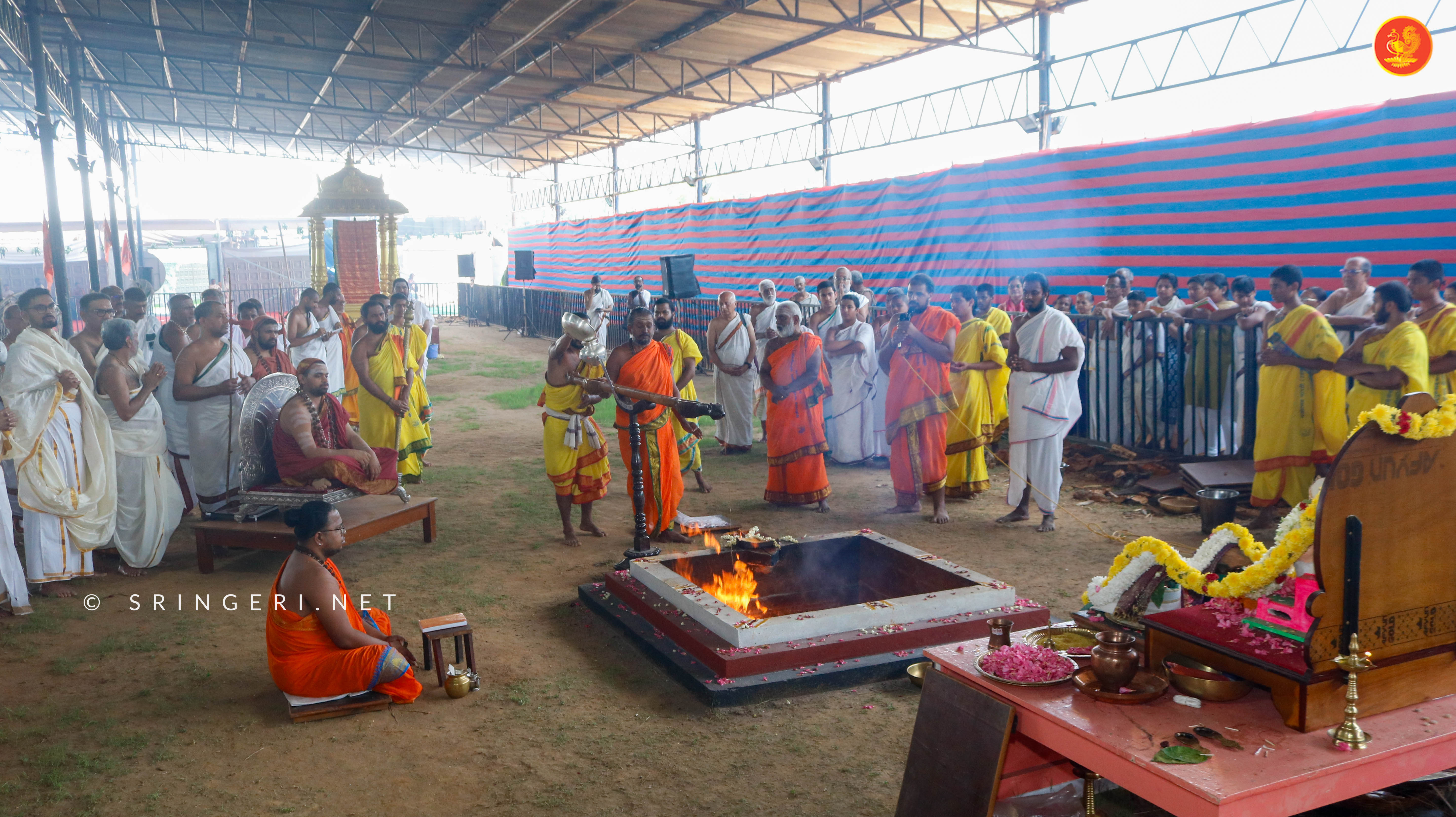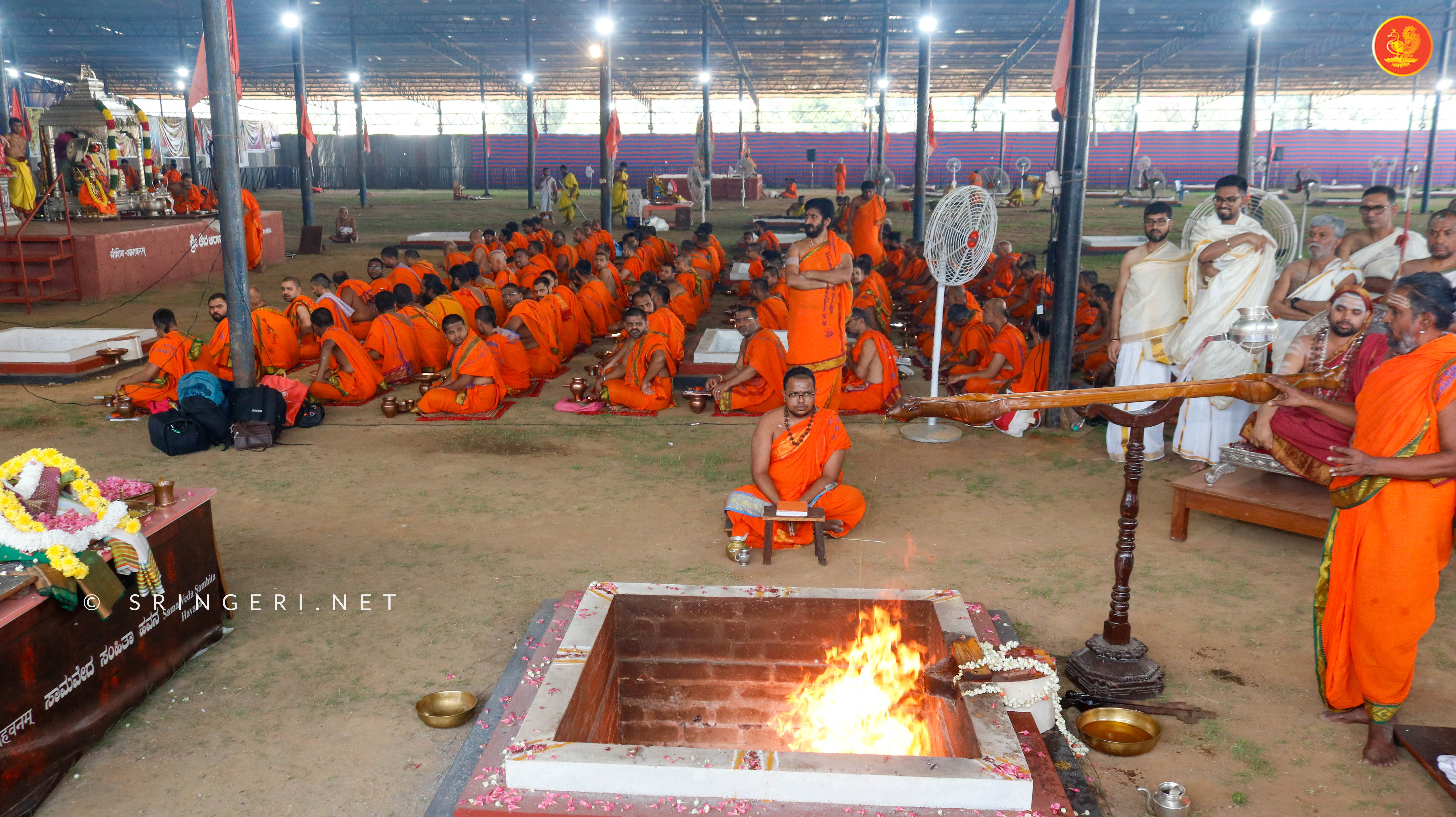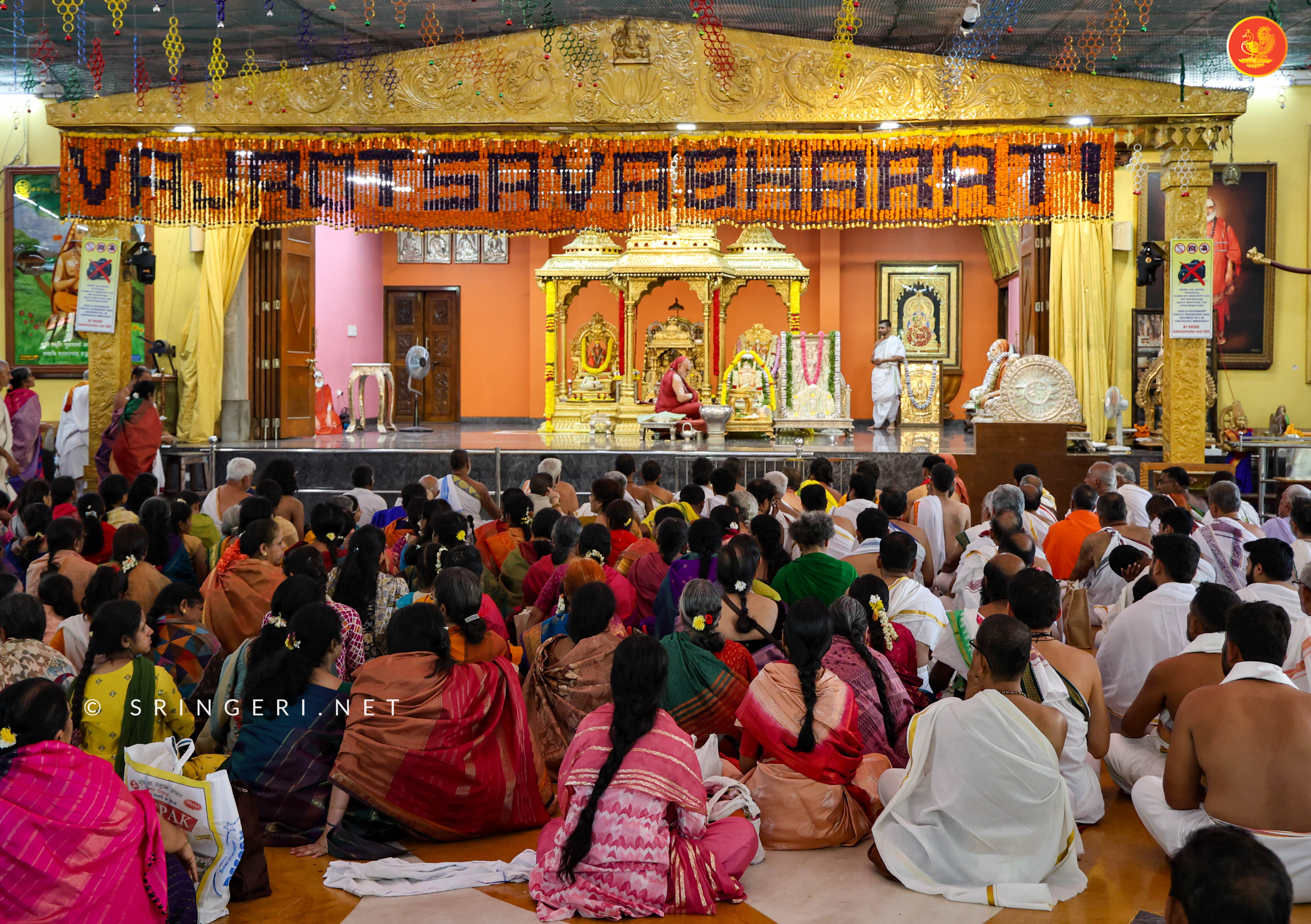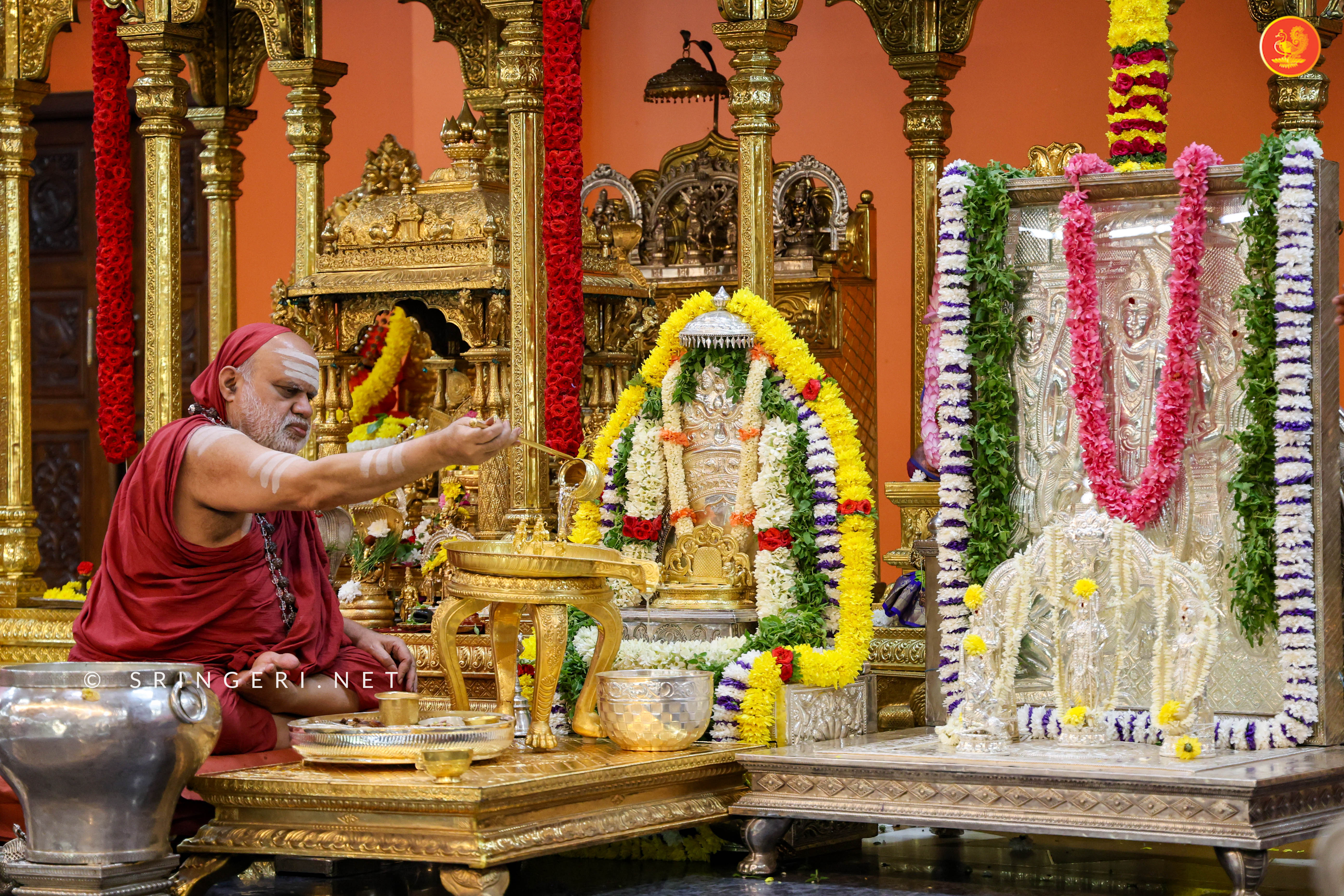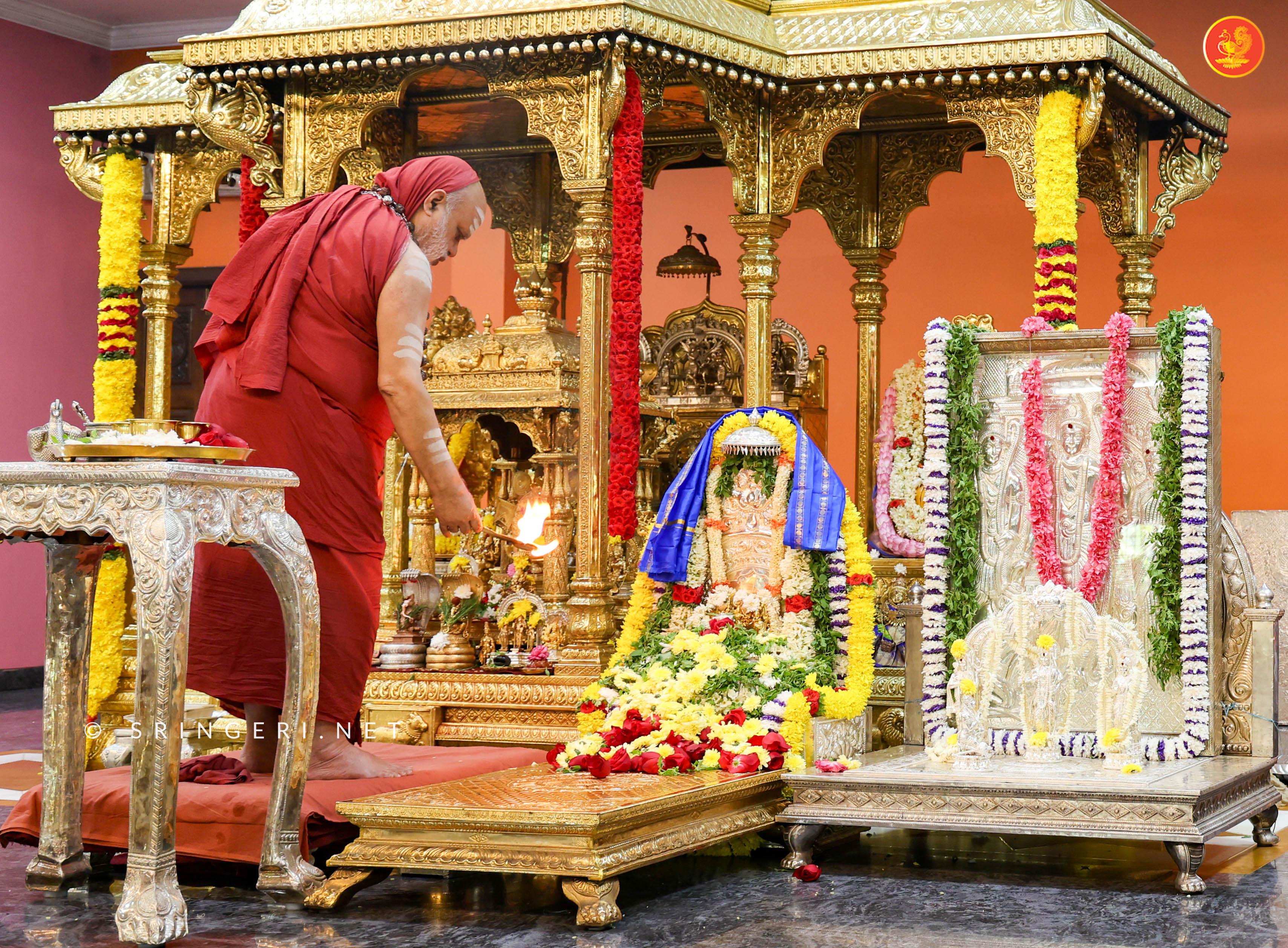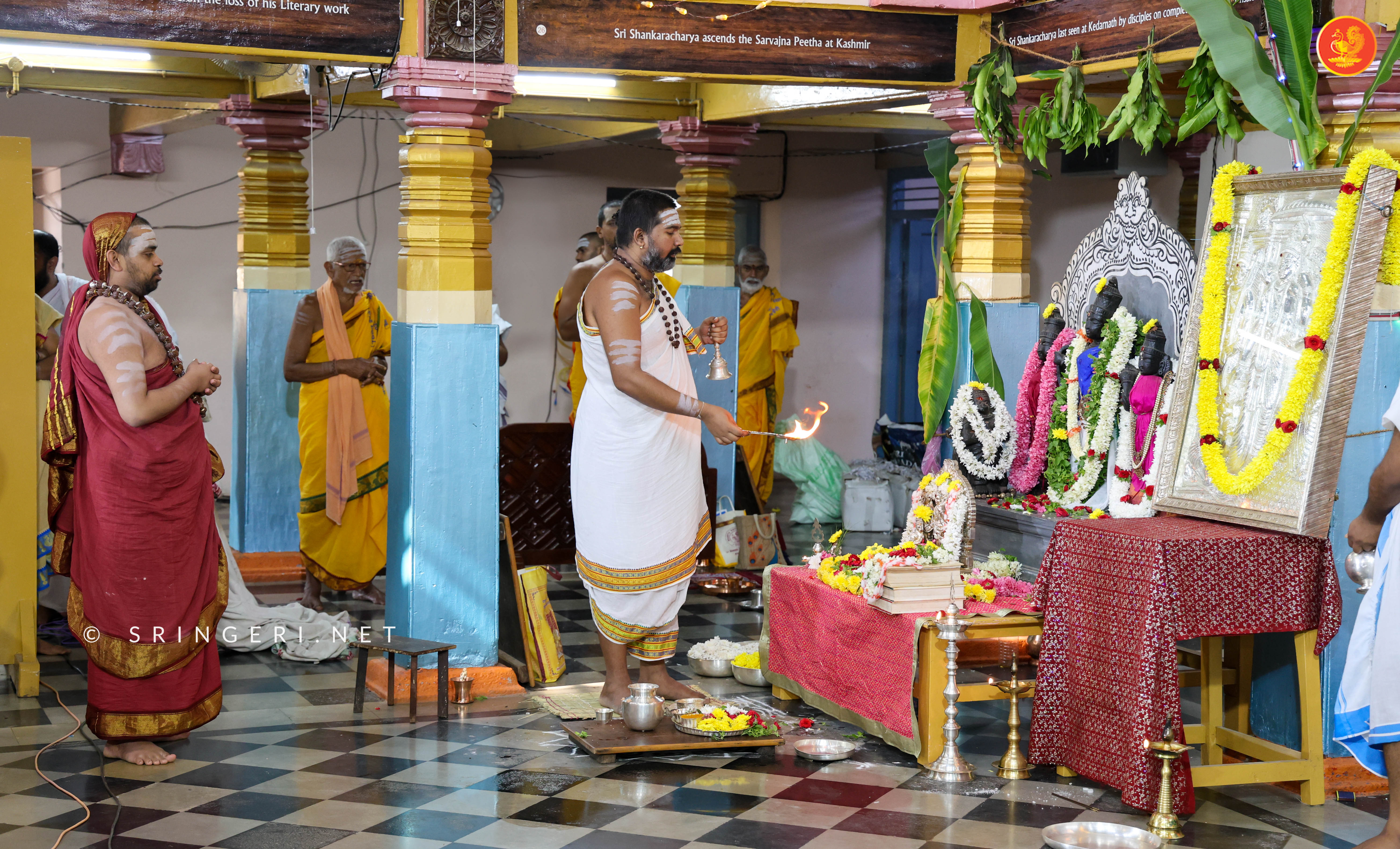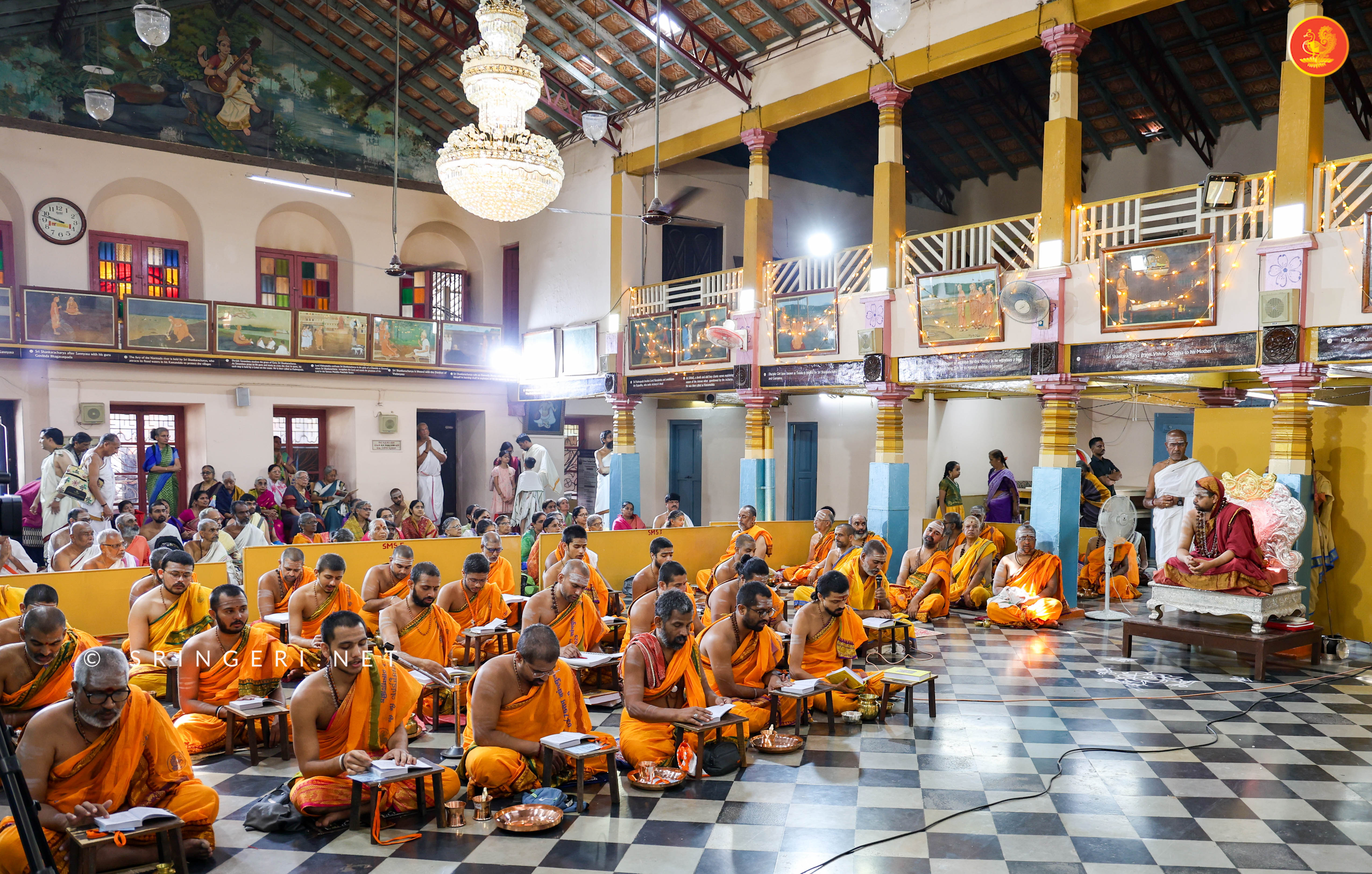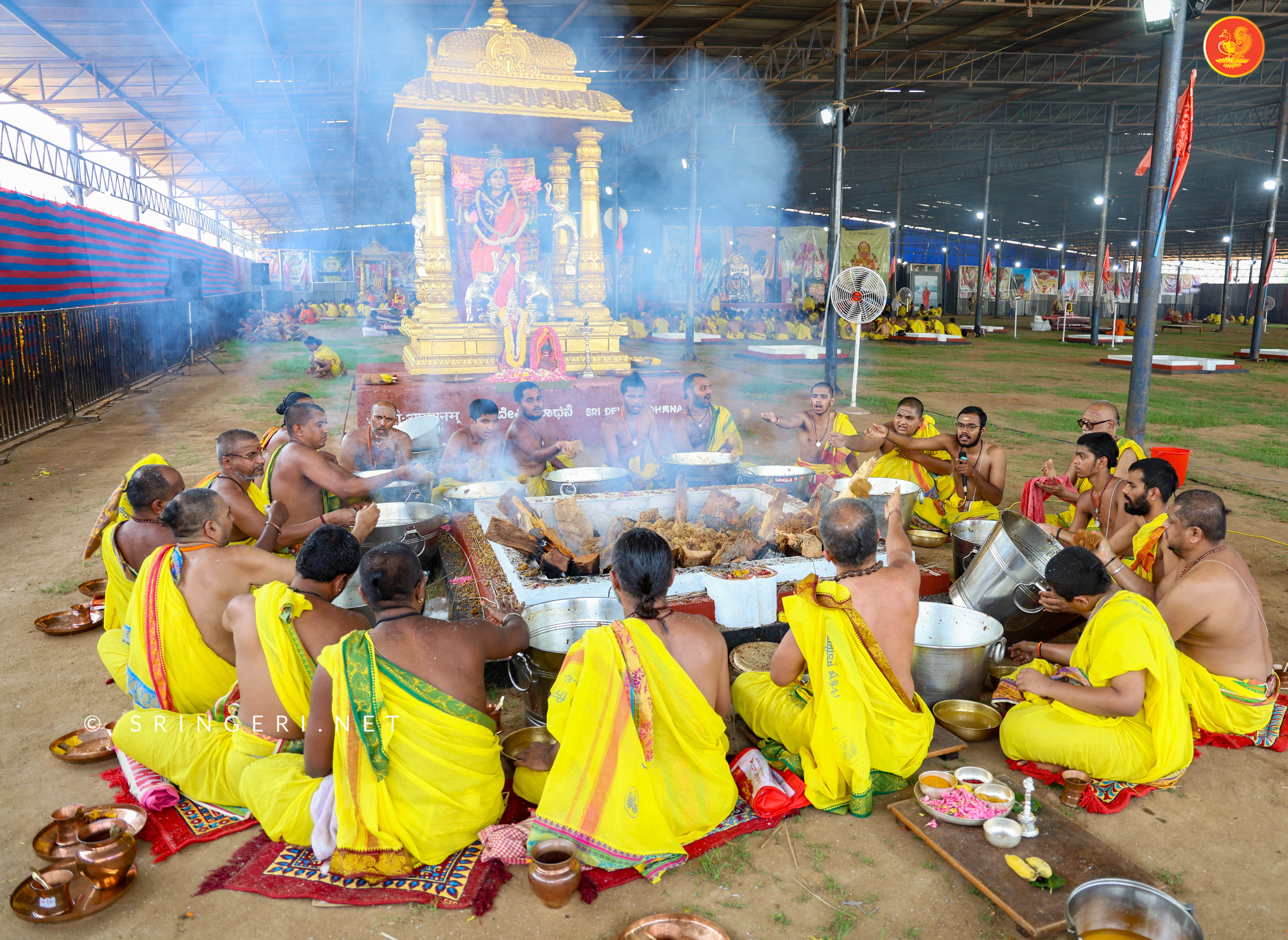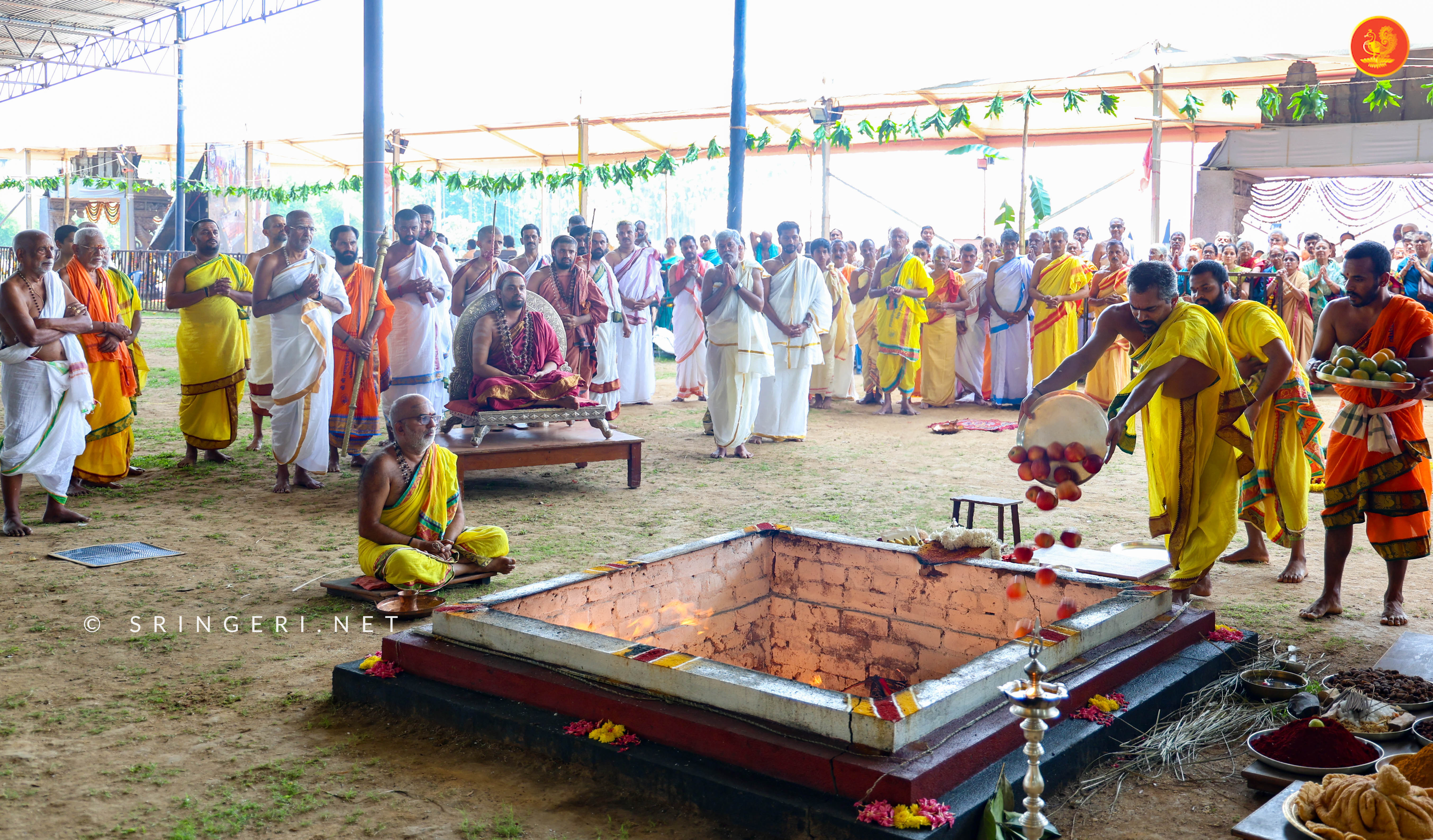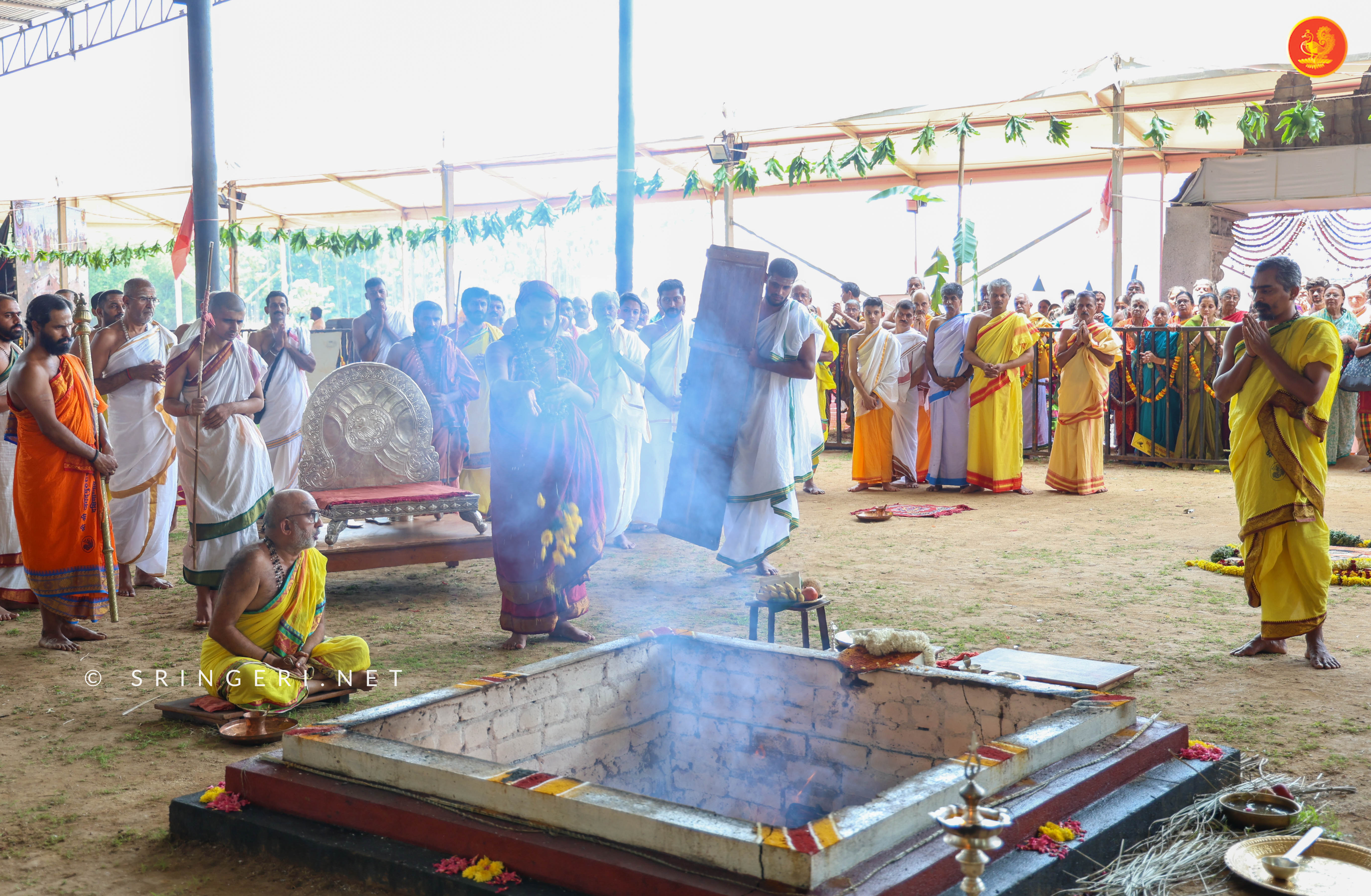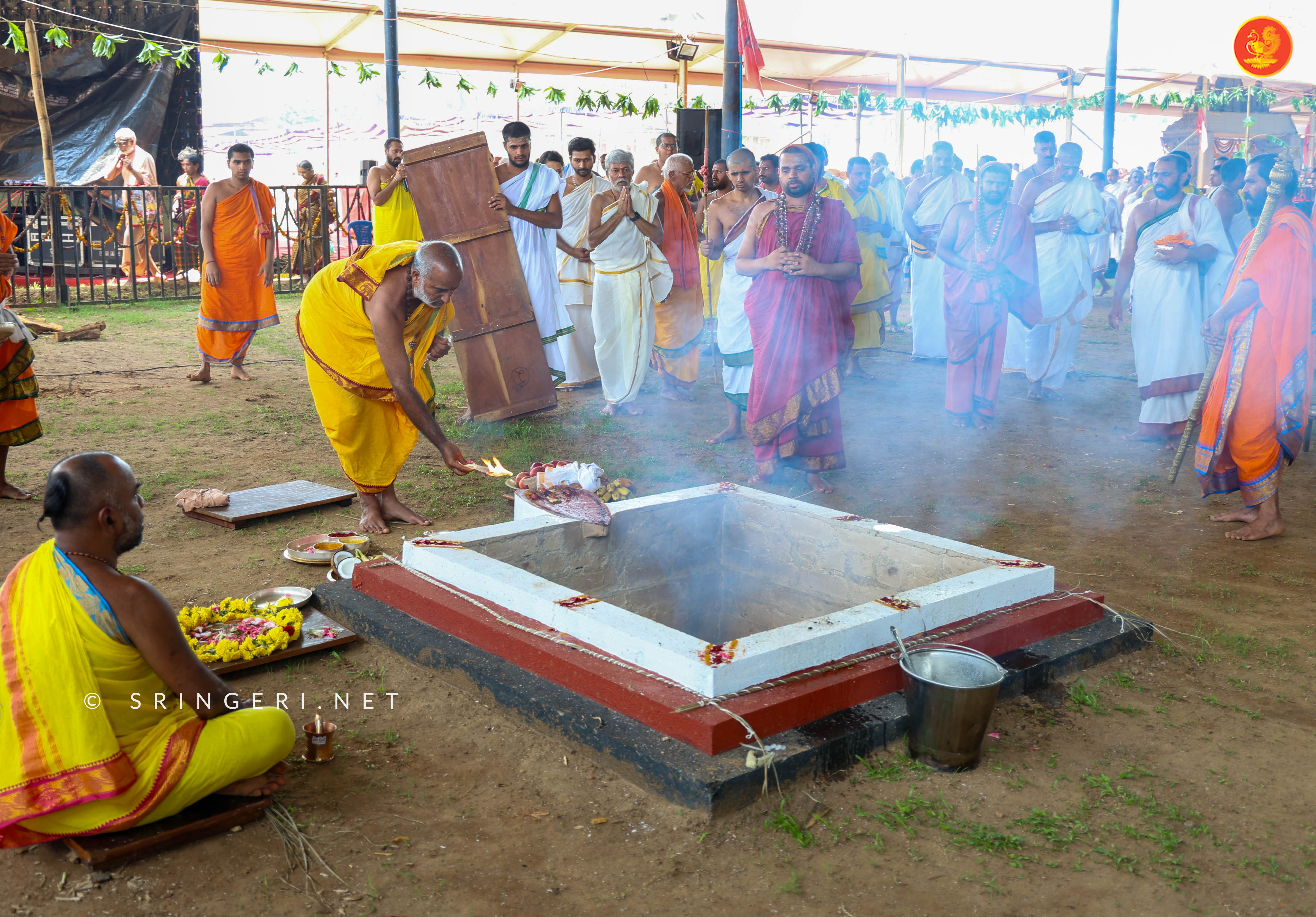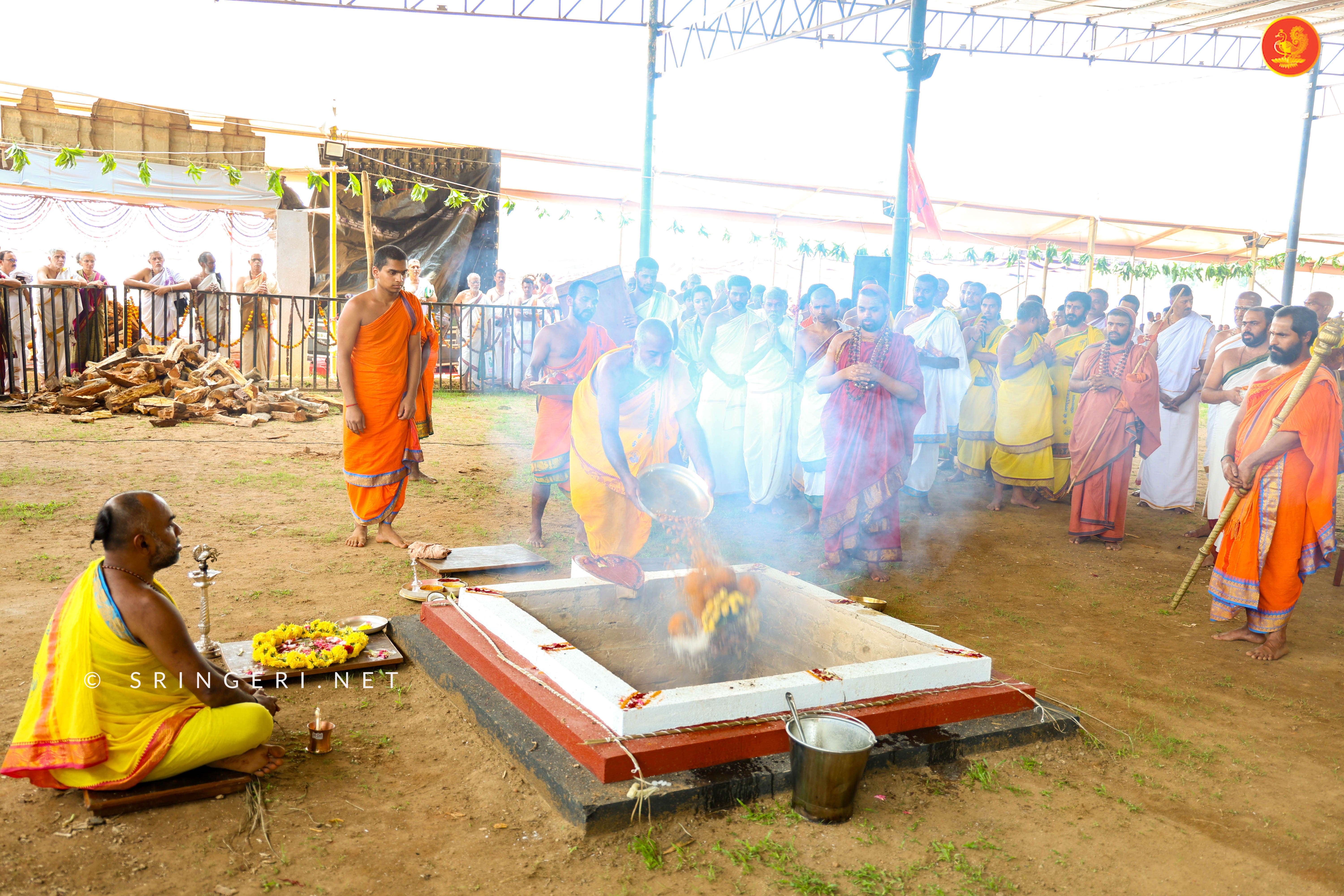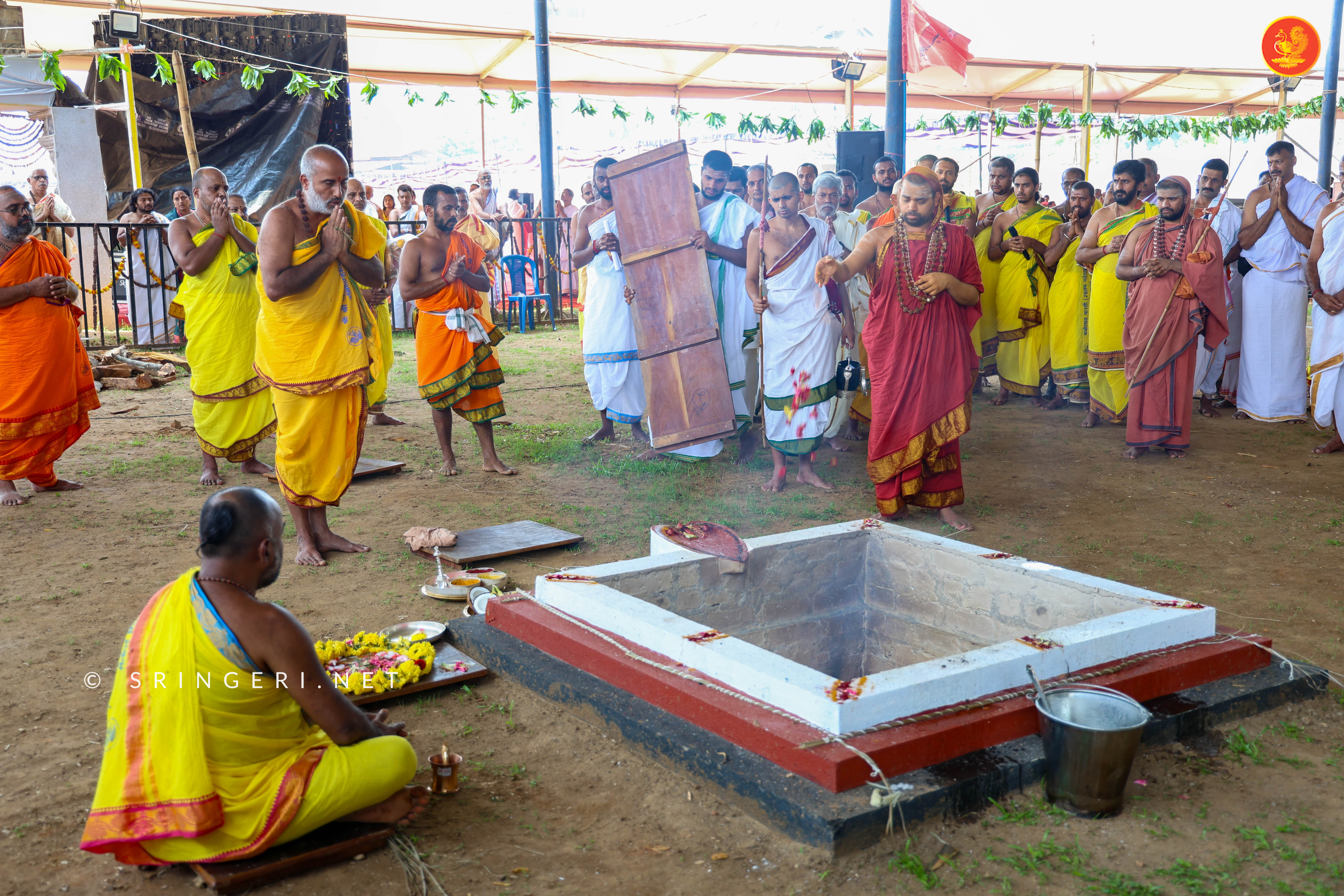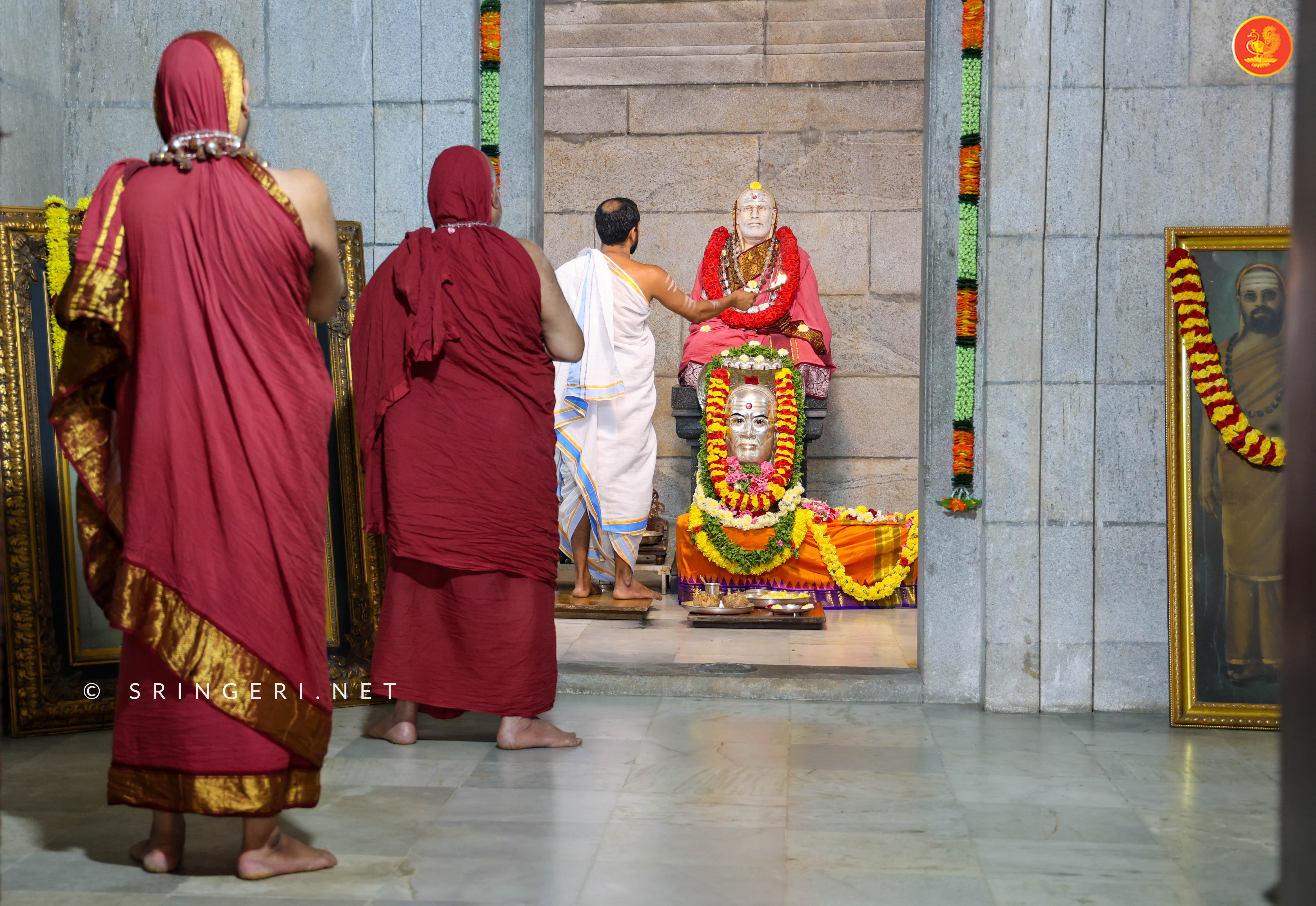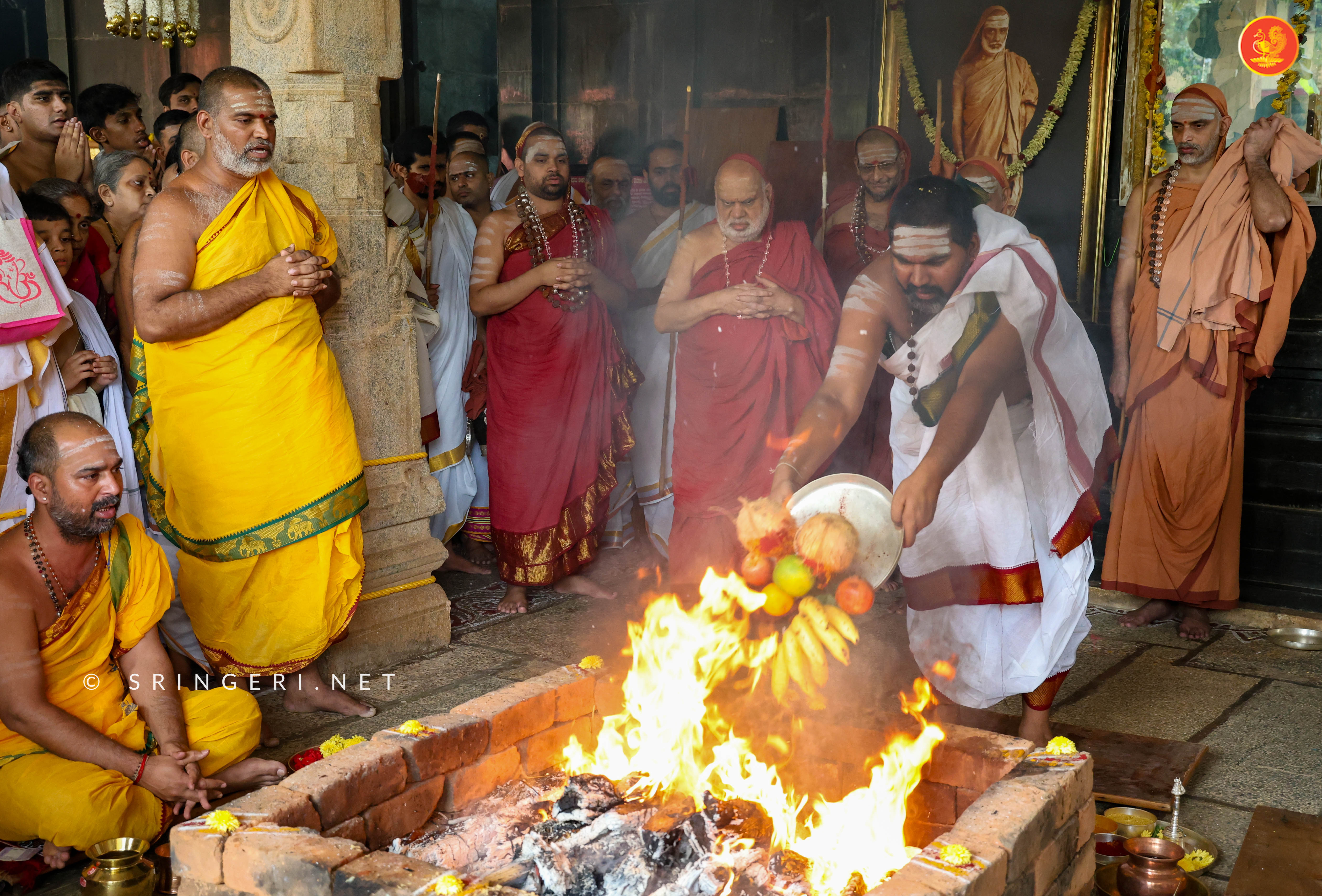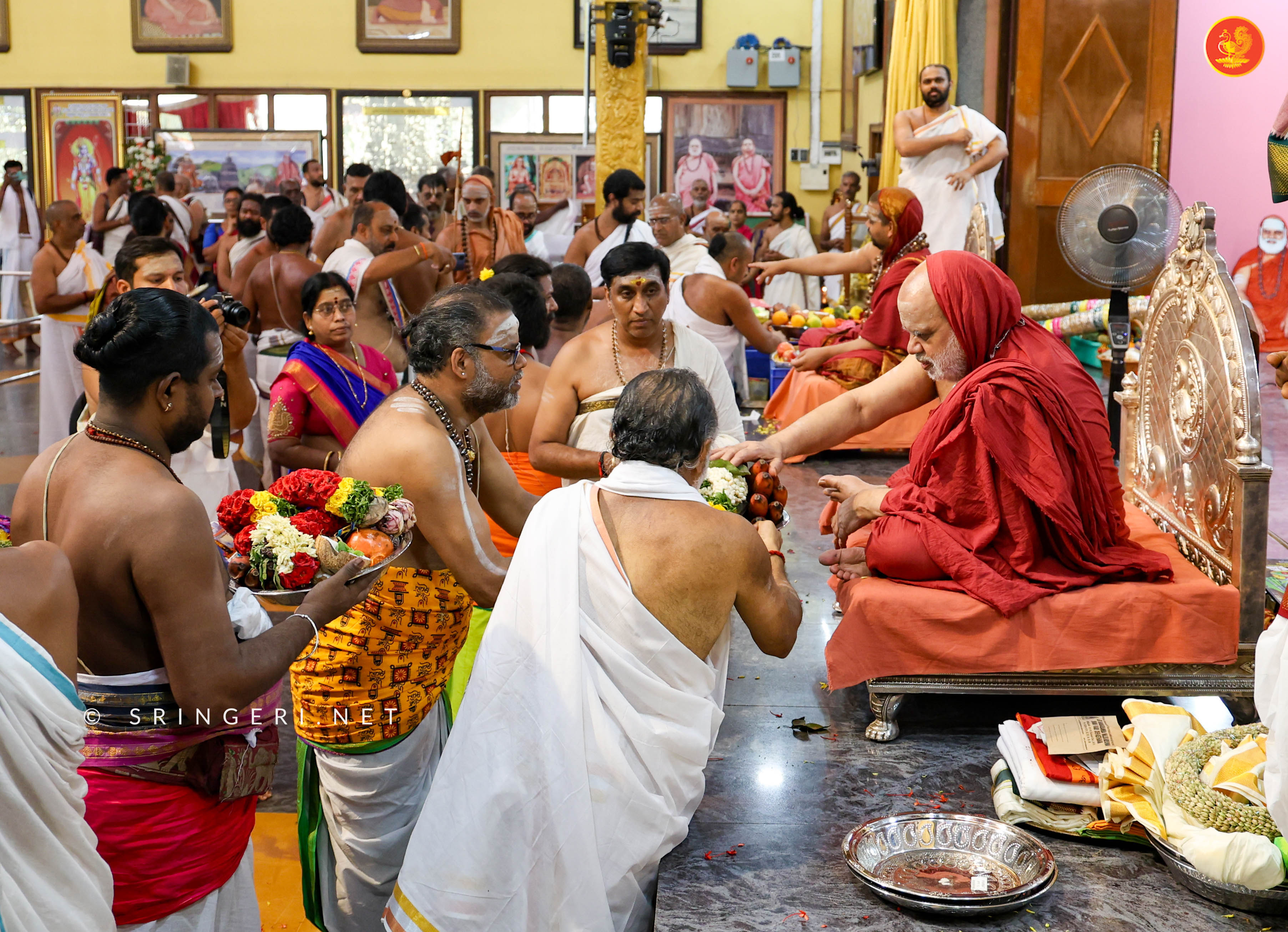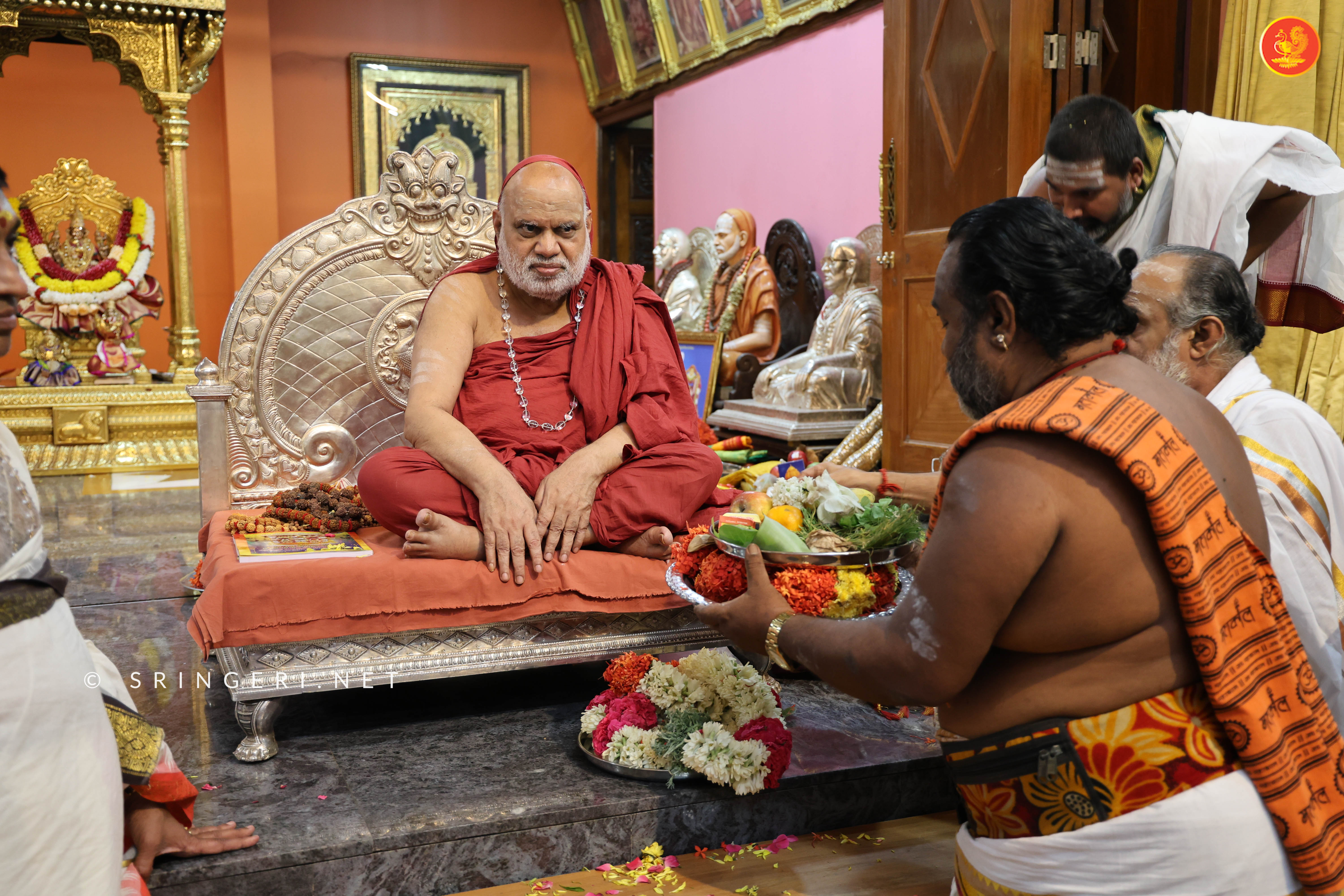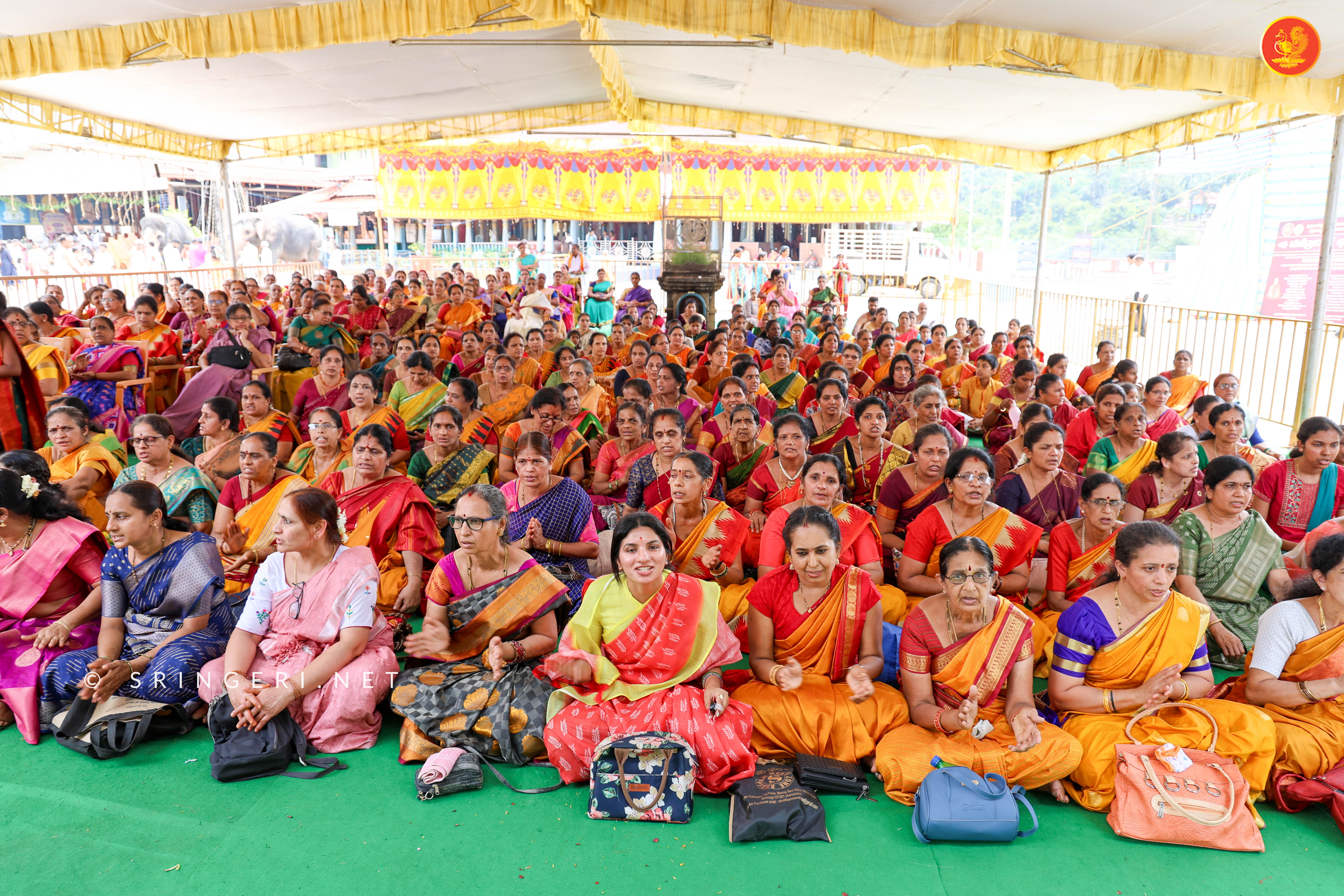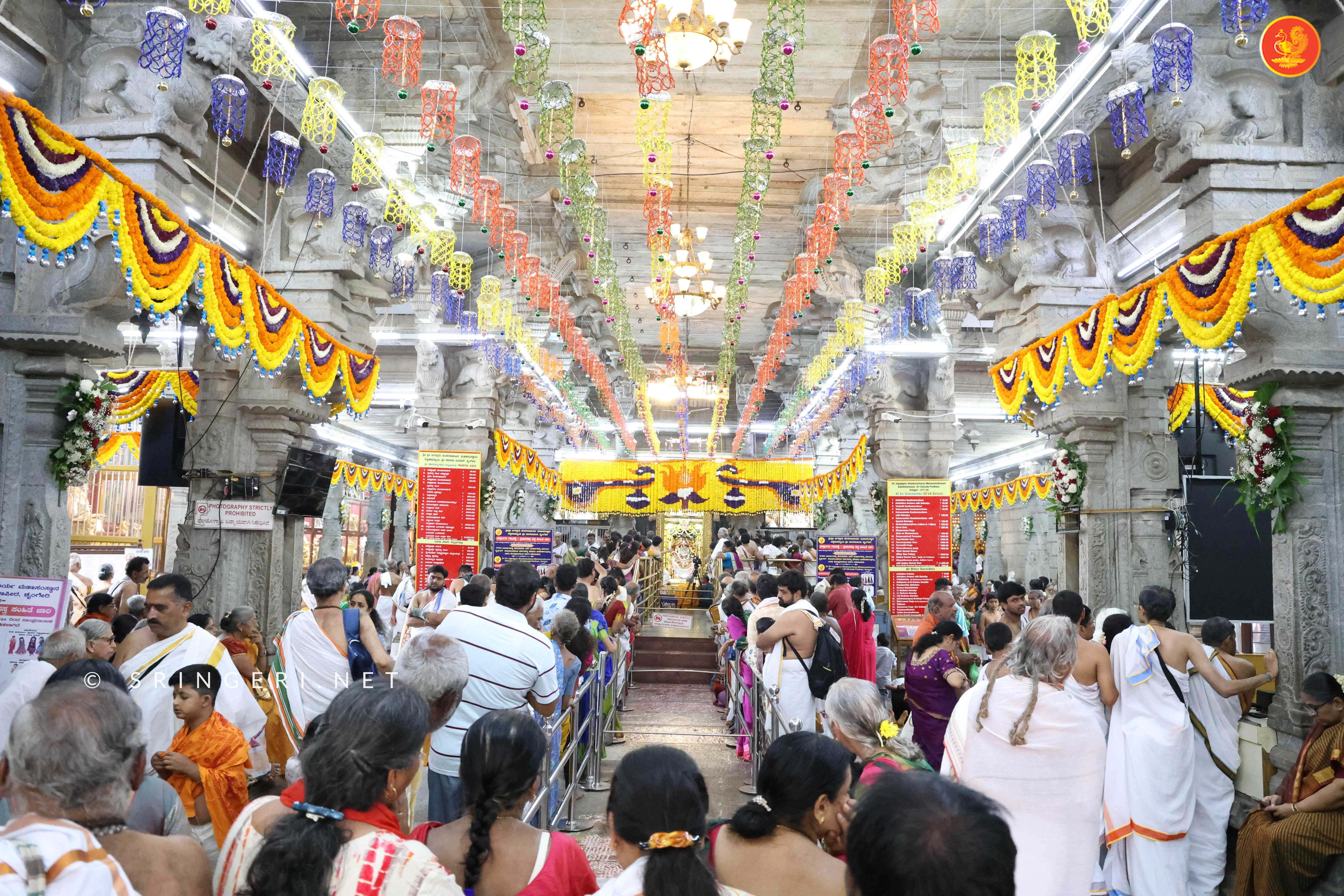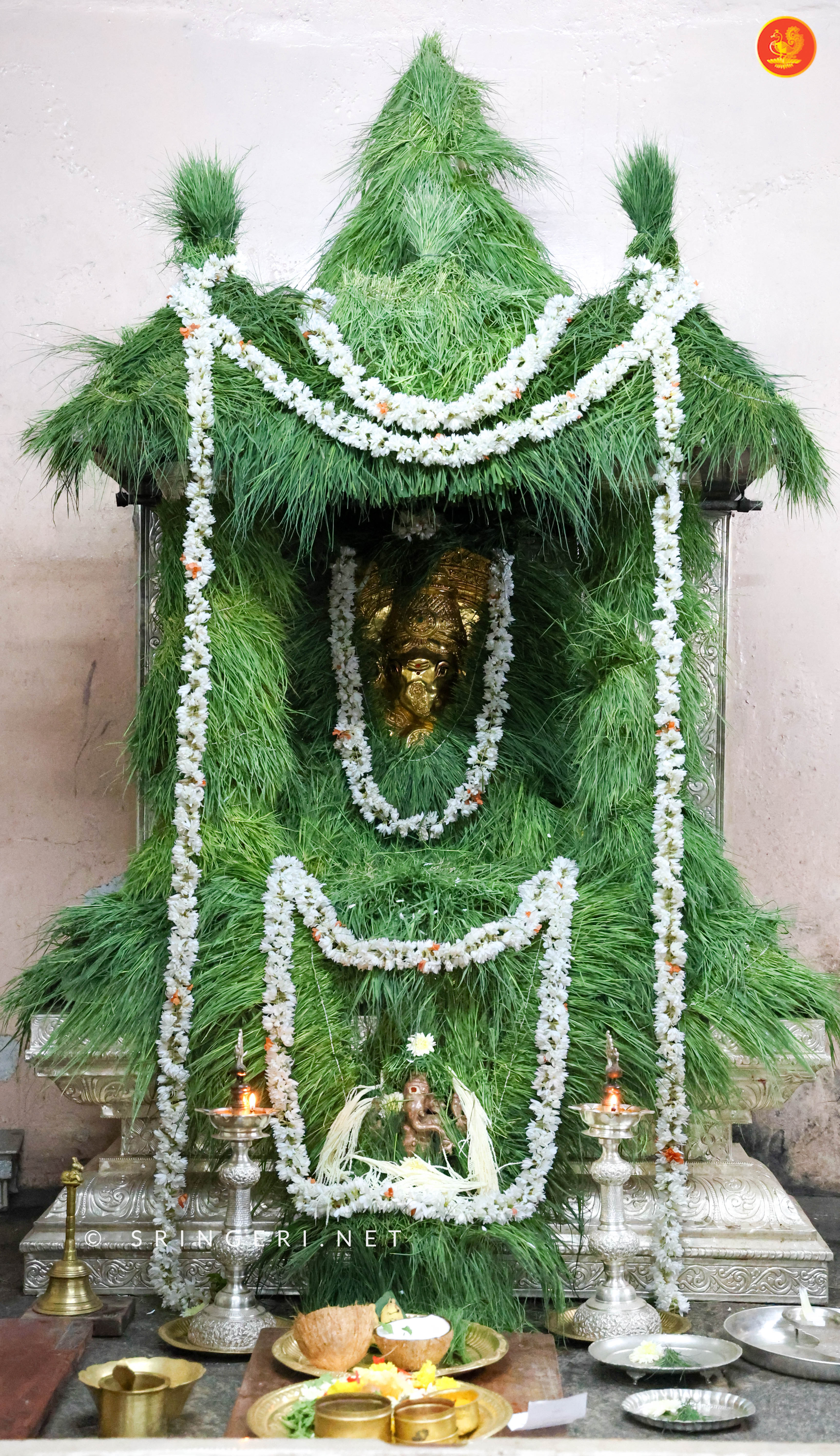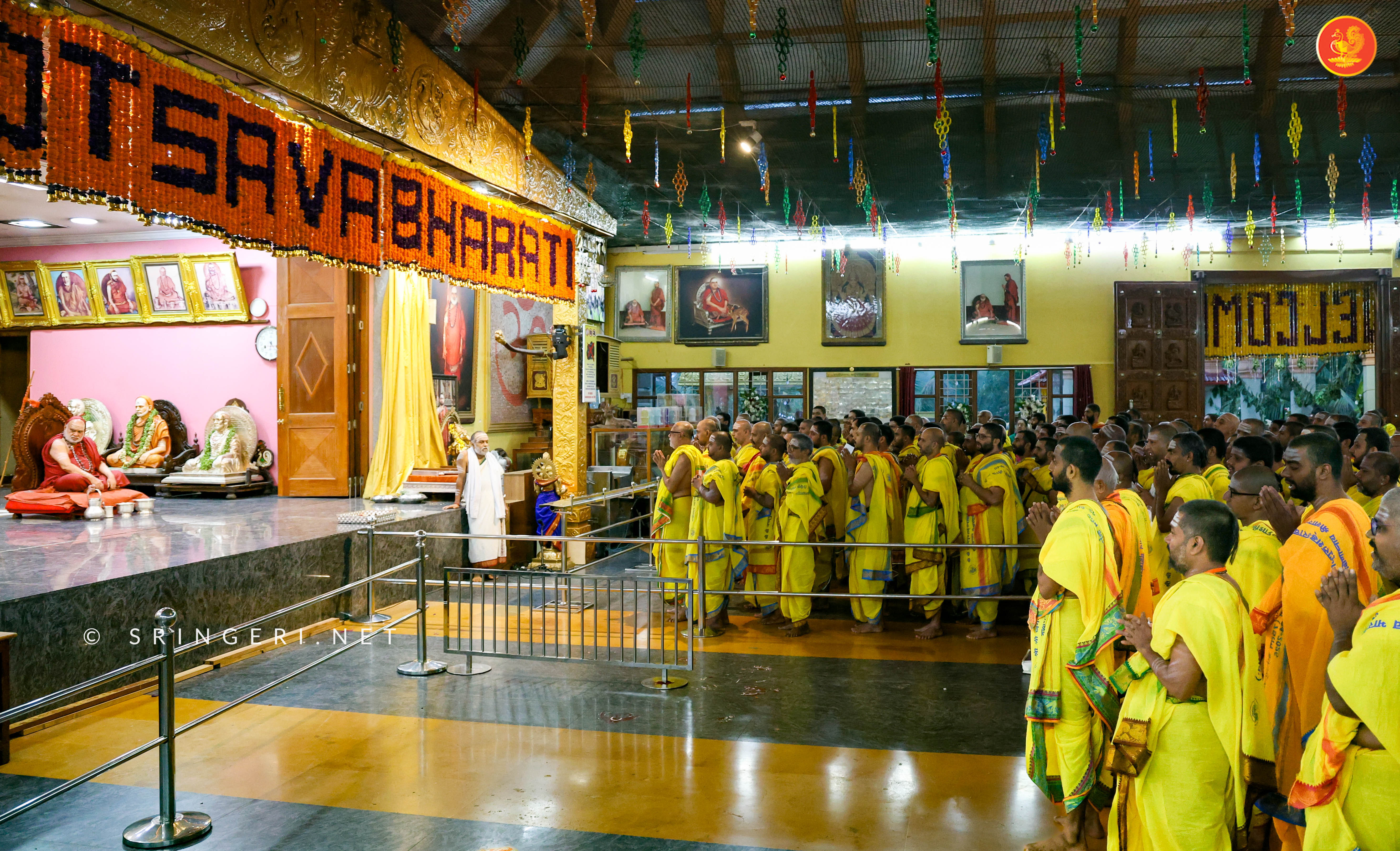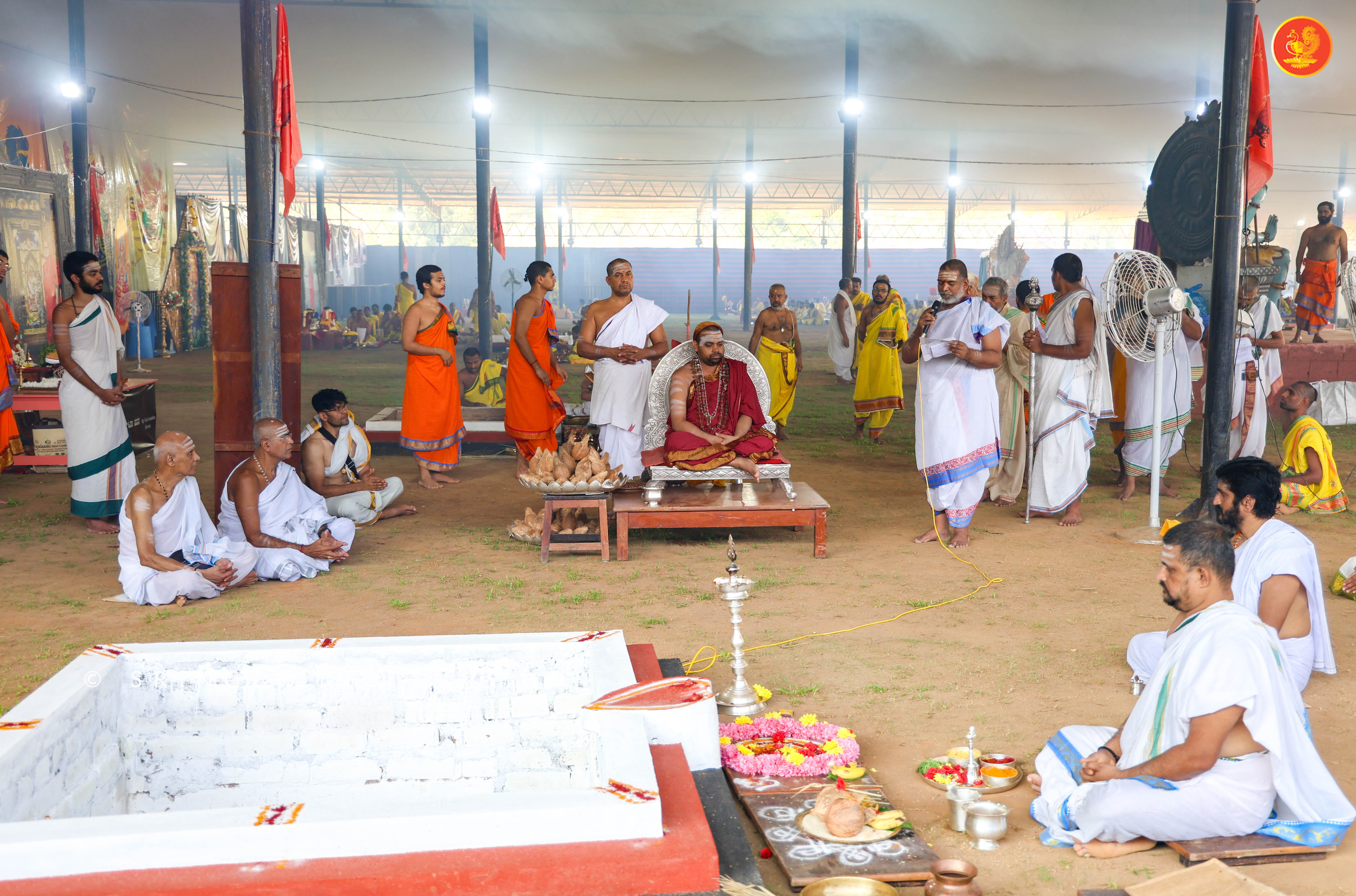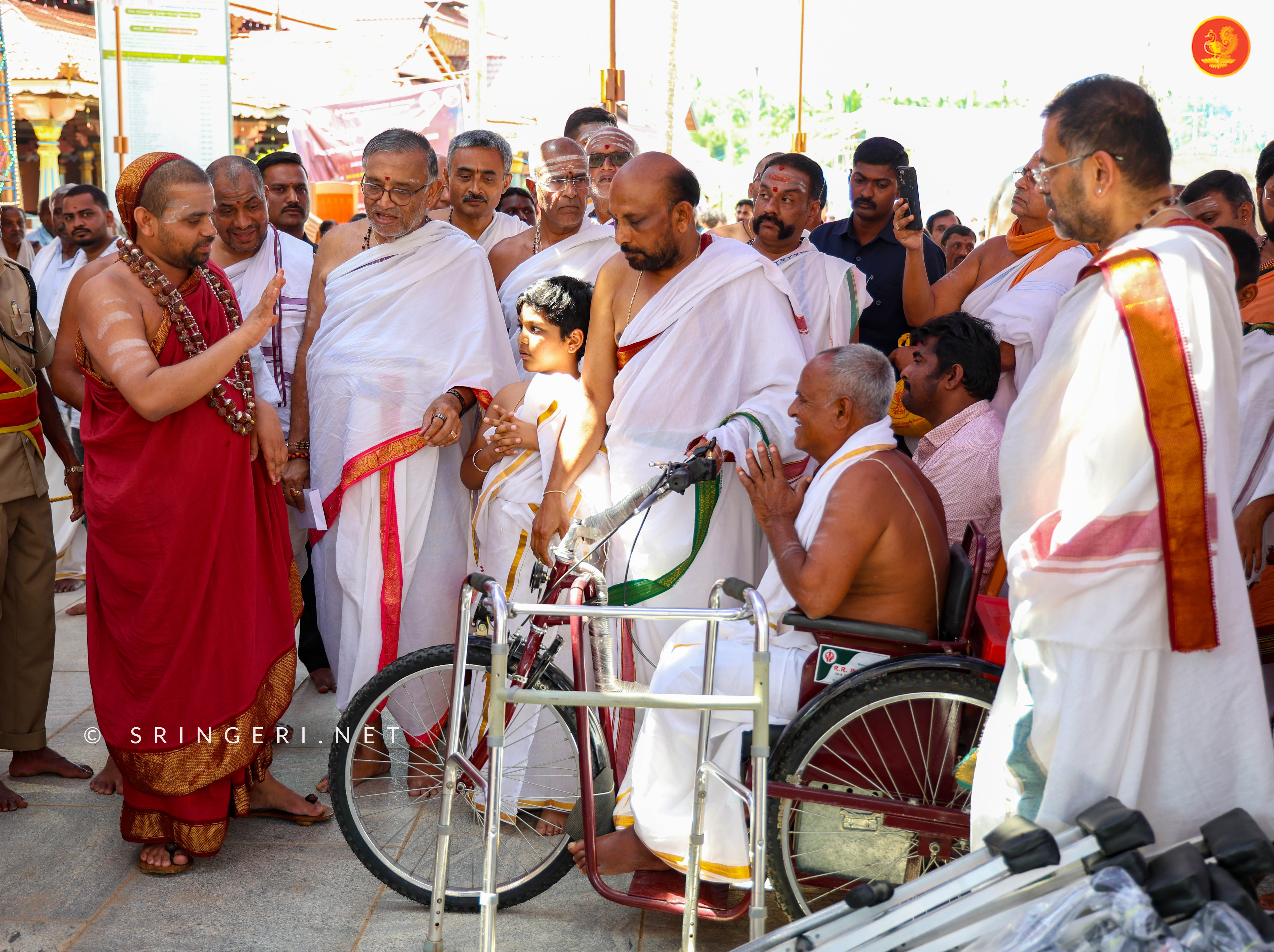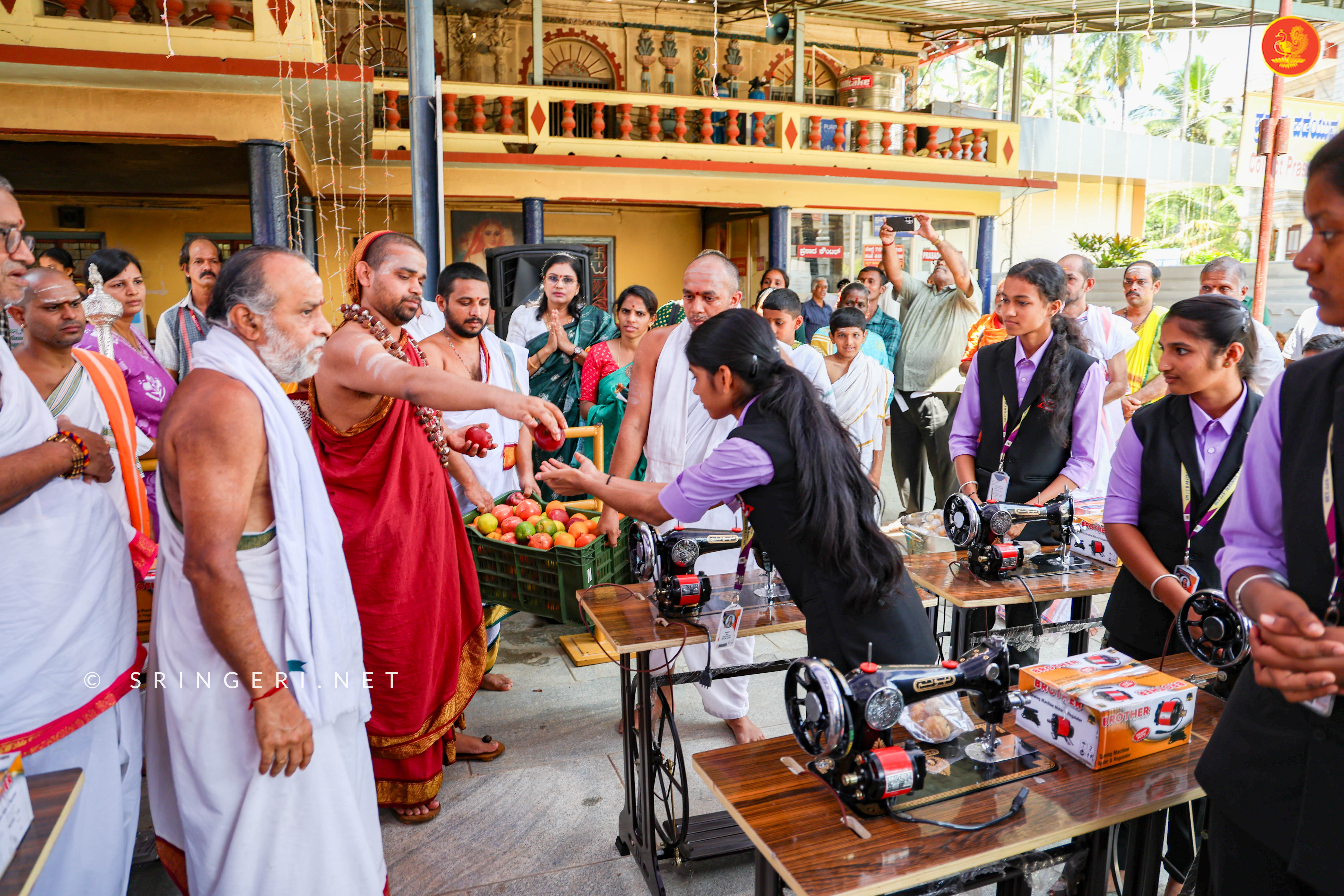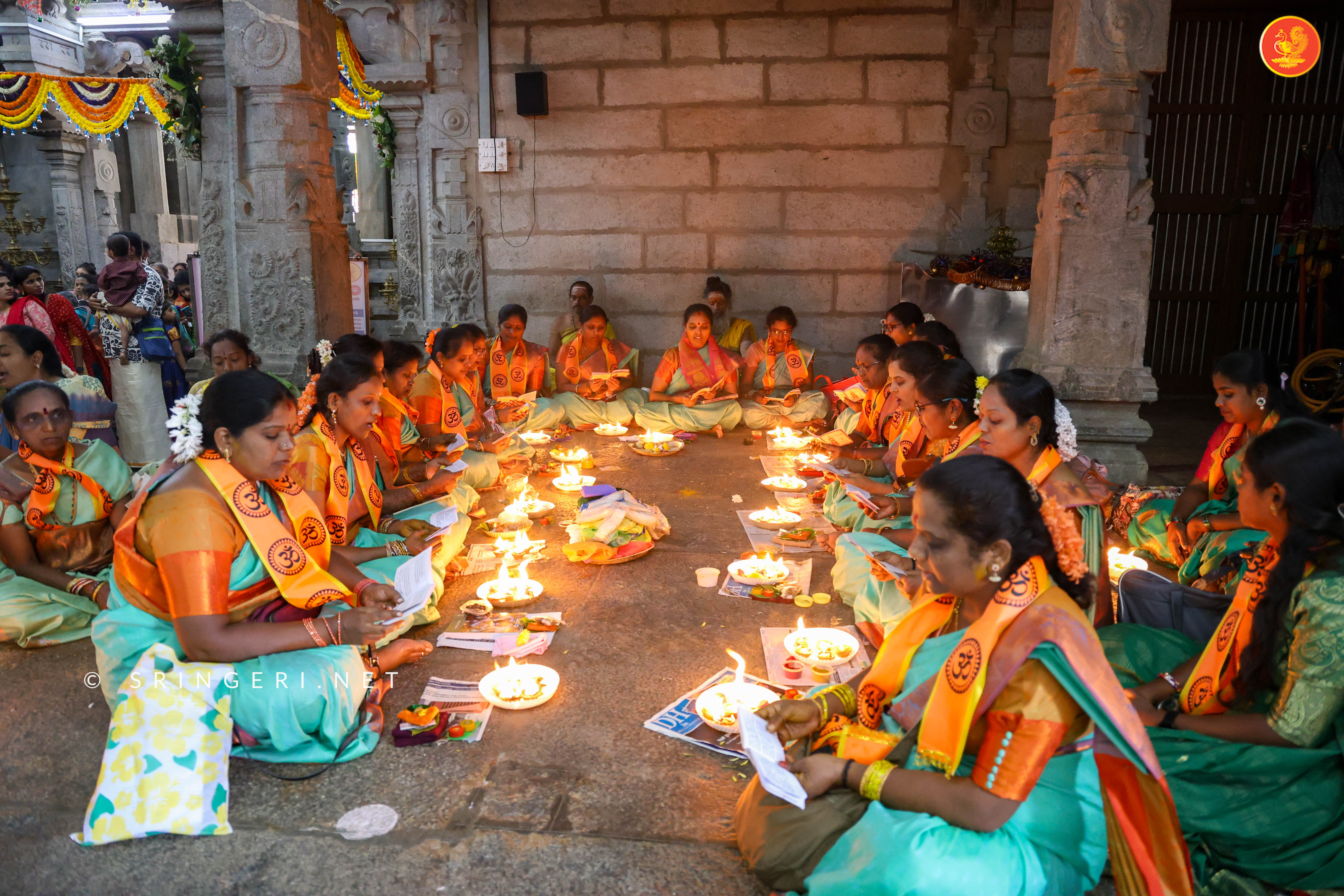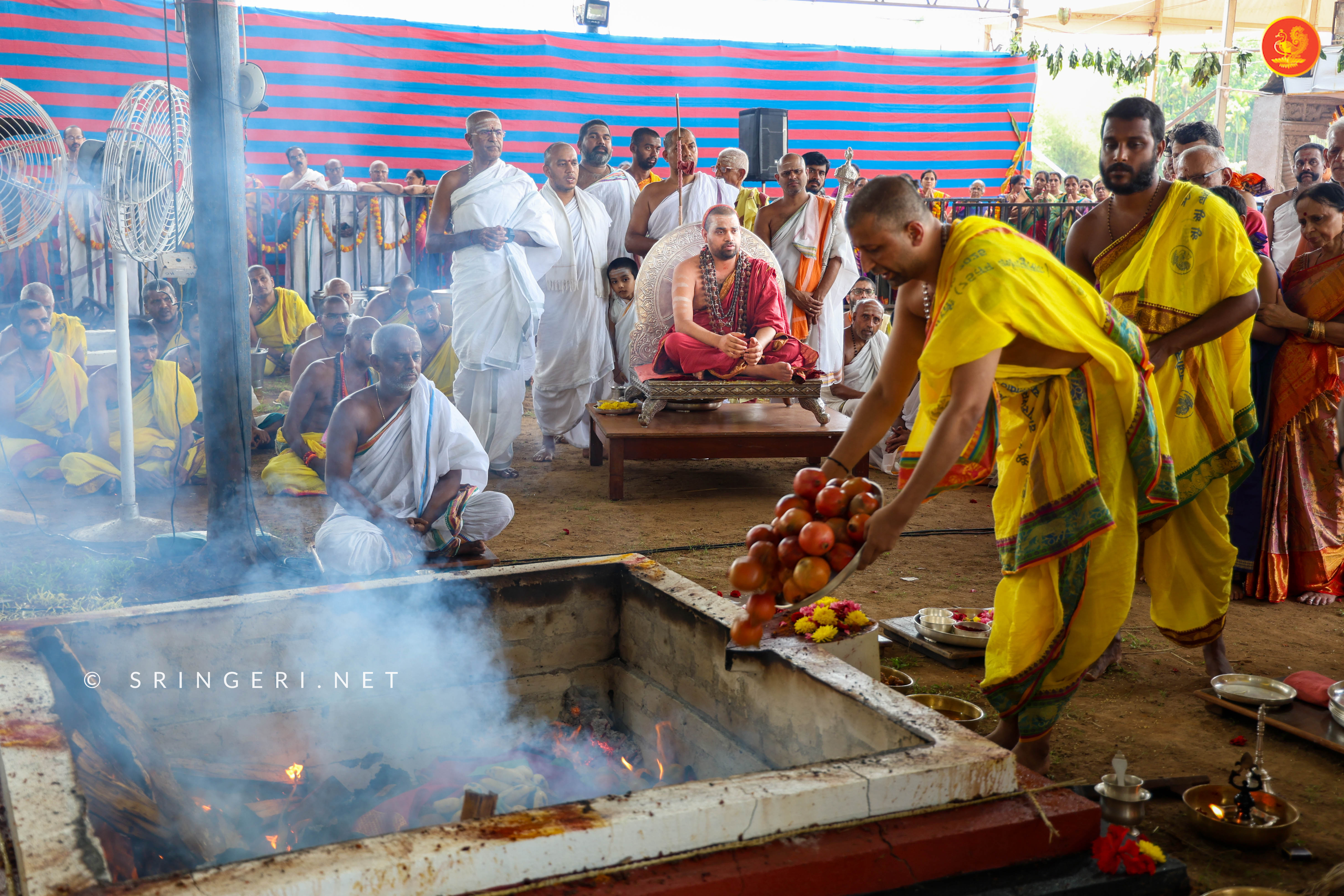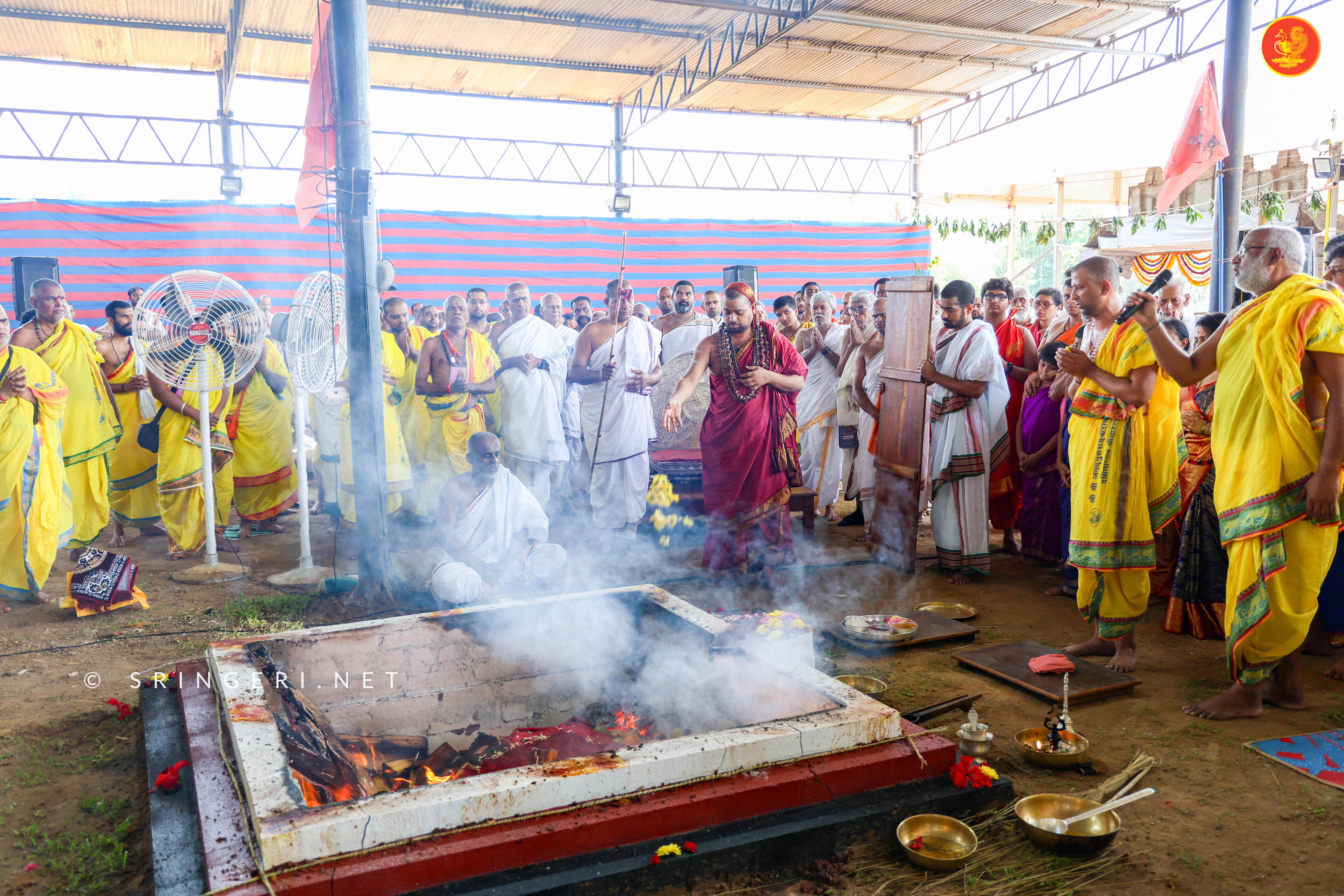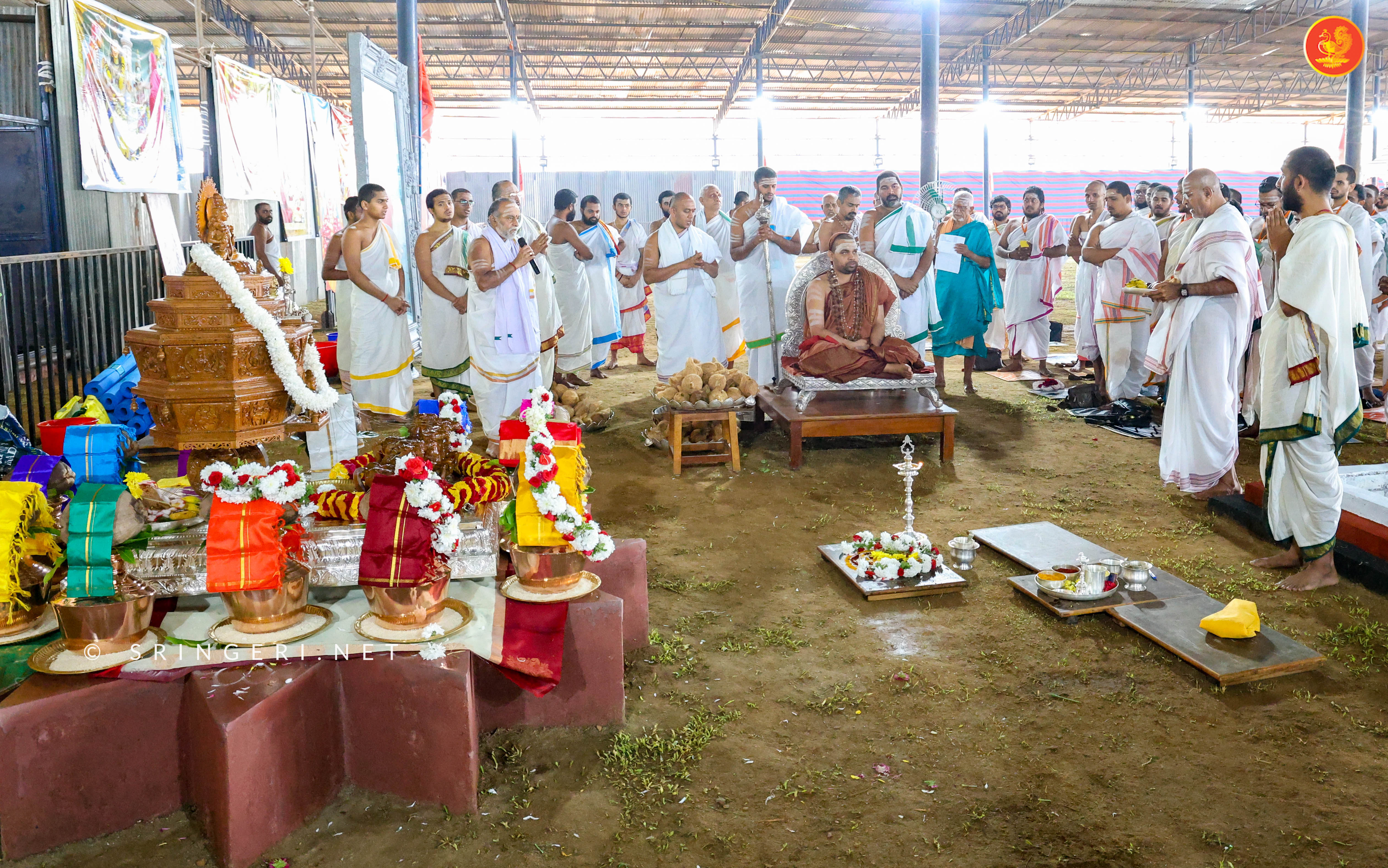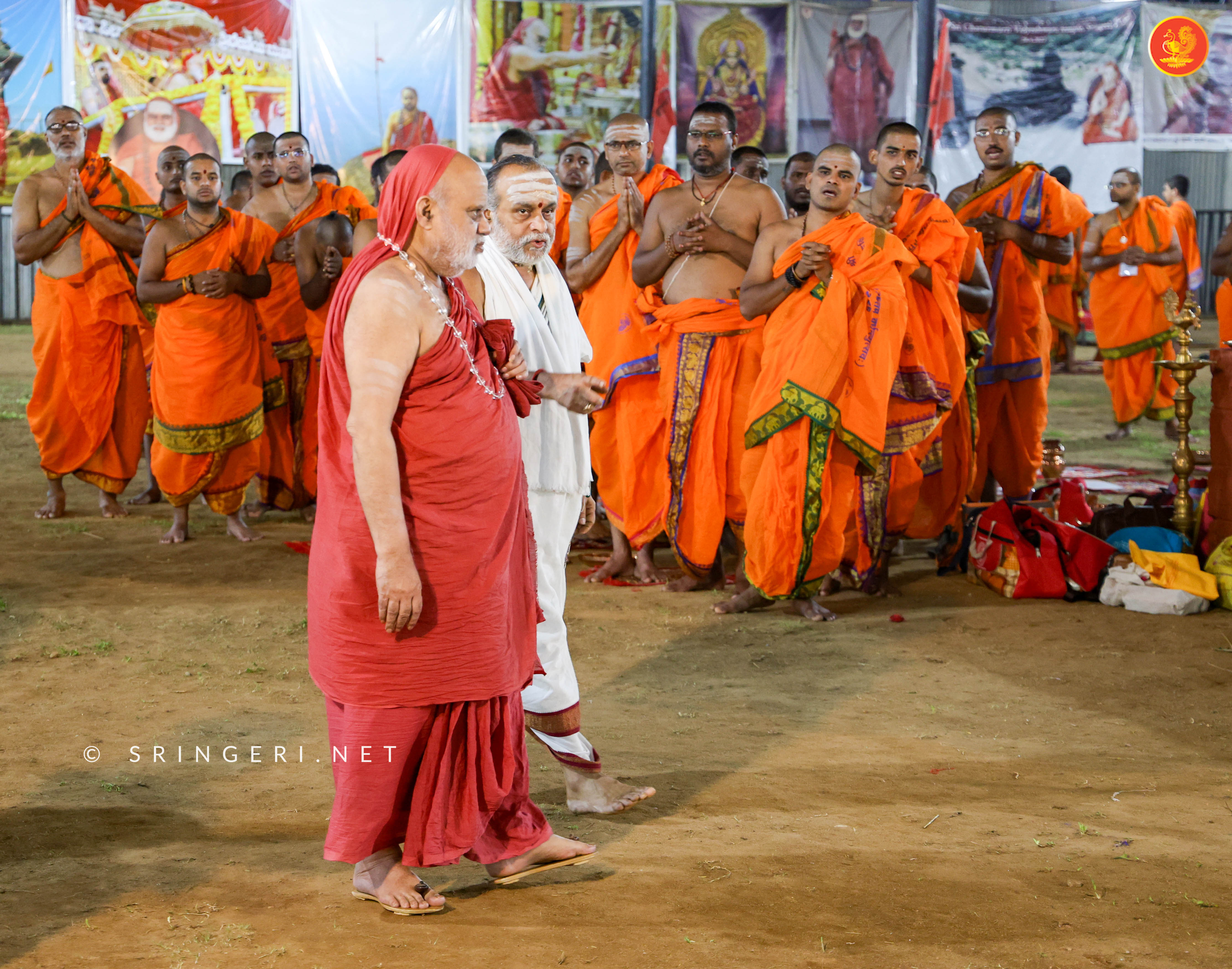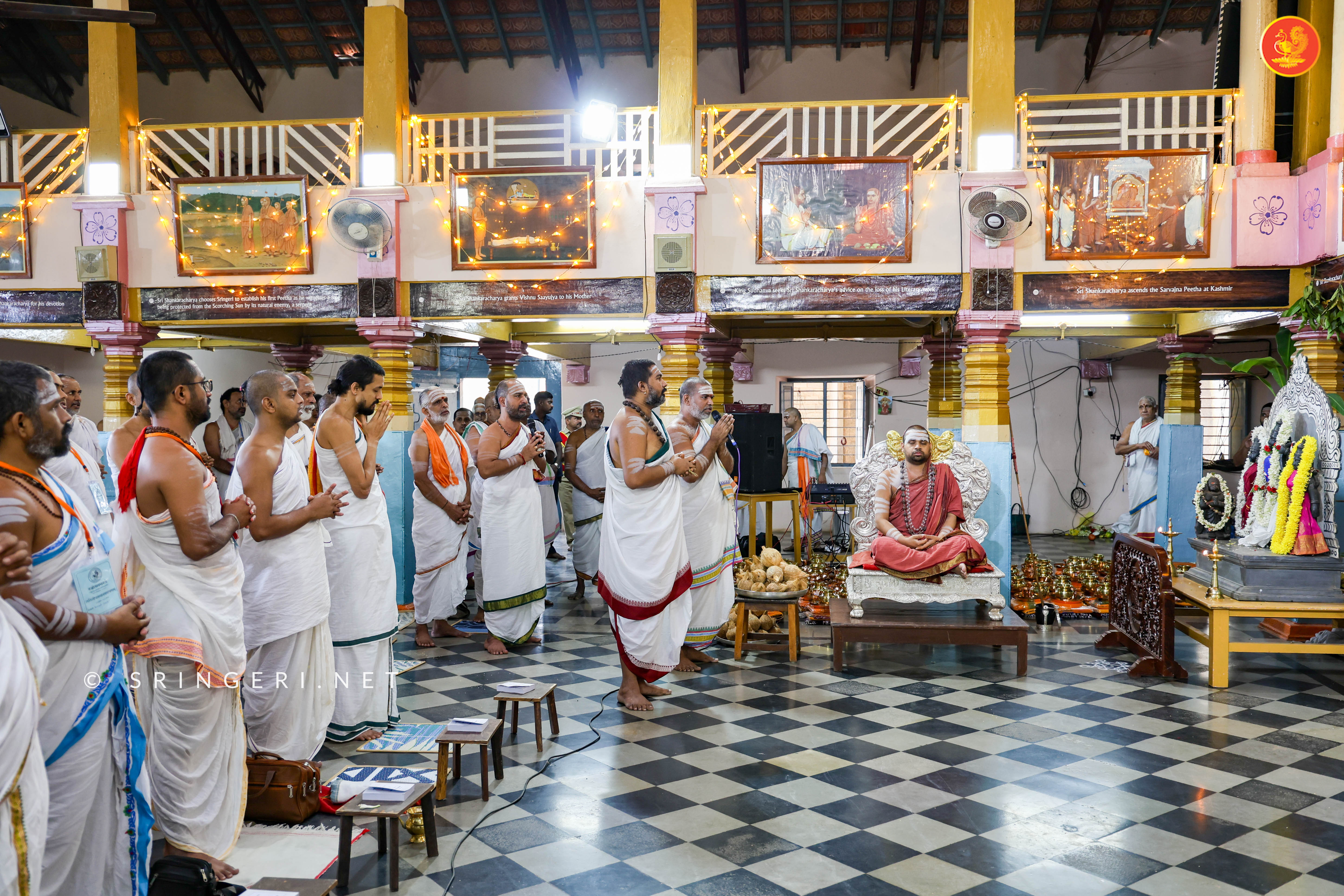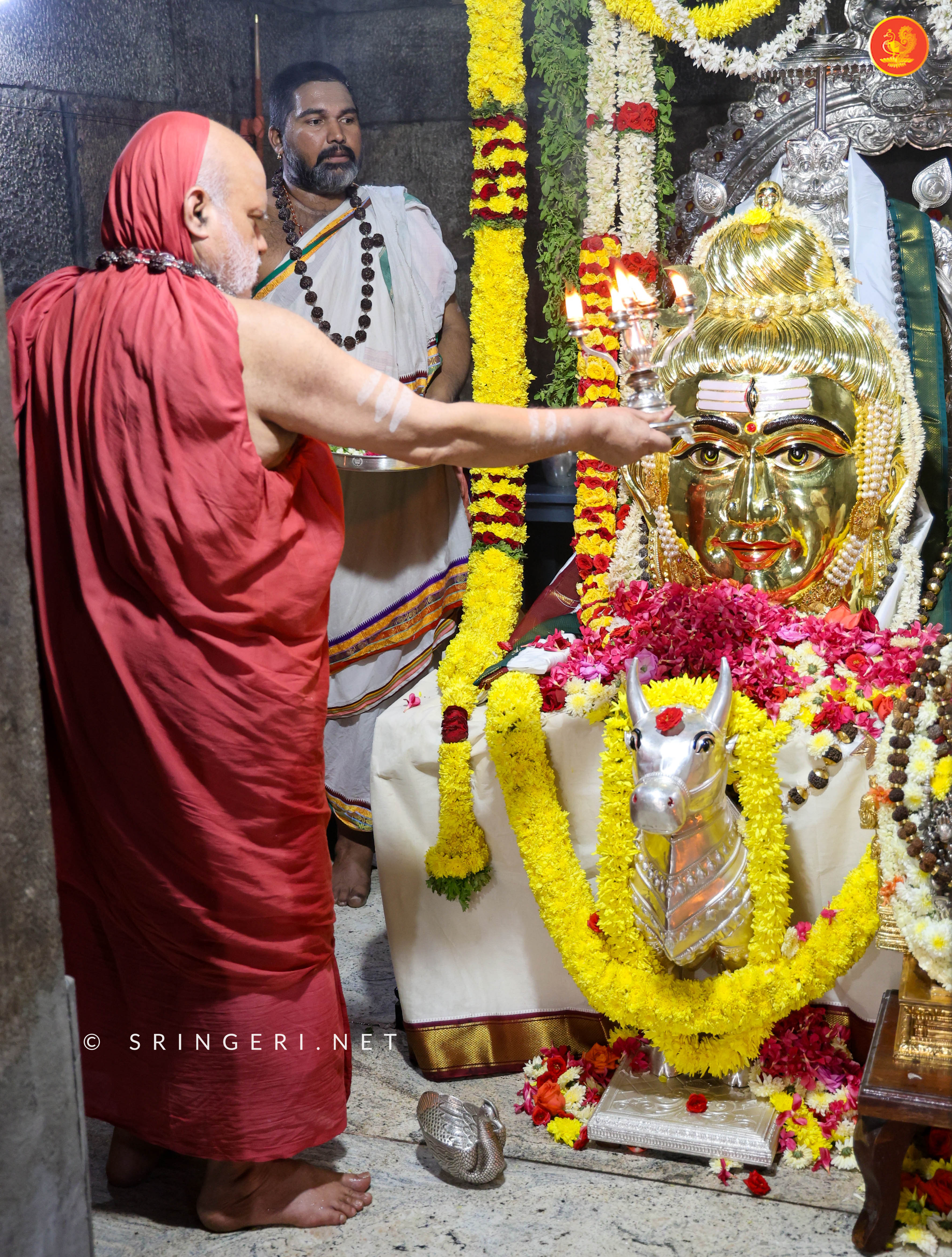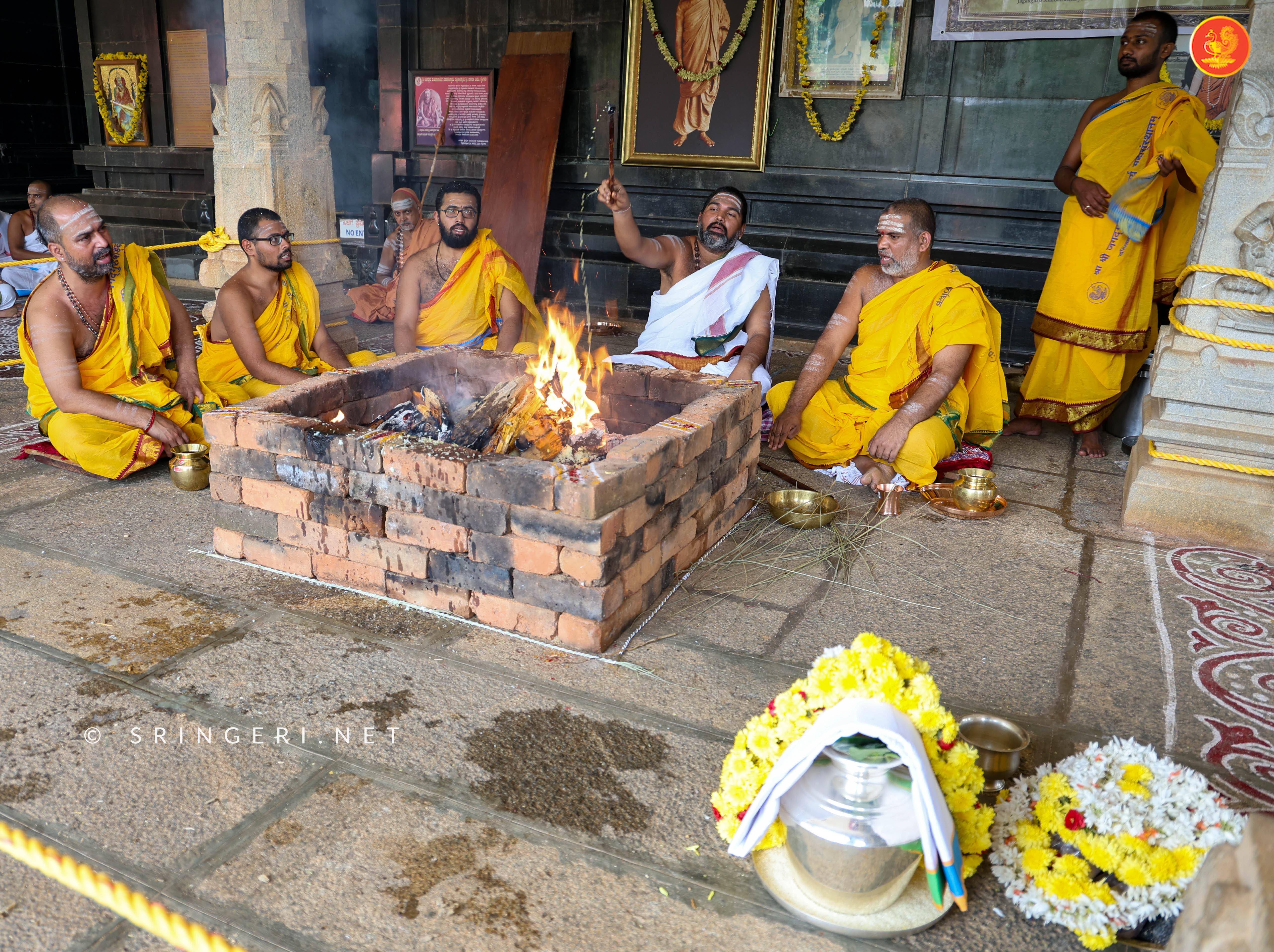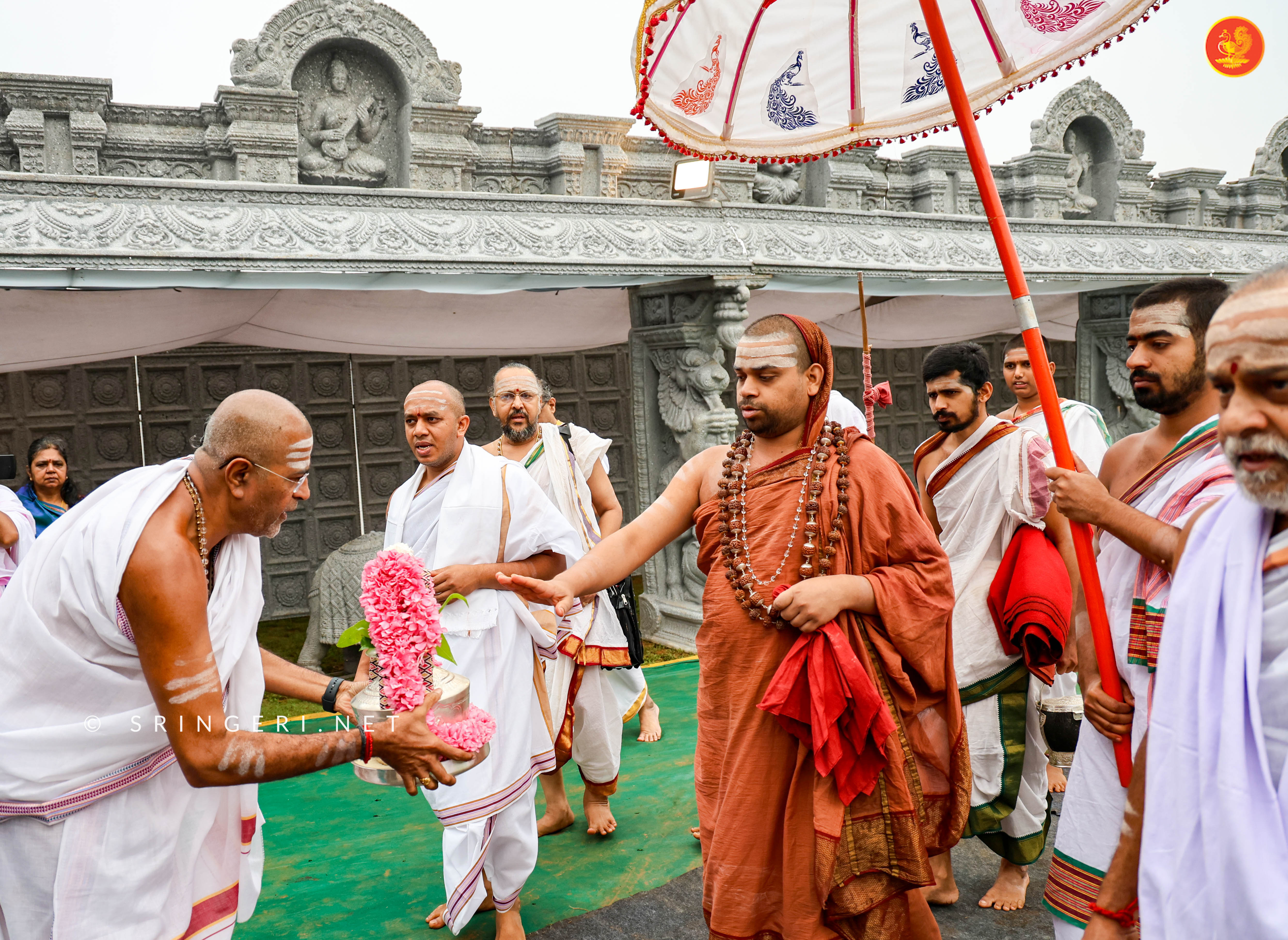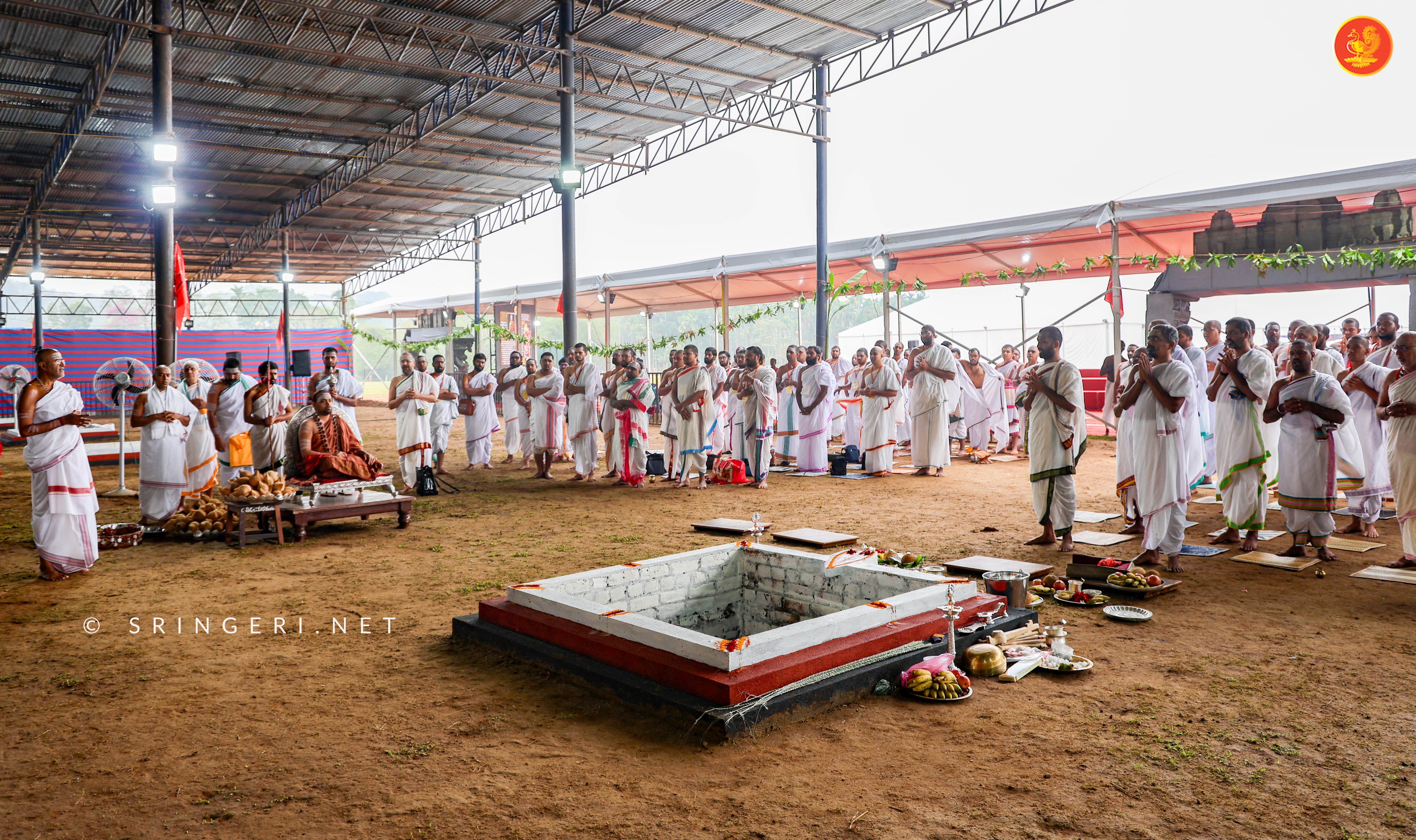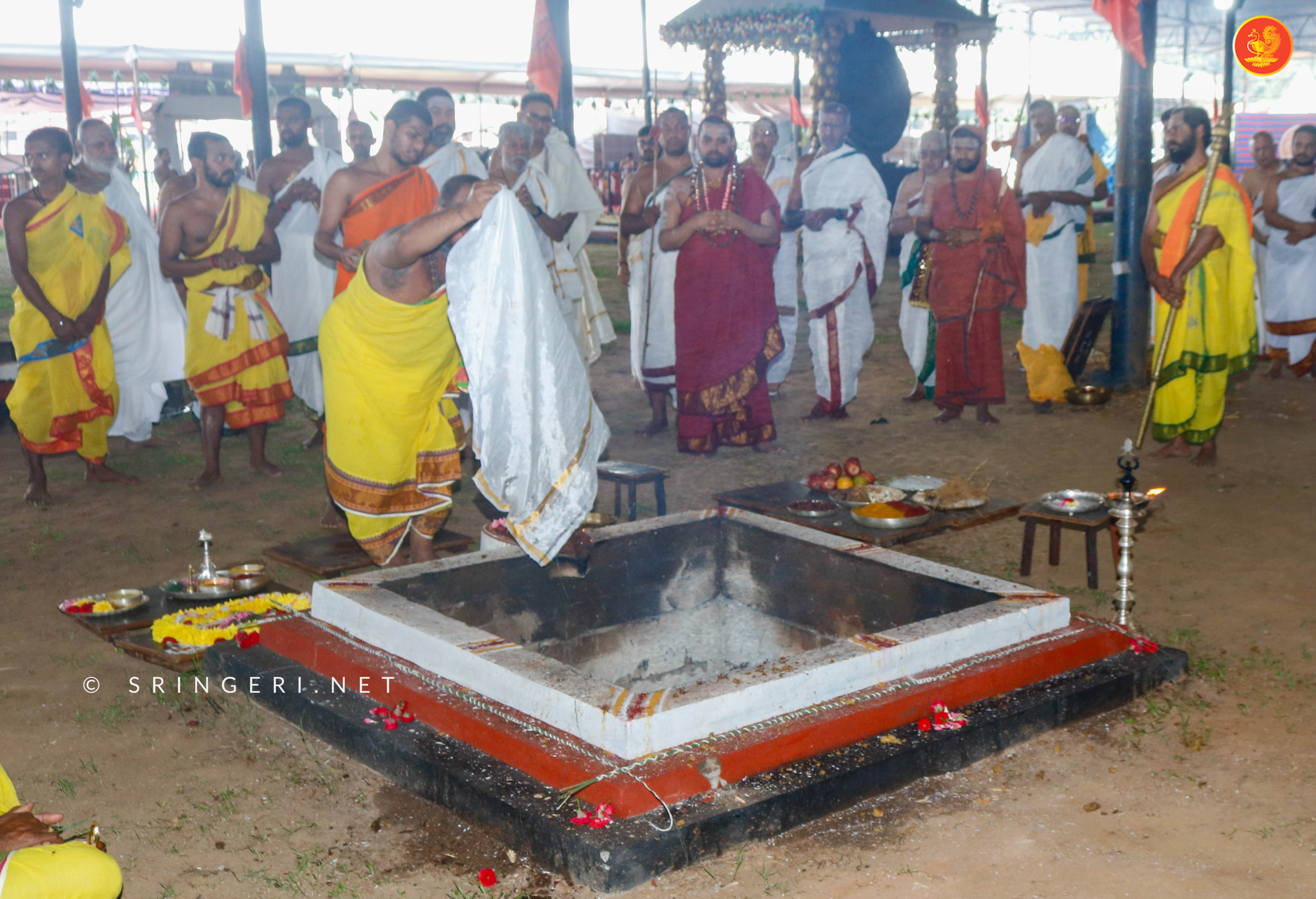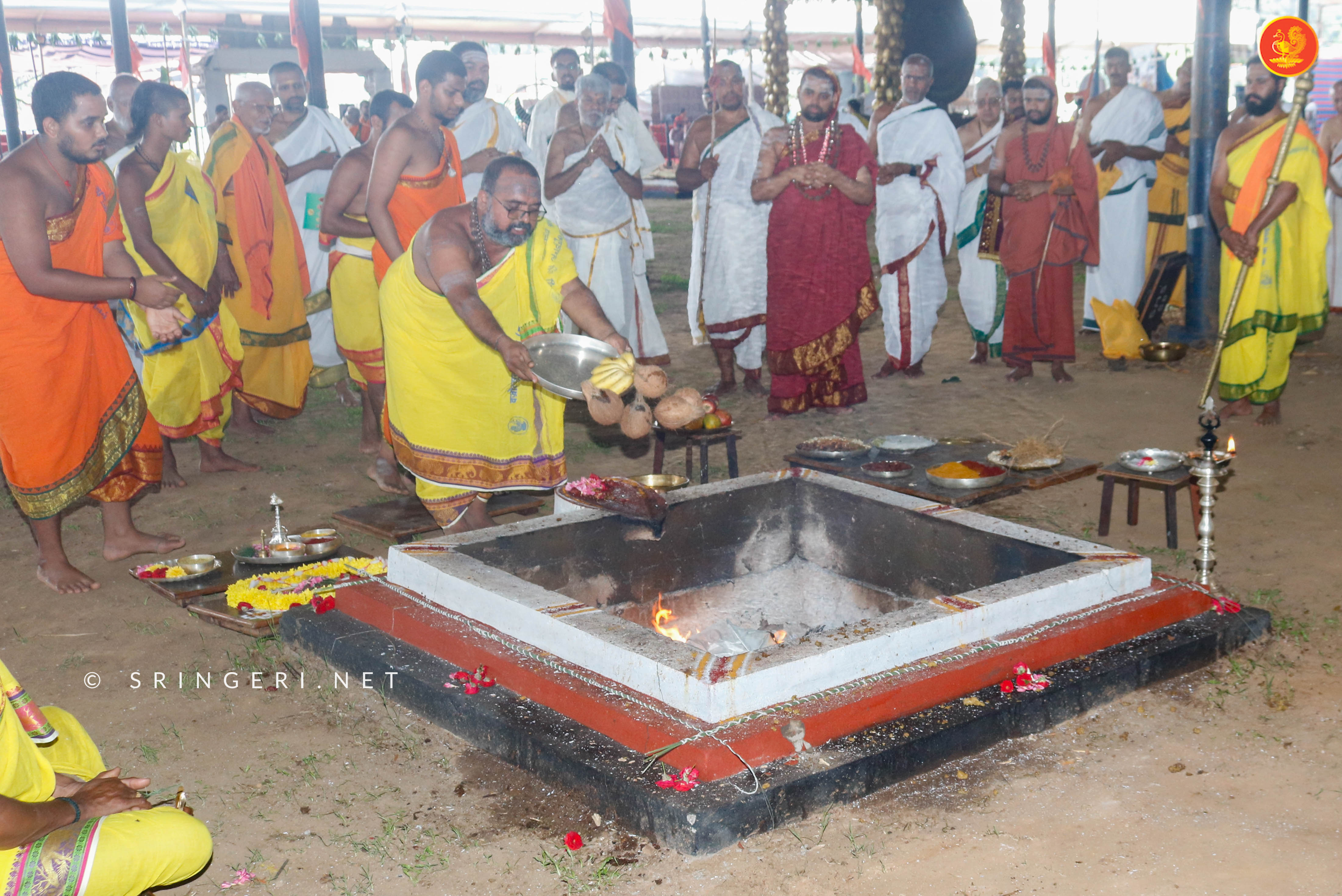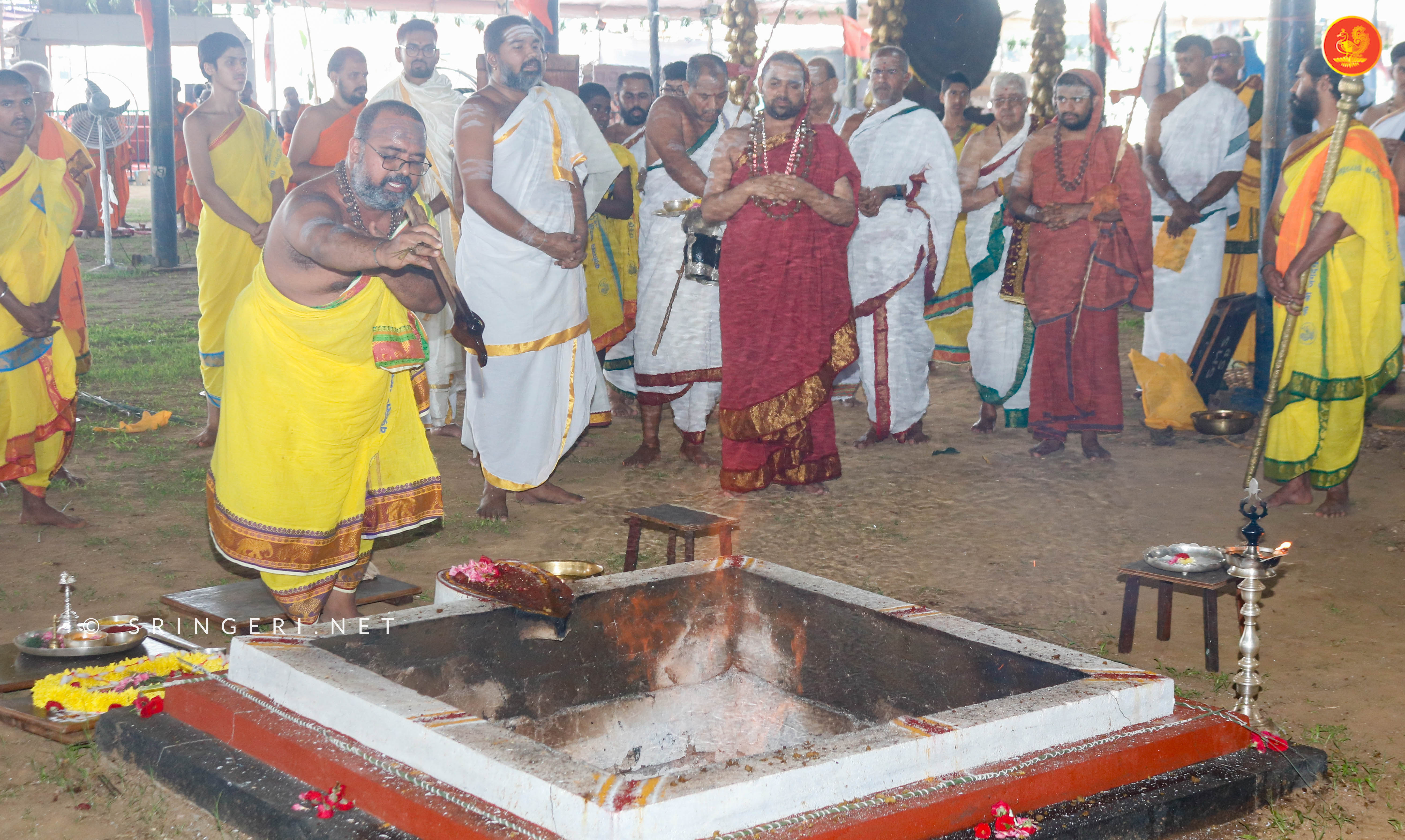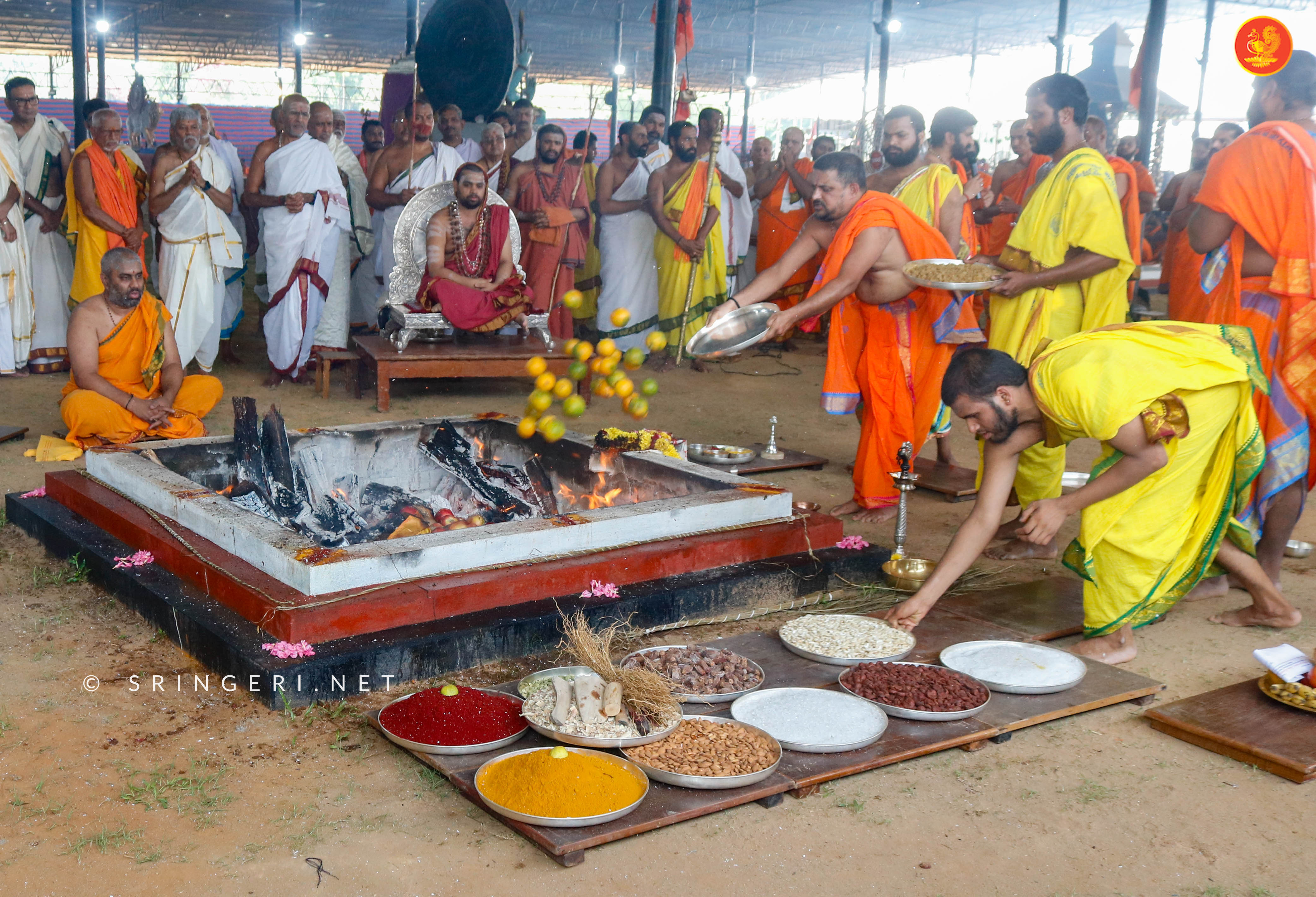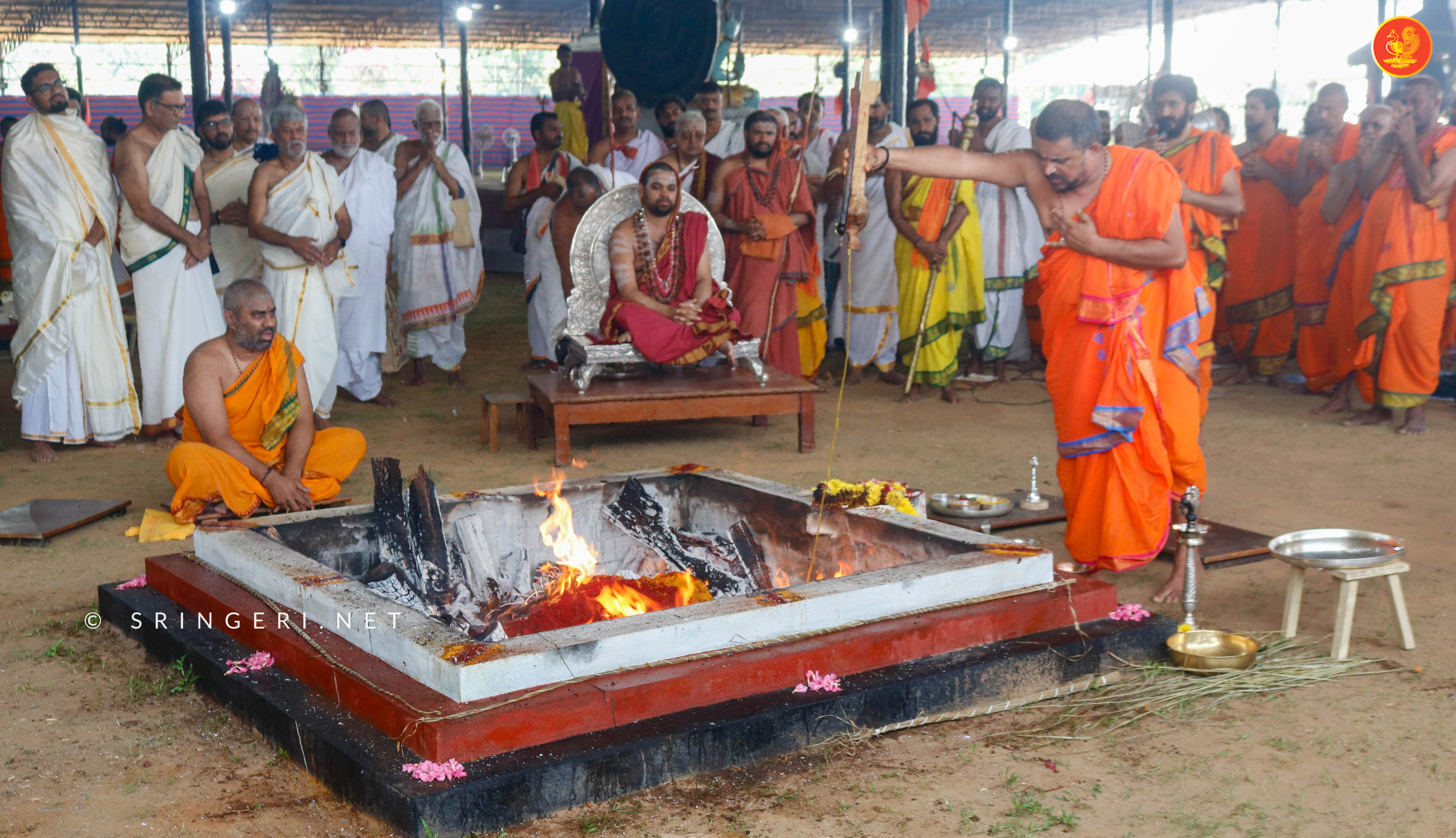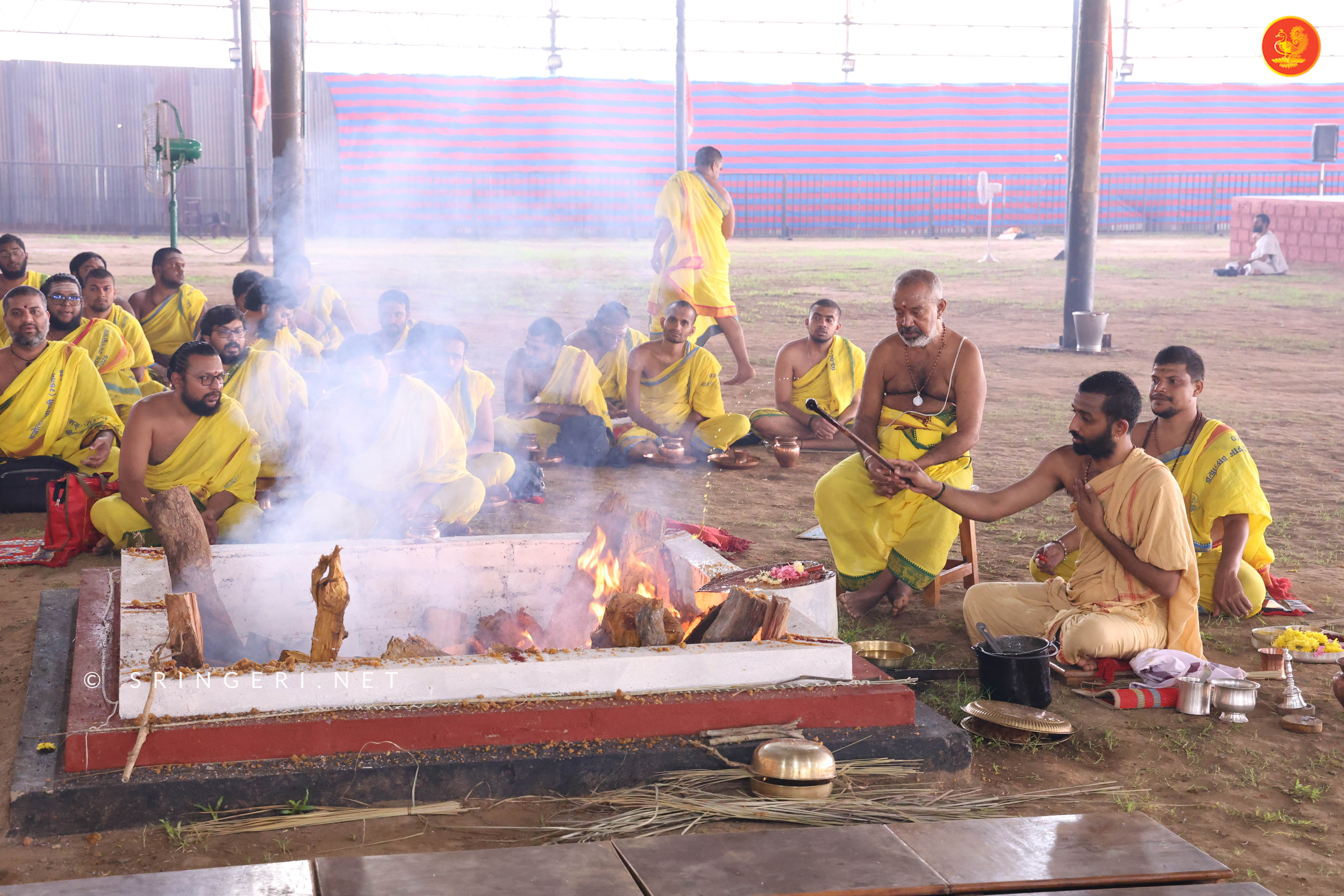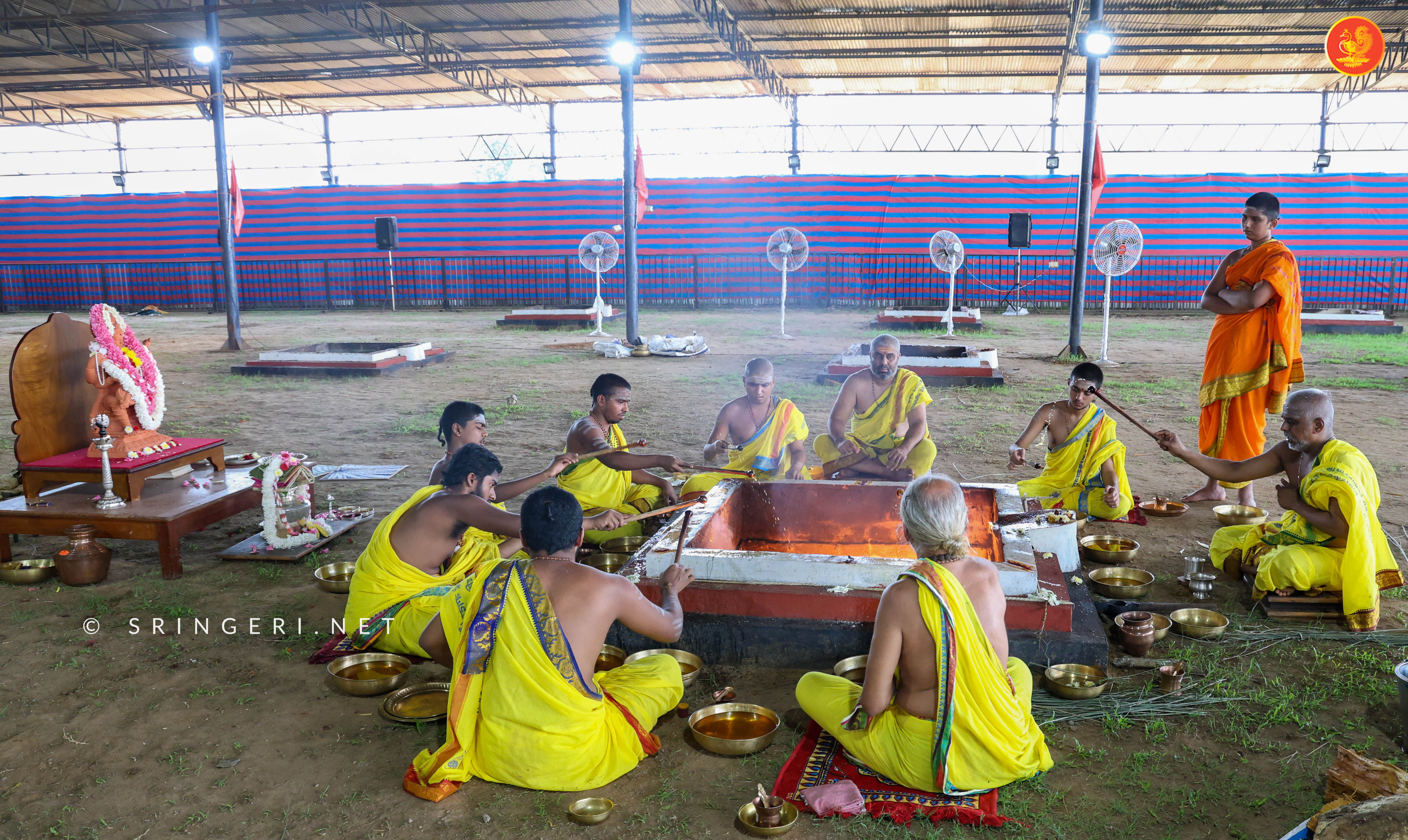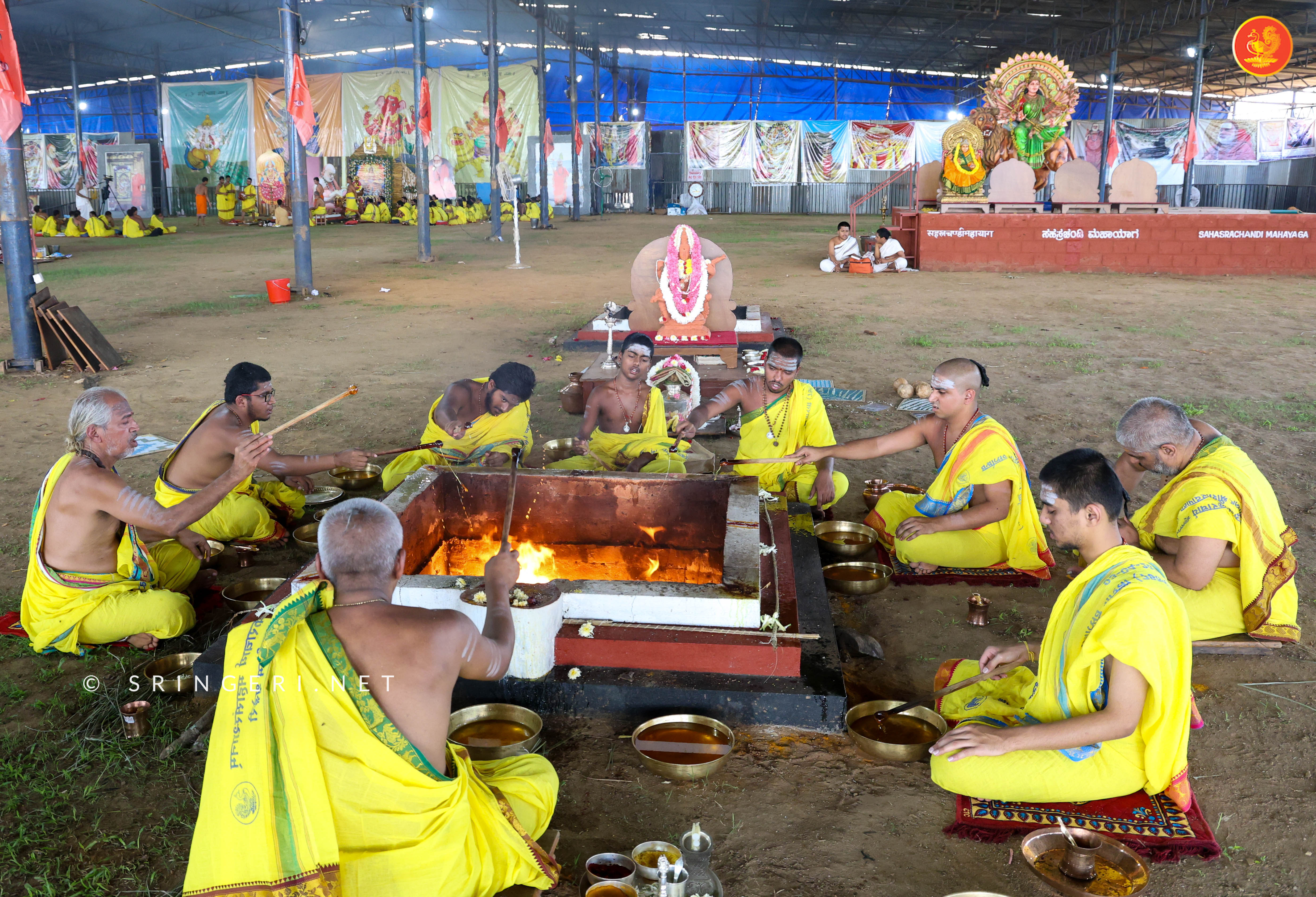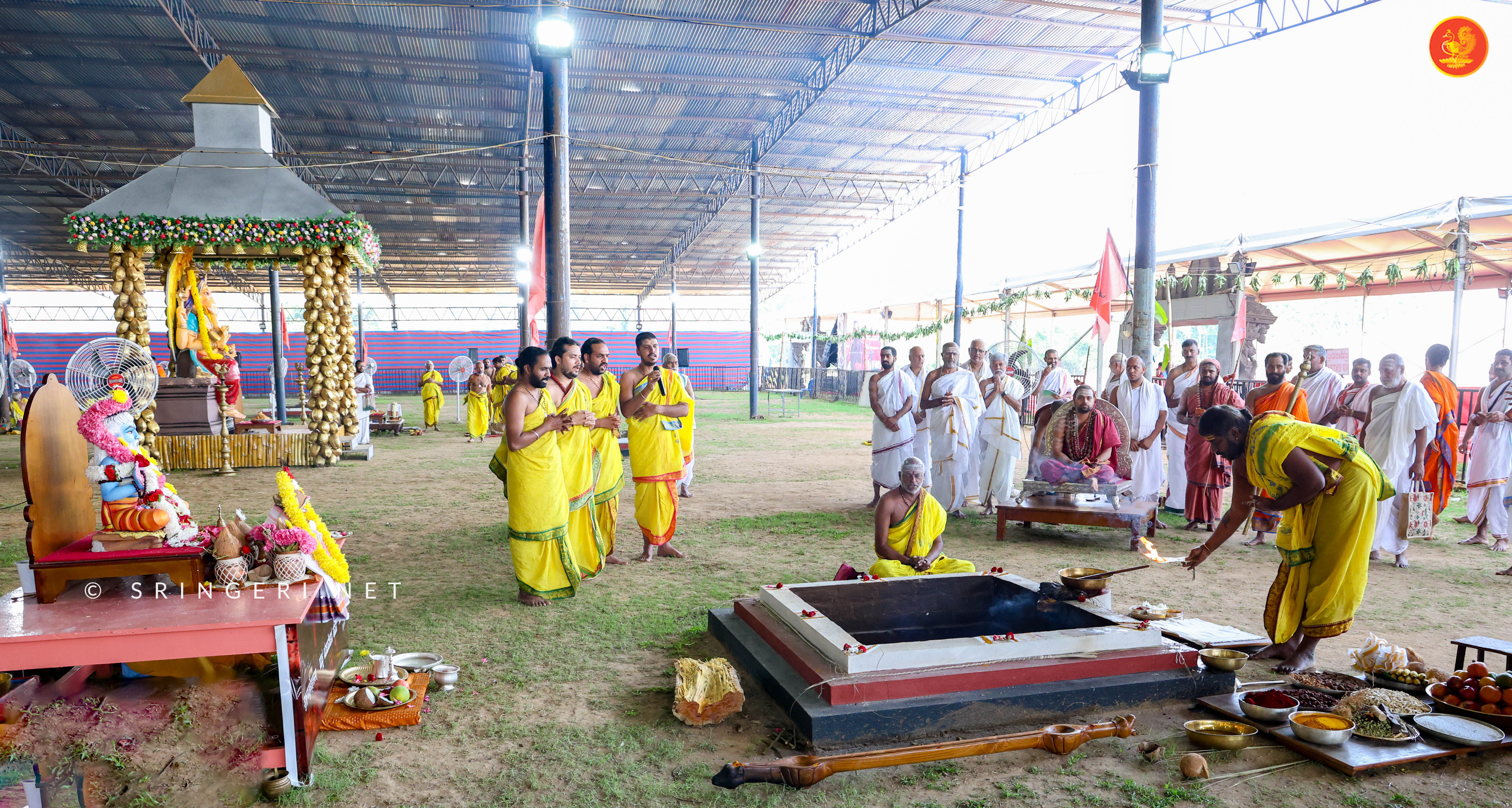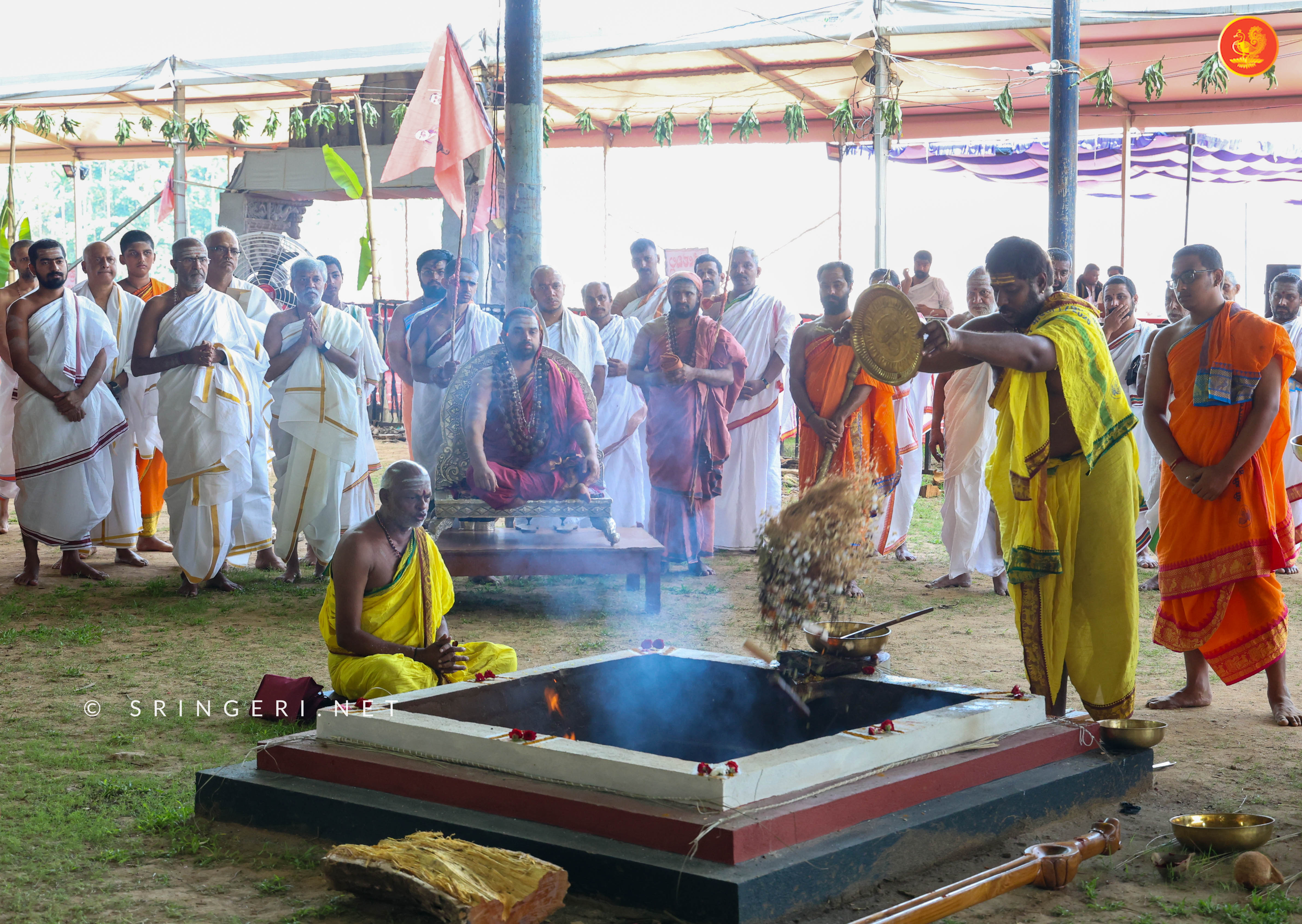The 75th Vardhanti Mahotsava of Dakshinamnaya Sringeri Sri Sharada Peethadheeshwara Jagadguru Shankaracharya Sri Sri Bharati Tirtha Mahasannidhanam was reverentially observed at Sringeri from March 30 to April 11. Several dharmic, social and cultural activities were conducted as a part of the Vardhanti festivities with the entire event happening under the title ‘Vajrotsava Bharati’, specially given by Jagadguru Shankaracharya Sri Sri Vidhushekhara Bharati Sannidhanam. Key dharmic observances included the Panchayatana Devata Aradhana, Veda Havanas, Sri Sundarakanda Parayana, Akshara Laksha Gayatri Japa and the Koti Rama Taraka Mantra Japa.
Panchayatana Devata Aradhana
On the morning of March 30, the Panchayatana Devata Aradhana, wherein worship of the five principal deities as established in the Panchayatana system of worship instituted by Jagadguru Sri Adi Shankaracharya, commenced. A sizable yaga-shala was specially set up in Bharati Tirtha Nagara, behind Guru Nivasa, for this purpose. Large pedestals with imposing murtis of each divinity (namely, Mahaganapati, Shiva, Devi, Mahavishnu and Surya) were erected in separate sections earmarked within the yaga-shala for each Aradhana.
As a part of the Panchayatana Devata Aradhana, yagas for loka-kalyana (welfare of the world) were conducted namely, the Atirudra Maha Yaga, Sahasra Chandi Maha Yaga and Laksha Modaka Mahaganapati Homa. In addition, many Devata mantras and other anushtanas (ritualistic observances) for each Devata were also performed by a large assembly of ritwiks.
As part of Mahaganapati Aradhana, Jagadguru Sri Sannidhanam graced the yaga-shala in the early hours of March 30 and performed the sankalpa for the commencement of the Laksha Modaka Ganapati Homa to be conducted as Ayuta Modaka Ahuti everyday over a span of 10 days. Sri Ganapati Bhat officiated the Laksha Modaka Ganapati Homa. In addition, the Atharvashirsha Parayana also commenced. The Purnahuti of the Laksha Modaka Ganapati Homa was conducted on April 8 in the divine presence of Jagadguru Sri Sannidhanam.
As part of Shiva Aradhana, on the morning of March 31, Jagadguru Sri Sannidhanam undertook sankalpa for the Atirudra Mahayaga. The Mahayagawas officiated by Sri Yashwant Ghanapati and involved 121 Ritwiks chanting the Sri Rudra Prashna 14,641 times over the next 11 days. Purnahuti of the Atirudra Mahayaga was conducted on April 11 in the divine presence of Jagadguru Sri Sannidhanam.
As part of Ambika Aradhana, Sri Sannidhanam also undertook sankalpa for the commencement of the Devi Aradhana which included the Ayuta SriSukta Japa, Saraswati Mantra Anushthana, Devi Mahamantra Japa and Akshara Laksha Sri Vidya Japa Anushthana. The Srichakra Navavarana Archana and Sri Vidya Japa was performed by Vedabrahma Sri Narahari Bhat. The Sahasrachandi Mahayaga involving more than a hundred Ritwiks and officiated by Vidwan Krishnaraja Bhat took place from March 31 with the Sankalpa being taken by Sri Sannidhanam and the Poornahuti taking place in the divine presence of Sri Sannidhanam on April 4. On the morning of April 2, Jagadguru Sri Sannidhanam undertook sankalpa for the commencement of the Ashottara Shata (108 times) Parayana of the Lalitopakhyana. The Parayana was held in the Pravachana Mandiram adjacent to the Sri Sharadamba temple. In the evening of April 7, Jagadguru Sri Mahasannidhanam graced the Lalitopakhyana parayana at the Pravachana Mandira. The Parayana concluded on April 11 with the purnahuti of the Lalita Homa performed in the divine presence of Jagadguru Sri Sannidhanam.
As part of Vishnu Aradhana, Pancha Sahasra Parayana of Sri Lakshmi Narayana Hridaya took place from April 4 to April 8 with Vedabrahmasri Niranjan Bapat officiating it. Moola Mantra Japa and Homa of Sri Narasimha, Sri Rama, Sri Krishna, Sri Hayagriva, etc. were also performed. The Poornahuti of Sri Lakshmi Narayana Hridaya Homa took place in the divine presence of Sri Sannidhanam on April 9.
As part of Surya Aradhana, Sri Sannidhanam undertook sankalpa on March 30 for the commencement of the Surya Aradhana in front of the murti of Bhagavan Suryanarayana in his chariot surrounded by the 12 Adityas represented by 12 kalashas. Observances for Surya Aradhana included the Dvadasha Shata Parayana of Aruna Prashna (1200 times), Surya Namaskara Anushthana and Dvadasha Sahasra (12000 times) Parayana of the Adtiya Hridaya and Surya Kavacha. The events were officiated by Sri Ramachandra Sharma (Yajur Veda Adhyapaka of Sri Sadvidya Sanjeevini Samskrita Mahapathashala).
Sri Subrahmanya Aradhana was also performed with Ritwiks from Tiruchendur led by Sri Pashu Shankar of Tiruchendur.
On various days, Jagadguru Sri Sri Mahasannidhanam graced the yaga-shala as well as the places where Parayanas and Japa were happening, and blessed all ritviks.
On March 31, (Chaitra Shukla Dviteeya), commemorating the 113rd Aradhana of Jagadguru Sri Sri Sacchidananda Shivabhinava Narasimha Bharati Mahaswamiji, a special Aradhana Puja was performed by Jagadguru Sri Sri Bharati Tirtha Mahasannidhanam. The Jagadguru also decorated the marble Murti of His Parameshthi Guru with a ‘Suvarna Mala,’ an offering by devotees of a garland of 108 gold coins bearing the sacred Ashtottara Shata Namavali of the 33rd Acharya. The offering was made by devotees as a part of Vajrotsava Bharati observances. At night, Sri Mahasannidhanam offered a special worship with Rudra Kramarchana at the Adhishtanam of His Parameshthi Guru. Sri Sannidhanam also had Darshan and was present till the Mahamangalarati. Ashtavadhana Seva took place, following which Stotras composed by Sri Mahasannidhanam on the great Acharya were chanted.
From March 31 to April 10, the 75 Lakh Panchakshari Mahamantra Japa was performed at Guru Nivasa. The Shiva Panchakshari and Shakti Panchakshari Japa was performed by hundreds of devotees who have been blessed with the Panchakshari Mantra Diksha by the Sringeri Jagadgurus. The total Japa count was nearly double the planned count.
All the above dharmic events were coordinated by the Tantri of the Math, Sri Sitarama Sharma and Vidwan Sri TV Shivakumara Sharma.
Veda Havanas
In addition to the Panchayatana Aradhana, Havanas for the Rig, Krishna Yajur, Shukla Yajur and Sama Vedas were conducted in the yagashala. Parayana of the entire Atharva Veda was also performed.
Jagadguru Sri Sannidhanam graced the yaga-shala and undertook sankalpas on the morning of April 2 for the commencement of the Rig Veda Samhita Havana and the Sama Veda Samhita Havana. The two Havanas were officiated by Sri Ramesha Bhat (Rig Veda Adhyapaka of Sri Sadvidya Sanjeevini Samskrita Mahapathashala) and Sri Chandramouli Shrouti of Chennai. On April 4, Sri Sannidhanam undertook Sankalpa for the Krishna Yajur Veda Havana officiated by Sri Kambhampati Shivaramakrishna Ghanapati of Vijayawada while on April 6, Sri Sannidhanam took the Sankalpa for the Shukla Yajur Veda Samhita Havana officiated by Sri Dhananjaya Ghanapathi of Chennai. Purnahutis for the Veda Havanas were conducted in the divine presence of Jagadguru Sri Sannidhanam - Rig Veda Samhita (on April 9), Krishna Yajur Veda (April 10), Shukla Yajur Veda (April 10), Sama Veda Samhita (April 9). The Parayana of the entire Atharva Veda that began on April 6 concluded on April 10.
Special Japas and Pujas
Koti Rama Taraka Mantra Japa:
On the morning of March 30, Sri Sannidhanam proceeded to the northern bank of River Tunga, outside the shrine of Sri Janardhana Swami, and commenced the Koti Rama Taraka Mantra Japa (chanting 1 crore times). A large group of devotees had assembled at the shrine to participate in the Japa. Sri Sannidhanam initiated the assembled devotees into the sacred Rama Taraka Mantra, following which the devotees continued chanting the mantra. Soon after the chanting commenced, Jagadguru Sri Sri Bharati Tirtha Mahasannidhanam also graced the venue and blessed the gathering.
Akshara Laksha Gayatri Japa: The Akshara Laksha Gayatri Japa commenced at the Chandrashekhara Bharati Sabha Bhavana opposite the Sri Sharadamba temple on the morning of March 30. Several eager devotees, young and old alike, from neighbouring regions gathered in large numbers everyday to participate in this Japa.
Sundarakanda Parayana also was conducted while special Suvasini Pujas and Kanya Pujas were conducted every day.
On April 2, a day prior to the Vardhanti day, Jagadguru Sri Mahasannidhanam arrived at the Sri Malahanikareshwara
Swamy temple in Ishwara Giri. Sri Mahasannidhanam first offered worship to Bhagavan Sri Stambha Ganapati and then performed a special Puja to Bhagavan Sri Malahanikareshwara. Later, Sri Mahasannidhanam performed Puja to Devi Bhavani. Sri Sannidhanam arrived at the temple for the Mangalarati.
Cultural music programs featuring eminent musicians were conducted in the evenings at the Sri Chandrashekhara Bharati Sabha Bhavana from March 30 to April 4. Artists who performed included Vidwan Sri Ramanath Venkata Bhagavath (March 30), Vidwan Sri MR Shriharsha (March 31), Vidwan Rajesh Vaidya (April 1), Vidushi Smt. Sivasri Skandaprasad (April 2). On April 4, a Yakshagana performance was staged by the Ananta Padmanabha Dashavatara Yakshagana Mandali, Perduru.
75th Vardhanti Day
On April 3 (Chaitra Shukla Shashthi), the Vardhanti Day, Sri Mahasannidhanam blessed thousands of devotees with Ahnika Darshanam from 7 am to almost 9:30 am. A large number of devotees performed Bhiksha Vandanam and Vastra Samarpanam, had Darshan of Jagadguru Sri Sri Vidhushekhara Bharati Sannidhanam in the main hall of Sri Sacchidananda Vilas and were blessed with Bhikshavandana Prasada. Sri Purushottama Bharati Swamiji of Sringeri Shivaganga Math, and Sri Gopalananda Tirtha Swamiji at Sri Krishnananda Math, Durvasapura near Thirthahalli also paid respects.
Thereafter, Sri Mahasannidhanam proceeded to the Sri Sharadamba temple on the northern banks of the Tunga and performed a special Puja to the exquisitely adorned Goddess. Sri Sannidhanam had Darshan at all the temples in the Math premises, where special Mangalarati was performed.
In the evening, a Guru Vandana Sabha was held by devotees at Guru Nivas, as a reverential offering of their devotion and respect to the Guru. The Sabha commenced with a Veda invocation, followed by a Prarthana and a rendition of Jagadguru Sri Adi Shankara Bhagavatpada’s stotras. Sringeri Math CEO Guru Seva Nirata Sri PA Murali and the Panditas of the Sadvidya Sanjeevini Samskrita Maha Pathashala offered Phala Samarpanam on behalf of all devotees.
Special Prasadas from several Kshetrams
A special feature of the 75th Vardhanti event was the offering of special Prasada from several sacred Kshetrams across Bharatavarsha to the Sringeri Jagadguru.
Sri Mahasannidhanam was offered the Prasada of special Pujas at the 12 Jyotirlinga Kshetrams, namely, the temples of Sri Ramanathaswamy at Rameswaram (the Kshetram of Sringeri Math), Sri Kashi Vishwanath, Sri Srisailam Mallikarjunaswami, Sri Ujjain Mahakaleshwar, Sri Nasik Tryambakeshwar, Sri Omkareshwar, Sri Parli Vaidyanath, Sri Bhimashankar, Sri Somnath, Kedarnath, Sri Oundha Nagnath and Sri Grishneshwar. Archakas and representatives of the Jyotirlinga Kshetrams who travelled to Sringeri offered the Prasada to Sri Mahasannidhanam and Sri Sannidhanam, and then received the blessings of the Jagadgurus.
Prasada was also offered by Archakas of prominent temples in South India including the temples of Tirupati, Srikalahasti, Narasaraopet Bhimalingeshwara Swami temple, Kotappakonda Sri Trikooteshwara Swami from Andhra Pradesh, temples of Bhadrachalam, Vemulawada, Yadagirigutta, Dharmapuri from Telangana, the Shanmukha Kshetras (of Tiruchendur, Palani, Tirupparankundram, Swamimalai, Pazhamudir Cholai and Tiruttani in Tamil Nadu), other prominent temples of Tamil Nadu including Sri Madurai Meenakshi, Sri Nellaiappar temple in Tirunelveli, Sankarankoil, Srivilliputtur, Azhagarkoil, Koodal-azhagar, Kanyakumari, Nagercoil, Thirunallar, Thirumogoor Kalamega Perumal, various temples in Chennai such as Marundeeshwarar, Vaithiswaran, Parathasarathi, Vadapalani, temples in Kanchipuram such as Sri Kamakshi, Sri Ekambareshwara, Sri Varadaraja Swami and Kumarakottam, temples in the Trichi region such as Srirangam, Akhilandeshwari, Ucchi Pillaiyar, Samayapuram, Vayalur Murugan and temples in the Thanjavur-Kumbhakonam region such as Thiruvarur Thyagaraja Swami, Mayavaram Mayuranatha Swami, Kumbhakonam Adi Kumbheshwarar and Chidambaram. Prasada was also offered from Shabarimalai Ayyappa and Malliyoor Ganapati from Kerala. Sri Mahasannidhanam received Prasada from all these temples and blessed the representatives.
Sri Mahasannidhanam also blessed the representatives offering Prasada from many dozens of important temples in Karnataka including the temples of Hampi (Sri Virupaksha), Nanjanagoodu, Kigga, Kollur, Kukke (Sri Subrahmanya), Horanadu, Belavadi, Dharmasthala, Murudeshwara, Udupi, Belur, Gokarna, Ganagapura, Kamalashile, Mandarti, Anegudde, Nagachala (Sri Ayyappa), Kumbhashi, Saligrama (Sri Guru Narasimha), Ulluru (Sri Kartikeya), Hattiyangadi (Sri Siddhi Vinayaka), Soukuru (Sri Durga Parameshwari), Shankaranarayana (Sri Kroda Shankaranarayana), Neelavara (Sri Mahishamardini), Haladi, Vandaru (Sri Adi Subrahmanya), Guddattu (Sri Vinayaka), Kalasa, Teerthahalli (Sri Rameshwara), Kandya Markandeshwara, Balapa (Sri Trishulini Durgaparameshwari) and Ashwathapura.
Prasada was also offered by representatives of Hampi Virupaksha Math, Talakad Balakrishnanand Math, Sri Shiva Sujnana Tirtha Swamiji of Vishwakarma Math, and Sindagi.
The Prasada from all these temples and institutions were also offered to Sri Sannidhanam. Most of these Prasada offerings took place as part of the Guru Vandana Sabha in the evening and a few were offered to the Jagadgurus in the forenoon.
Guru Vandana
Speaking during the Guru Vandana Sabha, the Administrator and CEO of Sringeri Math, Guru Seva Nirata Sri PA Murali spoke about the significance of Guru Bhakti. He mentioned that over the last 16 months, Jagadguru Sri Sannidhanam, who is Himself the highest ideal of Guru Bhakti for all of us, has been compassionately directing and guiding the conduct of the Suvarna Bharati Mahotsava commemorating 50 years of Sannyasa Sweekara of Jagadguru Sri Mahasannidhanam. The CEO cited the following highlights of the Suvarna Bharati Mahotsava:
- Commencement of the annual Shrauta Maha Sammelan
- 50th year celebrations of Veda Poshaka Sabha and honouring of more than nearly 450 Vedic scholars at Sringeri
- Special Veda Sammelans across the country
- Special Veda Parayanas in various Pathashalas
- After a gap of 700 years, commencement of the Chaturveda Parayana, Shastra Sadas and Kavita Goshthi in Jammu and Kashmir
- Commencement of the monthly Vidwat Sabhas at Tirupati and Varanasi on the sacred Mrigrasheersha Nakshatra day of Sri Mahasannidhanam
- Commencement of the monthly Vidwat Sabha on the sacred Uttaraa Nakshatra day of Sri Sannidhanam at Vijayawada
- Shatavadhanam at Sringeri
- Ashottara Shata Parayana of Srimad Bhagavata at Sringeri
- Jnaneshwari Saptaha and Akhanda Sankeerthana Mela
- Jagadguru Namanam lecture series on Sri Mahasannidhanam
- Harihara Namamrita Yajna
- Shaankara Stotra Samarpana by 3500 children at Sringeri
- Several dharmic events both at Sringeri and in various branches of our Math. To quote a few, the 50-day ‘Bharata Vibhuti’ pravachana series in Bengaluru, daily dharmic discourses at Vijayawada, and Yati Bhiksha at Varanasi.
- Quiz programs on our dharma that have touched 40,000 students.
- The spectacular Stotra Triveni Mahasamarpana event where nearly 50,000 devotees gathered together at Sringeri as a tribute to Sri Mahasannidhanam to chant stotras composed by Bhagavatpada; the CEO also recalled that Sri Mahasannidhanam graced the event and blessed all with an Anugraha Bhashanam.
Vajrotsava Bharati Movement
Sri Murali also stated the following, “The followers of Sanatana dharma have been blessed with Jagadguru Sri Mahasannidhanam’s period of reign – a golden era in the history of Dakshinamnaya Sri Sharada Peetham. The reign is golden not merely because of the various golden dedications in kind at the temples in Sringeri, but more so due to the extraordinary dharma-prachara that we are witnessing. Sri Mahasannidhanam has inspired innumerable devotees to adhere to the dharmic path through His Upadesha and has led us in this path by Himself being the supreme example.
The Jagadgurus have now compassionately directed that we must continue the dharmic and social initiatives commenced during the Suvarna Bharati Mahotsava with renewed vigour from this most sacred occasion of Vajrotsava Bharati – the 75th Vardhanti of Jagadguru Sri Mahasannidhanam.
Accordingly, dharmic activities conducted across our country and abroad such as the Shrauta Maha Sammelan, special Veda and Shastra Sabhas, Purana & Itihasa Parayana, Vedanta camps, Annadana in various Tirtha Kshetras, Baala Bharati program for children, as well as social activities such as free medical camps, health drives and special educational scholarships will become a permanent fixture.
All these will take place under the flagship of Vajrotsava Bharati, a new movement that will feature additional dharmic ventures undertaken as an ongoing mission in line with the principal objective of the Peetham – the sustenance and propagation of Sanatana dharma.
The CEO then spoke about the Shrauta Maha Sammelan which Sri Sannidhanam first conducted in March 2024. Its second edition took place in January 2025. Sri Murali stated that there are only a little over hundred Agnihotris in the entire nation. These Agnihotris are the upholders of our sacred Vedic tradition and lead a life of great discipline. The CEO stated on the auspicious Vardhanti day, as the first activity being commenced under the Vajrotsava Bharati movement and as per the directive of Jagadguru Sri Mahasannidhanam and Jagadguru Sri Sannidhanam, he was pleased to announce a life-long annual support for every Nitya Agnihotri who has begun attending the Maha Sammelan at Sringeri.
Thanking the natives of Sringeri for their Gurubhakti and support in every dharmic and social activity at Sringeri undertaken by the Math, Sri Murali outlined plans for the ‘Sundara Sringeri’ initiative. He mentioned that as per the directive of the Jagadgurus, efforts will be undertaken to maintain the cleanliness of river Tungabhadra and Sringeri as a whole by working with the civic authorities, to make Sringeri plastic-free to the extent possible, to spruce up the facilities at Sri Abhinava Vidyatirtha Multispeciality hospital, and to establish a good CBSE school in Sringeri.
The CEO also spoke about Vedanta Shravana scheme blessed by the Sringeri Jagadgurus, wherein many thousands of interested seekers are getting introducted to Vedanta as elucidated in the Bhagavad Gita, Prakarana granthas, Puranas, etc. The meaning of Stotras such as Lalita & Vishnu Sahasranama are also discussed. The Bhagavad Gita discussions launched a few months ago on Gita Jayanti are being attended by 10,000 participants from all over the world. More than 50 workshops benefiting 5000 seekers have been conducted across India in 8 different languages. The CEO stated that is indeed a matter of joy that participants keep coming back for more and more programs. Last year, the Vedanta workshops were conducted for the first time in USA, Singapore and Australia. The CEO also thanked the nearly 100 Vidwans and resource persons from all over the country for help in conducting these programs and noted joyously that more and more followers of our dharma and more importantly, many youngsters, seek exposure to aspects of our dharma and particularly, the path shown by Jagadguru Sri Adi Shankaracharya. The CEO mentioned that as a part of the Vajrotsava Bharati movement, the Vedanta Shravana scheme would start intensive training programs for potential upanyasakas in various languages, facilitate regular events in about 50 towns and cities across India, and also reach out to interested seekers in countries such as Canada, the UK, the UAE, and New Zealand. 10 Samskara-sudha camps for children have taken place. Under the Baala Bharati scheme, summer camps and more courses will be rolled out soon for children of different age groups.
The CEO also mentioned that many social outreach programs including numerous free medical camps, eye camps, health camps, blood tests and blood donation drives, free dialysis drives, free surgeries, and cancer awareness campaigns have been conducted by the hospitals run under the auspices of the Sringeri Math and by branches of the Sringeri Math. For economically-disadvantaged students, different measures have been adopted. Simple assistance such as providing school bags, notebooks, uniforms, groceries, steel plates for lunch, and payment of school fees have also been offered. Scholarships, educational laptops and free NEET coaching for underprivileged students entering the competitive circuit have also been offered. Branches of the Sringeri Math have conducted free Vivaha and Upanayana and almost every branch has engaged in Annadana. Further, contributions towards flood relief, sapling distribution and tree plantation drives have also been made. The CEO stated that more than 10 lakh needy people have been benefitted as a part of the Suvarna Bharati Mahotsava initiatives, with more than INR 10 crores being spent in these efforts.
The CEO recalled that Sri Mahasannidhanam inaugurated the Sringeri website (www.sringeri.net) on the Vyasa Puja day of 2004 and dedicated the Advaita Sharada project on the Shankara Jayanti day of 2014 to cater to the needs of scholars and students of Vedanta all over the world. The CEO mentioned that on this auspicious occasion of Vardhanti, with the blessings of the Jagadgurus, a new version of the website (www.sringeri.net) has been rolled out with an increasing social media presence to cater to the needs of far-away devotees.
The CEO concluded his speech by offering his reverential namaskaras to the Jagadgurus on behalf of all devotees.
Next, Shatavadhani Sri Dorbala Prabhakara Shastri gave a reverential rendition of Sanskrit verses composed by him in praise of Jagadguru Sri Mahasannidhanam.
Releases:
Sri Sannidhanam released the following publications during the occasion.
- Vajra Prabha - A pictorial presentation of 75 sacred events from the divine life of Sri Mahasannidhanam
- Bhagavad Tattva Mimamsa - English translation of six Hindi articles (earlier published in the Kalyan magazine of Gita Press), on the nature of Bhagavan, penned by Sri Mahasannidhanam
- Moral Stories for Mind Purification - Enlightening stories from the Anugraha Bhashanas - Compiled by Sri Suresh Chandar and published by the Centre for Brahmavidya
- Jagadguru Sri Chandrashekhara Bharati Swamigalavara Ashtottara Shatanamavali - a compilation with meaning and notes by Dr NS Suresh, Director, Sura Saraswati Sabha and published by Sri HK Venkatesh
- “Shata-Vasanta-Smarika” - Special Commemoration volume of the Centenary of Guntur Mandala Veda Pravardhaka Vidwat Pareeksha Sabha
- Sri Guru Charitram - English translation and published by Smt Sheela Prabhu
- Mahatapasvi - Special Vardhanti edition of Hebbar Vipradhwani
- Darshanam Magazine Special Issue
- Voice of Jagadguru Website (https://voiceofjagadguru.com/voj) - Containing past editions of the e-magazine ‘Voice of Jagadguru’
Anugraha Bhashanam:
Blessing the audience with an Anugraha Bhashanan, Sri Sannidhanam said, “On the occasion of the sacred Vajrotsava Bharati 75th Vardhanti Mahotsava, many people have come from various parts of the world for the sole reason of obtaining even a momentary Darshan of our revered Guru and sanctifying their lives. Even if our Darshan is very brief, the rewards of the Darshan are immense. We beget immense punya, uplift ourselves and beget all shreyas (welfare) - there is no doubt in this regard. The Shastras extol the Darshan of Mahapurshas and describe its varied immense results. Our forefathers have also described its reward in the form of a small story. Once Maharshi Narada went to Bhagavan Vishnu and asked him about the rewards of a Mahapurusha’s Darshan. Bhagavan Vishnu directed Narada to go to a certain forest on Earth and pose the same question to a small worm upon the branch of a certain tree. Maharshi Narada was quite puzzled by the response but went nevertheless. He found the worm and posed the question to the worm. The worm stared at the Maharshi for a few seconds and then died. Anxious, Maharshi Narada went back to Bhagavan Vishnu and said, “When I posed the question, the worm died!”. Bhagavan Vishnu then directed Narada to another place where a calf was born. “Go to the calf and pose the same question”, said Bhagavan Vishnu. The Maharshi did as directed. The calf also stared at the Maharshi for a few seconds and died. Extremely concerned, Maharshi Narada went back to Bhagavan. Then Bhagavan said, “A certain king has just had a baby. You go ask the baby.” Maharshi Narada was more anxious, but went nevertheless at Bhagavan’s insistence. The king’s baby asked Narada, “O Swami! Have you come to uplift me again?” Maharshi Narada was surprised, “Do I know you? Have you seen me before? What do you mean by saying I have come again?”. The infant explained, “I had once committed a grave sin for which I was destined to be born as a worm four times. The fourth time I was born, I had the blessing of your Darshan for a few seconds. As a result, I was absolved of all the effects of that sin. I therefore got a more evolved birth - that of a calf. When I got your Darshan again as a calf, my karma for that birth was also annulled and I secured a more evolved birth - as the son of a king. Now that I have been blessed with your Darshan again, I will definitely be further uplifted, secure more evolved births, beget all welfare and finally reach a state where I would not have to be born again. There is no doubt about this.” This story tells us that even a brief Darshan of a Mahatma will give us immense rewards.
Like Bhagavan Sri Dakshinamurti, our revered Guru is also in mouna. There is no higher teaching than that which is disseminated in silence. Thus, our Guru imparts to us the highest teaching in silence like Sri Dakshinamurti.
Many of you have had the blessing of witnessing the Guru’s Shashtiabdhapurti, Divya Saptati, Suvarna Bharati and now the Vajrotsava Bharati celebrations. Many dharmic, saamskritika and saamajika initiatives have commenced with the Vajrotsavacelebrations and there is no doubt that it will bring forth immense welfare for all.”
Sri Sannidhanam also explained the Panchayata Devata Aradhana observed as a part of the Vardhanti celebrations where five divinities are placed on the same pedestal and worshipped. “The Panchayatana Devata Aradhana is a significant factor that unifies all followers of Sanatana Dharma. If it were not for the Panchayatana Devata Aradhana, there would have been many factions in our Dharma. The essence of the Supreme is captured through the Panchayatana Devata Aradhana and thus it serves as a means to unite all followers of our Dharma. It was thus resolved that this Panchayatana Devata Aradhana must be observed on this occasion in a more special and grander manner.”
Sri Sannidhanam spoke about the Veda Havanas that were performed as a part of the Vajrotsava celebrations and also mentioned that the silver Veda murtis offered by the Guntur Veda Pravardhaka Sabha (last year as a part of its centenary celebrations) were being worshipped now as a part of Veda Havanas. At other times, the Veda murits are worshipped along with Sri Chandramoulishawara.
Sri Sannidhanam further explained the Panchayatana system of worship. He said: “It was Jagadguru Sri Adi Shankaracharya who instituted this Panchayatana system of worship, emphasising that there is no difference in the various forms of the Supreme (such as Vishnu, Devi, etc) and that essence of all these forms is one and the same. Therefore, it is deeply rooted in us that we worship all divinities - such as Bhagavan Shiva during Shivaratri, Sri Rama during Rama Navami, Sri Krishna during Krishnashtami, etc. We only perceive that we offer worship to the same Paramatma who has taken on the form of Shiva, Vishnu, etc. Why does Paramatma take on so many different forms? It is based on the times and need of the hour. For example, to kill Hiranyakashipu, Bhagavan had to take on the form of Narasimha. To slay Ravana, Bhagavan had to incarnate in the form of a human as Sri Rama. Further, every devotee has different tastes and preferences.
The reason behind people’s preferences cannot always be questioned. It depends on each person’s nature and tastes. However, no matter which form of Paramatma a person worships, in keeping with his/ her tastes, it must be understood that there is no difference in the result. While we may worship a form of Paramatma that is suited to our tastes and preferences, it is a grave sin to criticise other forms of Paramatma. The Shastras themselves state that a person who harbours such discriminatory notions endures much suffering. That is why Sri Adi Shankaracharya has composed stotras on different devatas, for the reason that devotees may focus their minds on the form of Paramatma that they have the most inclination towards and engage in worship of that form. Thus, worshipping or praising one form of the divinity does not mean that the other forms are inferior. We must worship a form with the view that we are in essence worshipping that one Supreme Paramatma and not have any discriminatory notions.
Even within the scope of the Panchayatana Aradhana, we have Shiva Panchayatana, Vishnu Panchayatana, Devi Panchayatana, etc. This is again not to propose any discriminatory views. These differences have cropped up only because of individual preferences of devotees. The underlying view is that all forms of Bhagavan are the same, however there is greater inclination towards one form of Bhagavan. It is a preference that devotees have towards worshipping a certain form of Bhagavan. They therefore place that form at the centre and offer worship. However, just because there is greater preference towards one form, the other forms must not be dismissed or discarded. They too must be included in the Panchayatana system, however worship may be specially offered to the form that is most dear. This is the reason for more variations within the Panchayatana system such as Shiva Panchayatana, Vishnu Panchayatana, etc. One must not argue as to whether Shiva Panchayatana is greater or Vishnu Panchayatana is greater, and so on. That would defeat the whole purpose of the system. In this manner, Jagadguru Sri Adi Shankaracharya instituted the Panchayatana system of worship, fostered a sense of unity amongst all followers of our Dharma and proclaimed the presence of one Supreme Paramatma who manifests in different forms. Thus on this occasion we have resolved to perform the Panchayatana system of worship.
When Bhagavatpada incarnated, there was a group which denied the existence of Bhagavan. The Jagadguru refuted their claims and proved to them the existence of Bhagavan. In this manner, the challenge posed by the Nastikas was resolved. The next challenge was the discriminatory notions in the minds of Astikas (those who believe in religion and the supremacy of the Vedas) over the various forms of Bhagavan. They were fighting amongst themselves to establish the superiority of their preferred form of Bhagavan and assert the inferiority of other forms of Bhagavan. Bhagavatpada then gave fitting responses to these groups and by means of the right instructions, He forged a unity between the various groups. Thus, Bhagavatpada’s Panchayatana Puja system and His other varied instructions are the prime reason for the unity amongst followers of Sanatana Dharma.
In His Prashnottara Ratnamalika, Jagadguru Sri Adi Shankaracharya first asks:
कः अर्च्यः ? - Who is worthy of being worshipped?
भगवदवतारः - The Avatara of Bhagavan.
He then states that the Supreme who manifests in various forms is Bhagavan.
कश्च भगवान् ? - Who is Bhagavan?
शङ्करनारायणात्मा एकः - Shankaranaraya-atma-ekaH - i.e. that Bhagavan who is in the form of Shiva and Narayana.
The Panchayatana system of worship continues to be practised in many households and has come down through generations. Specifically, the Aradhana of Shiva and Vishnu are quite common. The modalities of worship of these divinities vary. For instance, Shiva is described as ‘abhisheka-priyaH’ and therefore it is common to chant the Rudra and perform Abhisheka to the Shiva Linga. Surya is described in the scriptures as “Namaskaara-priyo bhaanuH” and therefore the Surya Namaskara is performed for Bhagavan Surya. And so on. The modalities of each Aradhana may be different, but one must remain firm in the understanding that all these are being done for the same Paramatma.
Sri Sannidhanam also recalled that the Gita Jnana Yajna was instituted by Sri Mahasannidhanam about 2 decades ago and over the years, several people have memorised the entire Gita and participated in the Yajna. Sri Sannidhanam urged all followers of Sanatana dharma to commit to chanting at least one chapter from the Gita everyday. The Gita deals with all aspects that are central to our upliftment and whose core essence is the Advaita Tattva. However not everyone may have the capacity to understand the true import of the verses. The Shastras state that even chanting the Gita brings forth immense reward. The Padma Purana has outlined the rewards associated with the chant of each chapter of the Gita, in a portion titled the ‘Gita Mahatmya’. The Gita Mahatmya is described in the form of a conversation between Devi Parvati and Bhagavan Shiva where Parvati beseeches Shiva to describe the significance of the Gita. Bhagavan Shiva commences by quoting a conversation between Lakshmi and Bhagavan Vishnu.
Once when Bhagavan was in Yoga-Nidra on the Ksheera-sagara, Lakshmi Devi asked Him in surprise: “You seem to be asleep. Why so? You are the ruler of this creation and specifically, You, Bhagavan Vishnu, are the sustainer of this creation. When You have this responsibility to sustain and protect the universe, why are You in Nidra?”
Bhagavan Vishnu: I am not simply sleeping. It only appears so to the perceiver. I am not asleep.
Devi Lakshmi: Then what are You doing?
Bhagavan Vishnu: I am ever contemplating upon My true nature. The Tattva which I am ever engrossed in, and perceiving which, you mistook Me as having fallen asleep, is the Advaita Tattva which is the essence of all the Vedas. That is the state I am in (ever contemplating on that Tattva) - in the form of Sat-chit-ananda swarupa (existence, consciousness and bliss) and adviteeya (without a second or non-dual)”.
Devi Lakshmi: How is this possible? I thought that You are the Supreme Tattva, but is there a deeper, more lofty Tattva? I have been thinking that Your physical form that I perceive is the highest Tattva and that there is nothing beyond that. Is there a Tattva beyond this?
Bhagavan Vishnu said, “Yes, there is!
मायामयमिदं देवि वपुर्मे न तु तात्त्विकम् ।
सृष्टिस्थित्युपसंहारक्रियाजालोपबृंहितम् ||
The Saguna Swarupa which you perceive is मायामय - has been conjured by the illusory power of Maya.
न तु तात्विकम् - This is not the Paramaarthika (transcendental) form.”
When we say Vishnu or Shiva or Brahma, we conceive of a form in our minds. All these forms are not Paramarthika. So where from or how have these forms that are perceived appear?
“For the creation, sustenance and destruction of this universe, these perceived forms have been taken up. Beyond that, there is the pure Advaita Tattva which is unaffected by Maya. It is to explain this Advaita Tattva that we have the Bhagavad Gita”, says Bhagavan Vishnu to Lakshmi.
Bhagavan Shiva describes the above dialogue to Devi Parvati and then proceeds to explain the benefits of chanting each chapter of the Gita.
Maharshi Veda Vyasa has composed the Bhagavad Gita as it transpired between Bhagavan Sri Krishna and Arjuna, and Jagadguru Sri Adi Shankaracharya authored a commentary to the Gita which helps us understand its true import. By thoroughly referencing the entirety of the scriptural literature (the Vedas, Shastras, Puranas, Itihasas, etc), Jagadguru Sri Adi Shankaracharya has provided us with an accurate interpretation of the true import of the Gita.
Everybody must study the Gita daily and gain an understanding of the various margas propounded therein such as the Jnana Marga, Bhakti Marga and Karma Marga. Some people may question if Bhakti has any place in Advaita. Indeed, yes, Bhakti does have a significant place in Advaita. In fact, it is only through the lens of the Advaita Tattva that true bhakti (that which is inherent and not rooted in any motive) can be propounded. It is said in our scriptures that a person inherently has the most affection towards one’s own self. A person’s affection towards any second entity is rooted in the happiness derived through that entity. Thus, this affection towards a second entity is essentially a reflection of one’s inherent affection towards one’s own self. In fact this is even mentioned in the Upanishads:
आत्मनस्तु कामाय सर्वं प्रियं भवति
न वा अरे पत्युः कामाय पतिः प्रियो भवति आत्मनस्तु कामाय पतिः प्रियो भवति
Every person has inherent affection towards one’s own self and as a consequence gravitates towards happiness. Thus, any entity that holds the promise of this happiness also becomes dear to the person. The essence of all affection is a person’s affection for his own self - this is inherent, natural, and is not rooted in any reason. This affection is ahetuka (without reason), svaccha (pure) and nirupaadhika (unconditional and having no limitation). This is the source. Any affection for any external entity is only a reflection of this. This supreme affection is bhakti. And this supreme form of bhakti is expressed by those who have realised their own true nature. In the Gita, Bhagavan says:
चतुर्विधा भजन्ते मां जनाः सुकृतिनोऽर्जुन ।
आर्तो जिज्ञासुरर्थार्थी ज्ञानी च भरतर्षभ ॥
तेषां ज्ञानी नित्ययुक्त एकभक्तिर्विशिष्यते ।
प्रियो हि ज्ञानिनोऽत्यर्थमहं स च मम प्रियः ॥
उदाराः सर्व एवैते ज्ञानी त्वात्मैव मे मतम् ।
Bhagavan says that amongst His four kinds of devotees, the Jnanis (self-realised beings) are most dear to Him. Why? Bhagavan says that He considers the Jnanis as His very self and therefore is most affectionate towards Jnanis. The ajnanis (those in a state of ignorance) still perceive duality and differences, and therefore do not repose in their true nature which in essence is the same as Bhagavan’s. Thus the superior form of devotion is one which is rooted in affection towards one’s own self, which the Jnanis possess. This bhakti of its highest form certainly has a place of significance in Advaita. In fact, bhakti is accorded such a position of eminence solely due to the Advaitic implication.
All the aforementioned aspects and more are elaborated in the Gita. It is therefore essential that everyone makes it a practice to study at least one chapter of the Gita everyday and also make it a point to read the entire Gita once every few days. Studying the Gita will empower us with the strength to tide past all challenges of life.
By the grace of our revered Guru, Devi Sharadamba and Sri Chandramoulishwara, may everyone beget all welfare.
![]() The 75th Vardhanti day concluded with a special Chandramoulishwara Puja by Jagadguru Sri Sri Bharati Tirtha Mahasannidhanam.
The 75th Vardhanti day concluded with a special Chandramoulishwara Puja by Jagadguru Sri Sri Bharati Tirtha Mahasannidhanam.
The ocean of compassion, Jagadguru Sri Bharati Tirtha Mahasannidhanam gave special Ahnika Darshan on the morning of April 4 (the day after Vardhanti), at the main hall in Guru Nivasa, to the 600 Ritwiks participating in various dharmic rituals and observances for Vajrotsava Bharati. Jagadguru Sri Vidhushekhara Bharati Sannidhanam gave Bhiksha Vandana prasada to all the ritviks. This special Darshan was organised at the main hall in Guru Nivasa.
The grand 75th Vardhanti celebrations concluded with Sri Mahasannidhanam, along with Sri Sannidhanam, performing special Abhisheka and Puja to Sri Sharadamba on April 11th while Laksha Mallika Archana to Sri Sharadamba took place on April 12th.
Sri Rama Navami
On April 6, 2025, Sri Mahasannidhanam performed a special Rama Navami Puja. After the Mahamangalarati, Sri Mahasannidhanam recited the Rama Janana Sarga from the Bala Kaanda of Srimad Valmiki Ramayanam. Earlier in the day, Jagadguru Sri Sannidhanam performed a special Puja at Sri Kodanda Rama Swami temple with the Mahamangalarati being performed in the divine presence of Sri Mahasannidhanam.
The following day, the Valmiki Ramayana Parayana that had commenced on the Yugadi day (Chaitra Shukla Pratipat) was completed with the recitation of Sri Rama Pattabhisheka Sarga by Jagadguru Sri Ssannidhanam.
YouTube links to watch all the videos of Vajrotsava Bharati - 75th Vardhanti of Jagadguru Sri Sri Bharati Tirtha Mahasannidhanam:
Day 01 Morning - Vajrotsava Bharati Mahotsava
Day 01 Evening - Vajrotsava Bharati Mahotsava
Day 02 Morning - Vajrotsava Bharati Mahotsava
Day 02 Evening - Vajrotsava Bharati Mahotsava
Day 02 Evening - Vajrotsava Bharati Mahotsava- Vishesha Puja & Cultural Events
Day 03 Morning - Vajrotsava Bharati Mahotsava
Day 03 Evening - Vajrotsava Bharati Mahotsava
Day 04 Morning - Vajrotsava Bharati Mahotsava
Day 04 Morning - Vajrotsava Bharati Mahotsava - Vishesha Puja at Ishwara Giri
Day 04 Evening - Vajrotsava Bharati Mahotsava - Vishesha Puja & Cultural Events
Vardhanti Day - Morning - Vajrotsava Bharati Mahotsava
Vardhanti Day - Anugraha Bhashanam - Guru Vandana Sabha - Vajrotsava Bharati
Sri Chandramoulishwara Puja for Loka Kalyana by Sringeri Jagadguru Sri Mahasannidhanam
4th April - Ahnika Darshana for Ritwiks - Vajrotsava Bharati Mahotsava
4th April - Sahasra Chandi Mahayaga - Vajrotsava Bharati Mahotsava
April 4th Evening Vajrotsava Bharati Mahotsava - Vishesha Puja & Cultural Events
April 5th Morning - Vajrotsava Bharati Mahotsava
Sri Chandramoulishwara Puja for Loka Kalyana by Sringeri Jagadguru Sri Mahasannidhanam
Sri Rama Navami - April 6th - Vajrotsava Bharati Mahotsava
Vishesha Puja by Jagadguru Sri Mahasannidhanam - Sri Rama Navami - April 6th
Sri Rama Navami - April 6th - Cultural Program - Concert by Sringeri Sisters
Sri Valmiki Ramayana Parayana - Sri Lalitopakhyana - April 7th
Sri Lalitopakhyana Parayana - April 7th
April 8th Morning - Vajrotsava Bharati Mahotsava
Dharmic Anushtanas for Loka Kalyana - April 8th - Vajrotsava Bharati Mahotsava
April 8th Evening Vajrotsava Bharati Mahotsava
April 9th Morning - Vajrotsava Bharati Mahotsava
April 10th Morning - Vajrotsava Bharati Mahotsava
April 10th Evening Vajrotsava Bharati Mahotsava
April 11th - Abhisheka & Vishesha Puja to Sri Sharadamba - Vajrotsava Bharati
Sri Chandramoulishwara Puja for Loka Kalyana by Sringeri Jagadguru Sri Mahasannidhanam | Sri Chakra
April 12th - Laksha Mallika Archana & Vishesha Puja to Sri Sharadamba | Ubhaya Jagadgurus


